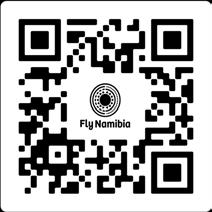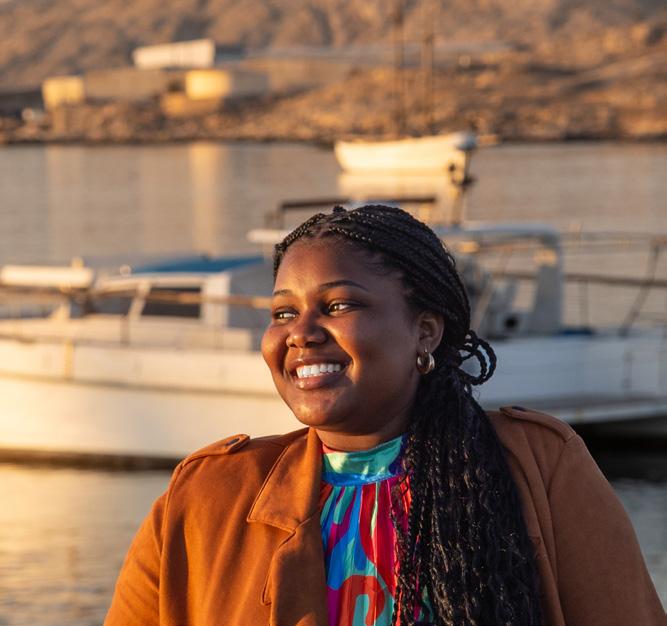

“There are times when solitude is better than society and silence is wiser than speech.”
Charles SpurgeonPhoto Stefan Redecker



“There are times when solitude is better than society and silence is wiser than speech.”
Charles SpurgeonPhoto Stefan Redecker

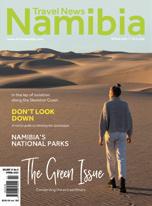

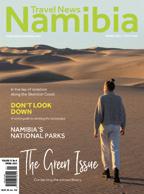


is published by Venture Media in Windhoek, Namibia www.thisisnamibia.com
Tel: +264 81 285 7450, Unit 1, Wasserberg Park, 1 Jan Jonker Road PO Box 21593, Windhoek, Namibia
EDITOR Elzanne McCulloch elzanne@venture.com.na
PRODUCTION & CONTENT MANAGER Le Roux van Schalkwyk leroux@venture.com.na
PUBLIC RELATIONS Elzanne McCulloch elzanne@venture.com.na

LAYOUT & DESIGN Liza de Klerk liza@venture.com.na
CUSTOMER SERVICE Bonn Nortjé bonn@venture.com.na

TEXT CONTRIBUTORS
Pompie Burger, Le Roux van Schalkwyk, Elzanne McCulloch, Helga Burger, Charene Labuschagne, Iga Motylska, Zan le Roux, Giraffe Conservation Foundation, Nina Mensing
PHOTOGRAPHERS
Elzanne McCulloch, Pompie Burger, Le Roux van Schalkwyk, Charene Labuschagne, Iga Motylska, Taryn Germishuizen, Zan le Roux, Willie Olivier, Giraffe Conservation Foundation, Nina Mensing, Eveline Suze
Travel News Namibia is published quarterly, distributed worldwide via Zinio digital newsstand and in physical format in southern Africa. The editorial content of TNN is contributed by the Venture Media team, freelance writers and journalists. It is the sole property of the publisher and no part of the magazine may be reproduced without written permission from the publisher.


All information and travel details are correct at the time of going to press. Due to uncertain circumstances, this may have changed after the date of publication. Please check businesses' individual websites for up-to-date details.
Industry partners:

They say once you have felt the sands of the Namib in your shoes, it is hard to leave. Nowhere is this truer than after a visit to Shipwreck Lodge on Namibia's iconic Skeleton Coast.
Cover image: Le Roux van Schalkwyk

To advertise in Travel News Namibia or any of our other publications, contact Elzanne McCulloch +264 81 367 3583 | elzanne@venture.com.na www.venture.com.na


Y

T
Venture Media is the pioneer of Namibia tourism promotion. We are the leader in spreading the tourism word around the world. We distribute accurate, credible, up to date and regular tourism-related information on paper, in social media, on the World Wide Web, and on mobile apps. We have reached hundreds of thousands over almost three decades. Be part of our community and let’s do it together.

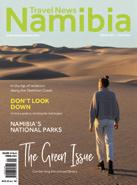
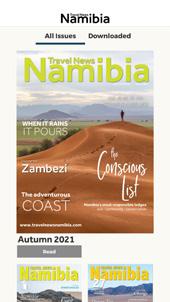

We focus on telling and sharing STORIES THAT MATTER across our various magazines and digital platforms. Join the journey and share your stories with audiences that understand and value why certain things matter.
Why ethical business, conservation, tourism, people and communities matter. How these elements interrelate and how we can bring about change, contribute to the world and support each other. Whether for an entire nation, an industry, a community, or even just an individual.
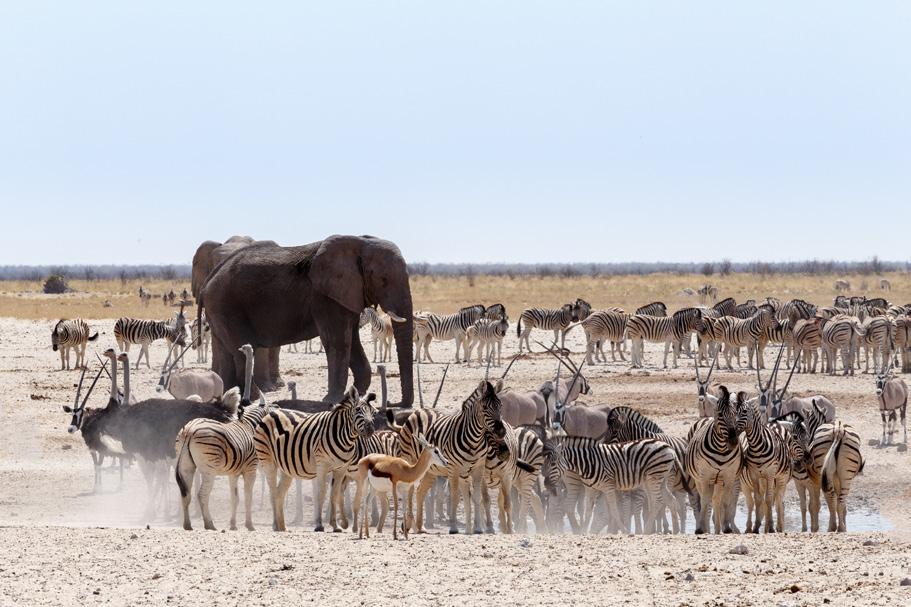
WWW.VENTURE.COM.NA or email us at info@venture.com.na for a curated proposal


stories that matter

FAST FACTS ON NAMIBIA

824,268 km²
INDEPENDENCE:
21 March 1990
CURRENT PRESIDENT: Hage Geingob
Secular state
SURFACE AREA: Windhoek CAPITAL: 90%
Multiparty parliament Democratic constitution Division of power between executive, legislature and judiciary Christian
ECONOMY
MAIN PRIVATE SECTORS:
Mining, Manufacturing, Fishing and Agriculture 46%
BIGGEST EMPLOYER:
Agriculture
MINING:
freedom of religion
FASTEST-GROWING SECTOR: Information Communication Industry
Diamonds, uranium, copper, lead, zinc, magnesium, cadmium, arsenic, pyrites, silver, gold, lithium minerals, dimension stones (granite, marble, blue sodalite) and many semiprecious stones
MONEY MATTERS
CURRENCY:
The Namibia Dollar (N$) is fixed to and on par with the SA Rand. The South African Rand is also legal tender.
Foreign currency, international Visa, MasterCard, American Express and Diners Club credit cards are accepted.
TAX AND CUSTOMS
NATURE RESERVES: of surface area
ROADS:
bitumen
8400km
HIGHEST MOUNTAIN: Brandberg
ENQUIRIES: Ministry of Finance
Tel (+264 61) 23 0773 in Windhoek
20% 14 400 680
OTHER PROMINENT MOUNTAINS: vegetation zones species of trees
Spitzkoppe, Moltkeblick, Gamsberg
PERENNIAL RIVERS: Orange, Kunene, Okavango, Zambezi and Kwando/Linyanti/Chobe
EPHEMERAL RIVERS: Numerous, including Fish, Kuiseb, Swakop and Ugab
HARBOURS: Walvis Bay, Lüderitz
MAIN AIRPORTS: Hosea Kutako International Airport, Eros Airport
RAIL NETWORK:
6.2 telephone lines per 100 inhabitants
ENDEMIC plant species 120+ species of lichen LIVING FOSSIL PLANT: Welwitschia mirabilis
BIG GAME: Elephant, lion, rhino, buffalo, cheetah, leopard, giraffe
20 antelope species
250 mammal species (14 endemic)
256
50 reptile species
2,382 km narrow gauge
TELECOMMUNICATIONS: Direct-dialling facilities to 221 countries
MOBILE COMMUNICATION SYSTEM:
4 0.4182 medical doctor per 1,000 people privately run hospitals in Windhoek with intensive-care units
Medical practitioners (world standard) 24-hour medical emergency services
699
frog species 15%
Public transport is NOT available to all tourist destinations in Namibia.
There are bus services from Windhoek to Swakopmund as well as Cape Town/Johannesburg/Vic Falls.
Namibia’s main railway line runs from the South African border, connecting Windhoek to Swakopmund in the west and Tsumeb in the north.
There is an extensive network of international and regional flights from Windhoek and domestic charters to all destinations.
bird species
ENDEMIC BIRDS including Herero Chat, Rockrunner, Damara Tern, Monteiro’s Hornbill and Dune Lark
DRINKING WATER TIME ZONES
Most tap water is purified and safe to drink. Visitors should exercise caution in rural areas. GMT + 2 hours
220 volts AC, 50hz, with outlets for round three-pin type plugs
2.6 million DENSITY: 3 per km²
461 000 inhabitants in Windhoek (15% of total)
ADULT
OFFICIAL LANGUAGE:
English
14 regions
13 ethnic cultures
16 languages and dialects
LITERACY RATE: 1.8% POPULATION GROWTH RATE:
92%
EDUCATIONAL INSTITUTIONS: over 1,900 schools, various vocational and tertiary institutions
FOREIGN REPRESENTATION
More than 50 countries have Namibian consular or embassy representation in Windhoek.

was sitting on a grassy knoll overlooking a sea loch, drinking a cup of coffee. The water mass in question, Loch Eriboll, stretches to the north to meet the stormy seas of Cape Wrath and the Pentland Firth in the North Sea. The north coast of Scotland, along which my husband and I ventured for five days, is a world away from our dry corner of the earth, yet familiar in some strange sense. Déjà vu was a common sensation as we drove slowly along bumpy tracks. We felt comfortable here, a sense of familiarity despite the fact that we had never been here before. The rolling green pastures dotted with sheep somehow not too far removed from the view of savanna grasslands dotted with springbok. The mountains and valleys, with misty banks overhead, a polarity to the dunes and pans beneath a bright blue sky back home in Namibia. Opposites, yet in some strange way reminiscent of one another.
“Same same, but different,” is the phrase that comes to mind. What is it in this verdant northern land that causes this sense of recognition within us? The coffee tastes much the same as my Slowtown would back in Windhoek. The massive watery expanse of the loch is foreign, though. Such expanses of water are few and far between in Namibia. In the north of Scotland a new loch or firth awaits around every bend of the windy single-track roads. That’s another difference. Our roads are wide and arrow-straight, disappearing before you as it melts into the horizon. Not the curving paths of Scotland’s North Coast 500. Yet it all feels too familiar for me to shake. The lady who makes our coffee chats away with Sean in her Scottish brogue, our ears straining to absorb the words as her story ebbs and flows with the lilt of the world’s most wonderful accent. “How’s the weather for the rest of the week?” Sean asks. “Don’ pay that much mind,” she replies. “I look oot the windo’ each mornin’ and decide whether I’m makin’ soup or scones.” As she imparts her meteorological wisdom, I follow her gaze to the rugged mountainside that is the backdrop to her small cottage. It runs adjacent to the loch and its wild hills look wonderfully ominous and untamed.
There it is, I realise. It’s the wild. This land is wild and untamed. There is a feeling about the wilderness that calls to the intrepid adventurer and the nature-lover’s heart. Along this wild route with its green stretches and tumultuous coastline, we have found the same unbridled sense of freedom and adventure one finds in the vast expanses of Namibia’s hinterlands. They are a dichotomy of visual experiences, but they share the same wild soul. No wonder
II felt so much at home there. Our souls recognised one another. The rural roads and small villages. The beguiling small-town people and their coffee shops in the middle of nowhere, selling homemade delicacies and treats iconic to the locale. The beauty of great expanses of nothing. Nature, the star of the show.
Back home in Namibia I am elated to realise that my muchanticipated holiday had hit the mark. I return to the bushlands and dry winter of my homeland with a collection of splendid bright green memories of new experiences. I carry with me our loch-side drives and forest walks to waterfalls. Our clamber down a coastal cliff to spot the elusive Puffin, and up mountainsides to see a single deer. Our cold beers, fish and chips and Sunday roasts, enjoyed in local pubs. That’s what travel is all about. Broadening your horizons and meeting new people. It is a collecting of experiences that leave you speechless and then turns you into a storyteller. And I am so excited for travellers to Namibia and all they are yet to discover. The memories that wait to be made. My latest travels remind me of the power of discovering new places and finding pieces of yourself along the way. Whether it is the verdant northern coastline of Scotia or the ochre-coloured sandy mountains of the Namib Sand Sea, new discoveries await those who are brave enough to step into the unknown and let their wanderlust lead them across this magnificent world.
In this Spring issue of Travel News Namibia, which we have labelled The Green Issue, our team and wonderful freelance writers showcase the splendours of Namibia through their own experiences. They meet the small-town people and their roadside coffee shops and clamber up mountains. They explore the wilderness of our own tumultuous Skeleton Coast and share tales of linking adventure and species in need of protection. We discover Namibia’s landscape-level conservation success across national parks and conservation areas that span almost 46% of the country. Because when it comes down to it, it is the wilderness that calls and makes destinations such as ours so magnificent.
We hope our wild soul speaks to yours.
With love from Namibia,
Elzanne McCulloch @elzanne_mcculloch
7000 KM ACROSS NAMIBIA p14
stretching from the Zambezi Region to the Orange River
DON’T LOOK DOWN p38
A novice guide to climbing the Spitzkoppe
NAMIBIA’S NATIONAL PARKS p42
Conserving the extraordinary National Parks of Namibia
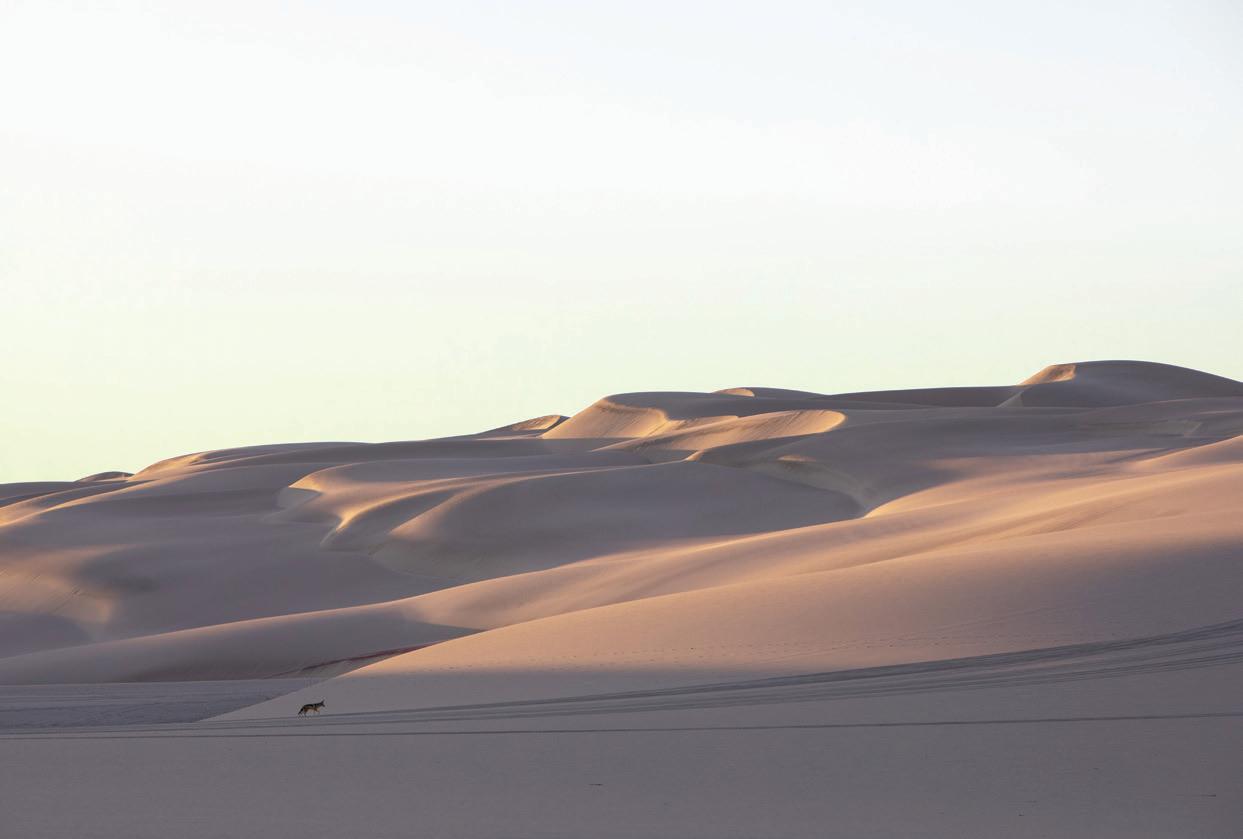
WINGS OVER THE ZAMBEZI p70
Birding with Pompie at Kubu and Kwena
Experiencing Shipwreck Lodge in the Skeleton Coast National Park

Have you ever seen the incredible birdlife in the Zambezi Region of Namibia? Felt the waves of a hippo popping up next to your boat? Ate a water lily? Or showered in the mist of the mighty Victoria Falls?
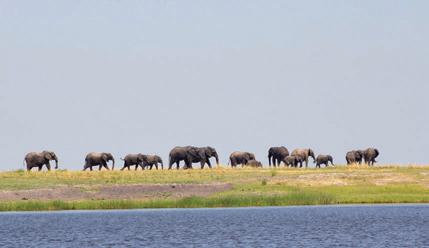
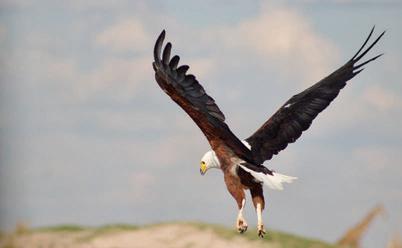
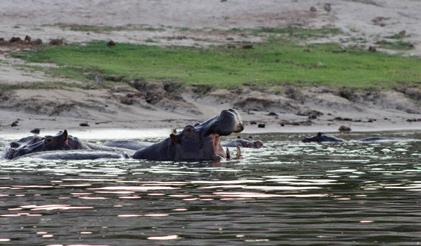
Our podcast host Katja is travelling with FlyNamibia from Eros Airport to Katima Mulilo. While still in the air, the landscapes are changing, and Namibia is getting greener by the minute. On arrival in Katima she says: ‘As I set foot in the Zambezi Region, I was mesmerized. Amazed by how time has a different meaning up here. There are endless opportunities to explore the area in and around Katima Mulilo or the different national parks in Namibia, visit Chobe National Park in Botswana, or head to the Victoria Falls in Zambia.’
With her microphone always on hand she sets off to see what this region has to offer: Tasting the famous Zambezi Bream on the Katima Open Market, enjoying a sunset cruise on the Chobe River while watching the elephants taking a dip in the water, visiting the surrounding villages and communities and understanding how the world up here is different to the rest of
Namibia. Katja meets and listens to the stories of the people living in ‘Africa’s Eden’. And we want to share these stories with you through our podcast: ‘Namibia hören’


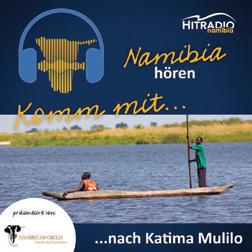

In our podcast, we look behind the scenes of the most exciting places. And we meet people who care deeply about this country. Discover Namibia with us and share our love for this beautiful land.

We showcase our unique natural environment and tell you about Namibia’s conservation. We answer questions how charcoal or beer made in Namibia finds its way to foreign markets. What makes kapana or Zambezi bream so special? Or what role sports, music, and politics play here. In short, we take you on a journey through Namibia.

Want to join the world of Namibian wonders and beauties? Simply tune in to Hitradio Namibia’s podcast ‘Namibia hören’.
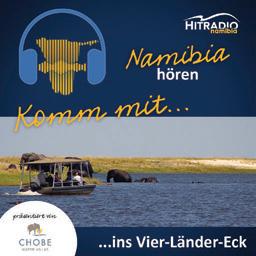
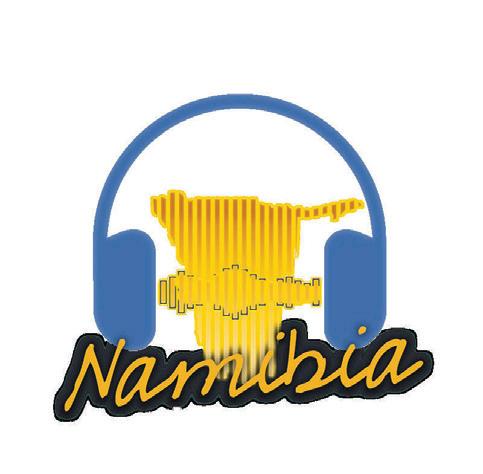
10 BUSH TELEGRAPH News from the tourism industry
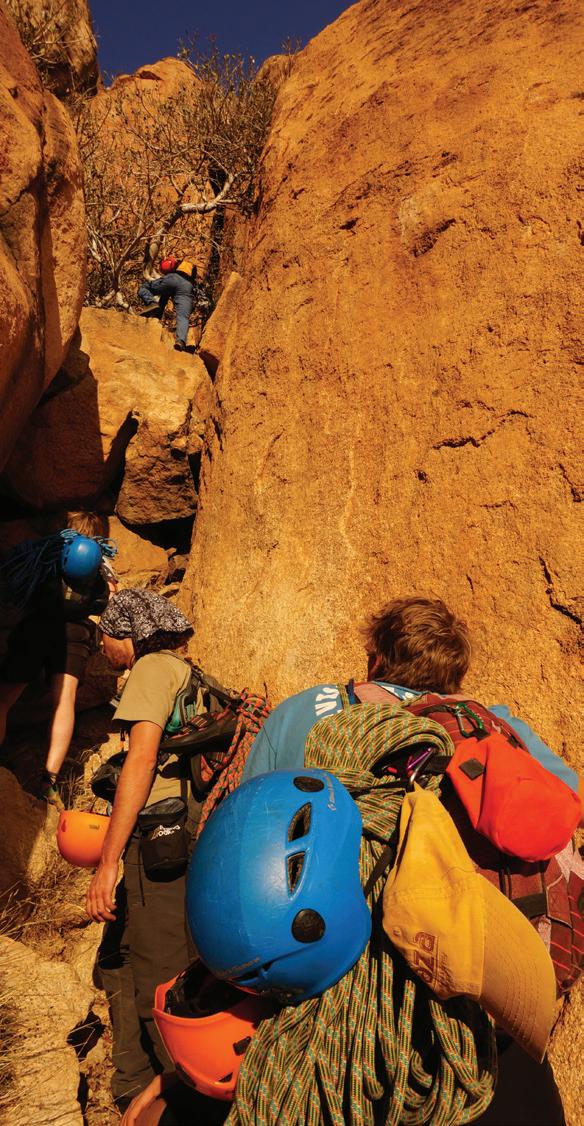
20 UNCOVERING OMBONDE PEOPLE’S PARK Community-driven transformation
22 THE DAWN OF A NEW TRAVELLER Namibia’s Digital Nomad Visa
27 BILTONGPLAAS taste of homemade delights down south
35 CHECKLIST Discovering Namibia’s Shipwrecks
36 HOMECOMING TO FANCY FRITZ Capturing the styleful essence of Swakopmund
49 THE TNN PLAYLIST Beats for Atlantic Coastin’
51 NAMIBIA’S MOST endangered species

52 PEDALLING FOR A PURPOSE The RMB & Wilderness Ride for Rhinos 2023
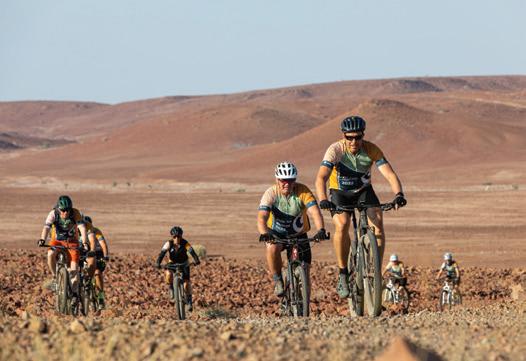
56 THE CYMOT MUSEUM Celebrating 75 years of a Namibian icon
58 TREES OF THE NORTHEAST get to know the Shephard’s Tree
60 CONSERVATION BEYOND GIRAFFE Enhancing capacities and empowering young African wildlife veterinarians
64 PETRIFIED FOREST COFFEE SHOP An authentic travel experience
66 A FAMILY SOJOURN TO SOSSUSVLEI Stitching together the tapestry of memory
76 KALAHARI RED DUNES LODGE Setting the tone with Toto’s “Africa”
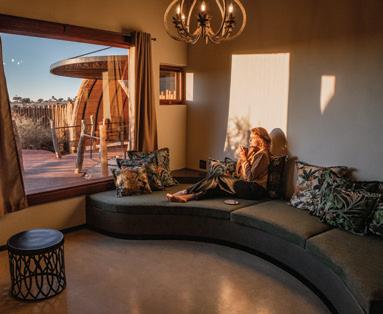
78 THE CHARM OF LÜDERITZ Oysters, architecture and history
84 TRAINING BIG GREY THINGS PAVLOVIAN-STYLE The Kunene Elephant Walk project team training in Tanzania
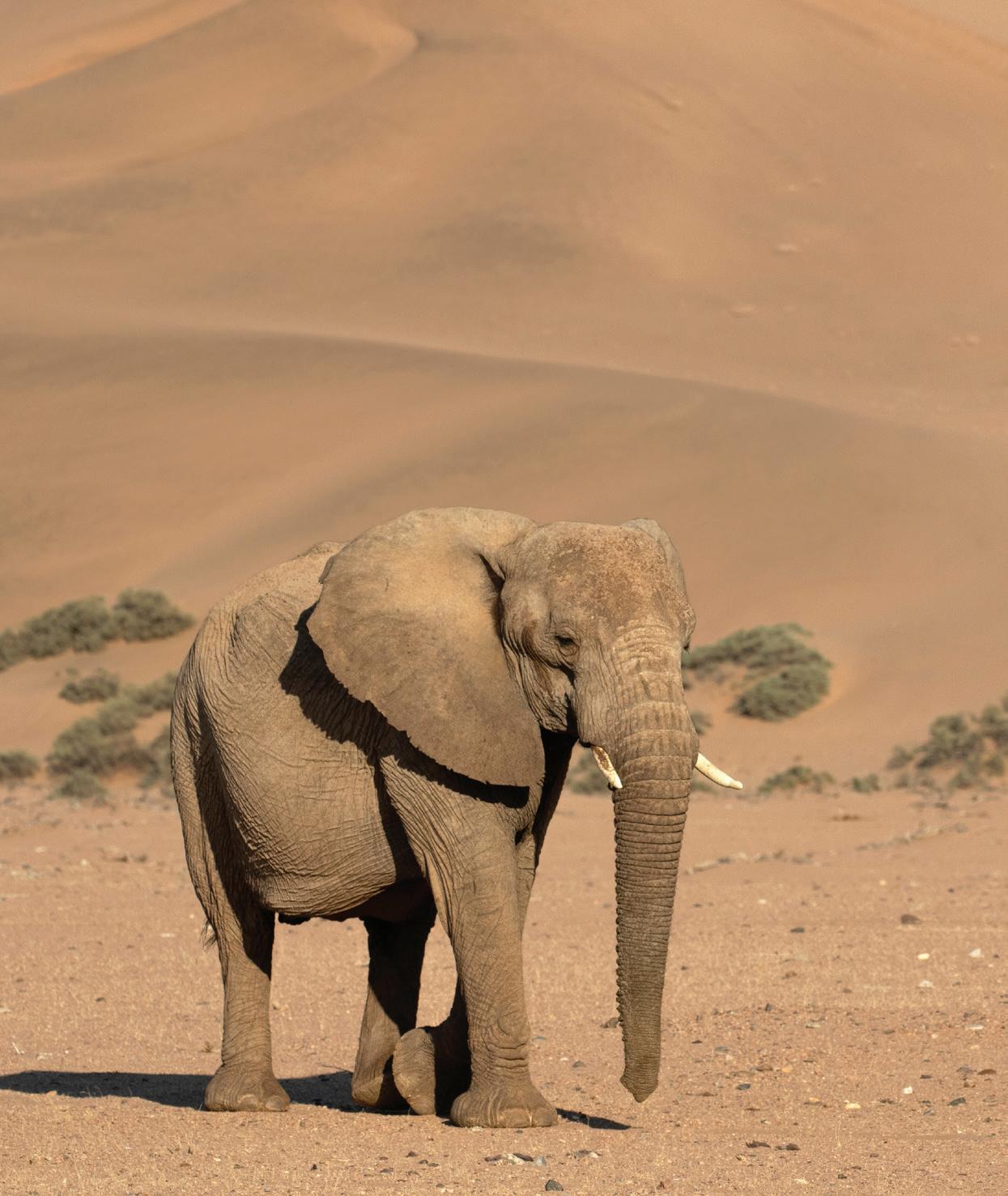
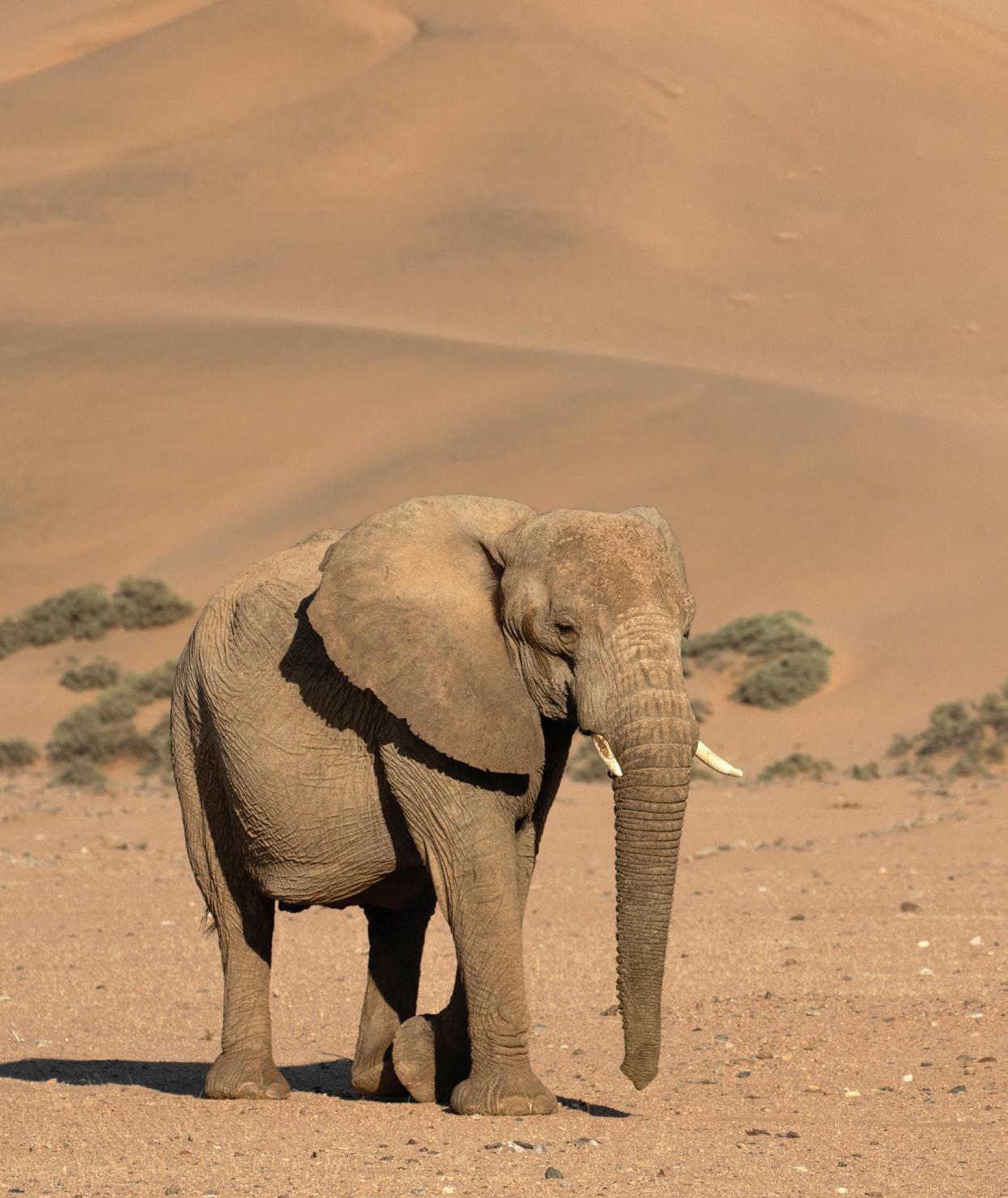
The HAN AGM & Congress hosted in May 2023 was a resounding success, uniting participants from the realms of training and tourism in a dynamic exploration of the theme “Co-creation of a tourism training road map”. Over the course of two eventful days, lively discussions and insightful exchanges of ideas took place, emphasising the significance of skills development for a thriving tourism and service industry. The event showcased HAN’s unwavering dedication to uplifting communities and promoting progress within the sector. The newly elected HAN executive team for the period 2023-2025 was also announced. Congratulations to the incoming team, led by Ally Karaerua as the HAN national chairperson. According to Gitta Paetzold, CEO of HAN, the team remains committed to maintaining an open-door policy, encouraging members to engage actively in shaping the future of tourism.
Wilderness, one of Africa’s foremost destination management and sustainable luxury travel operators, has ushered in a fresh era with the appointment of Alex Henderson as its new managing director for Namibia. Stepping into this pivotal role, Alex assumes responsibility from Alexandra Margull, who now assumes the position of Group COO. Hailing from Maun, Botswana, where he held the position of director of flight operations, Alex brings a wealth of expertise and a deep passion for the travel industry. His leadership promises to steer Wilderness Namibia into an exciting new chapter, with a focus on innovation and exceptional guest experiences. We extend a warm welcome to Alex and wish him success in charting a dynamic course for the company’s future.

AviaDev Africa, a leading platform dedicated to enhancing connectivity across the African continent, has made an exciting announcement for travel enthusiasts and aviation professionals alike. Its annual event will take place in Windhoek in June 2024 and will be hosted by the Namibia Airports Company.
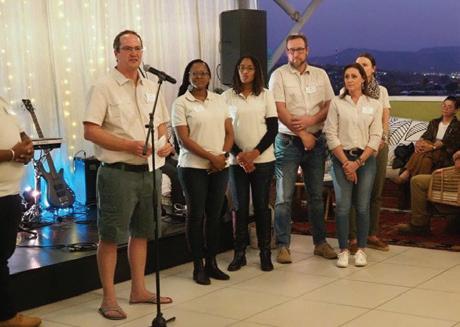
This prestigious forum brings together influential stakeholders from airlines, airports, tourism boards, government officials and industry experts to foster collaboration and strategic partnerships that will create new air routes across Africa. AviaDev Africa is renowned for its ability to cultivate a conducive environment for networking and innovative discussions aimed at driving sustainable air connectivity.
Choosing Windhoek as the host city for the 2024 event underscores Namibia’s growing importance as an aviation destination and its commitment to bolstering regional connectivity. Bisey /Uirab, CEO of the Namibia Airports Company, expressed his enthusiasm about hosting AviaDev Africa and welcoming industry leaders to experience the wonders of Namibia for both business and leisure. The event promises to explore untapped opportunities that will fuel the growth of air connectivity across the continent. In a statement, Jon Howell, CEO of AviaDev, emphasised the platform’s broader goal of fostering collaboration and inspiring innovation within the aviation industry. AviaDev Africa serves as an ideal avenue to showcase Namibia’s immense potential and drive its sustainable tourism growth.
FlyNamibia, the country’s first privately owned scheduled passenger airline, recently launched its highly anticipated new route, connecting Windhoek’s Eros Airport to the picturesque coastal town of Lüderitz. This exciting addition to their route network, made possible through a strategic partnership with TotalEnergies EP Namibia, demonstrates both companies’ commitment to fostering Namibia’s development while improving connectivity to the southwest. The inaugural flight on 3 July 2023 marked a significant milestone for FlyNamibia and the Namibian aviation industry, offering seamless access to Lüderitz’s burgeoning economic potential and abundant tourist offerings. With its colonial-era architecture, ruggedly beautiful landscapes and captivating Kolmanskop ghost town, Lüderitz attracts visitors from across the globe, and FlyNamibia’s new route ensures quick and comfortable travel to this southern gem. Operating every weekday, FlyNamibia’s exceptional service promises an unforgettable journey for all travellers, catering to leisure and business needs alike.
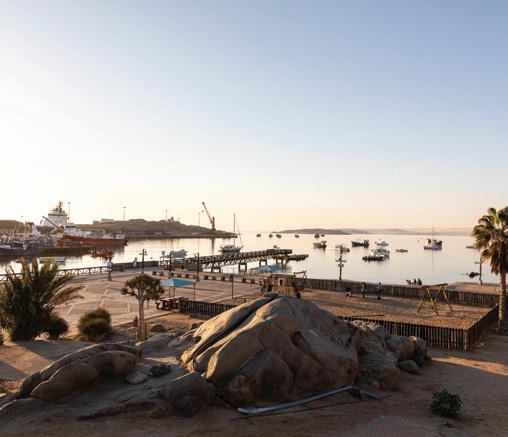
Erongo Wild Lodge, near Omaruru, has undergone some changes and will, as of 1 August 2023, trade under the name of Ondudu Safari Lodge. Ondudu means “rocky mountains”, which perfectly captures the setting and surroundings of the lodge. The lodge will continue to provide the same high level of service offered by Erongo Wild, previously also known as Erongo Wilderness. Bookings for Ondudu can be made at res7@journeysnamibia. com and 061 228104. The team at Ondudu Safari Lodge looks forward to hosting you soon!
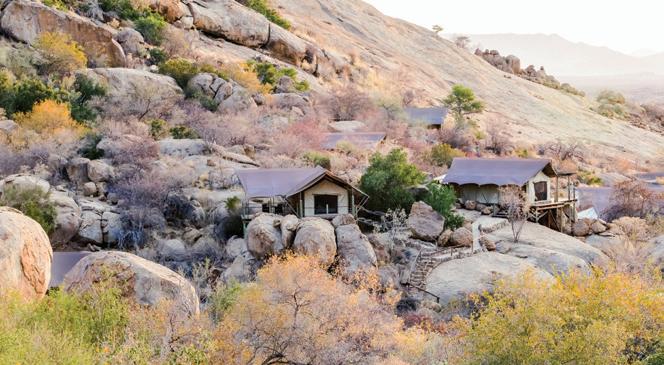
The Mushara Collection, 8 km from the Von Lindequist gate of eastern Etosha National Park, will be welcoming Johan Fourie as its new Managing Director as from 1 September 2023. Johan is well-known in Namibia's tourism sector with a background in conservation with MEFT, working abroad and then nearly two decades with Wilderness. Johan’s better half, Jennifer, will be taking on the role of Service and Standards Manager, adding her own wealth of experience. The stage is set for a grand new adventure for the Fourie family at Mushara. We congratulate Mushara on the wonderful new additions to their team, and wish the Fourie’s all the best on this new journey.
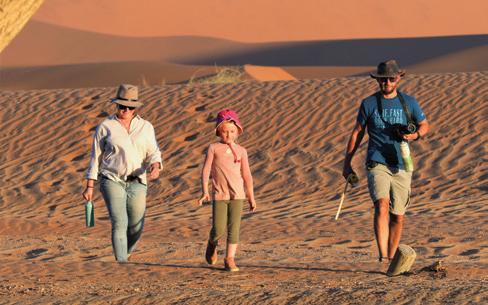
Under the able leadership of the Deputy Minister of Environment, Forestry and Tourism, Hon. Heather Sibungo, Namibia achieved a significant milestone in the global tourism arena. The country recently participated in the 66th United Nations World Tourism Organisation (UNWTO) Commission for Africa (CAF) held in Mauritius, where it successfully mobilised support and was elected as a member of the prestigious UNWTO Executive Council. This achievement is being celebrated as a momentous occasion for Namibia and its burgeoning tourism sector.
The UNWTO Executive Council serves as the governing body of the UNWTO, playing a crucial role in setting budgets, prioritising programmes, and implementing activities aimed at utilising tourism as an effective development tool. Through technical assistance projects, the Executive Council aims to foster growth and progress in member countries across the globe.
Namibia’s election to this esteemed council aligns perfectly with the country’s national growth plans, development agenda and recovery strategy. By gaining a seat at the table, Namibia seeks to seize opportunities and maximise the benefits derived from
the global tourism market. This achievement is set to facilitate improved market knowledge, enhanced competitiveness, the formulation of sustainable tourism policies and instruments, as well as comprehensive tourism education and training initiatives for both the sector and the nation’s citizens.
Namibia’s commitment to the UNWTO Executive Council reflects its dedication to responsible and sustainable tourism practices, positioning the country as a key player in the global tourism landscape. This accomplishment signifies a promising step towards a prosperous and thriving future for Namibia’s tourism industry and its people. TNN
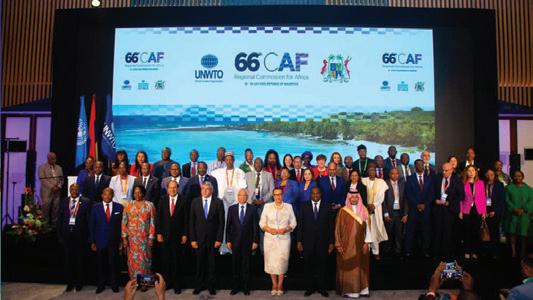

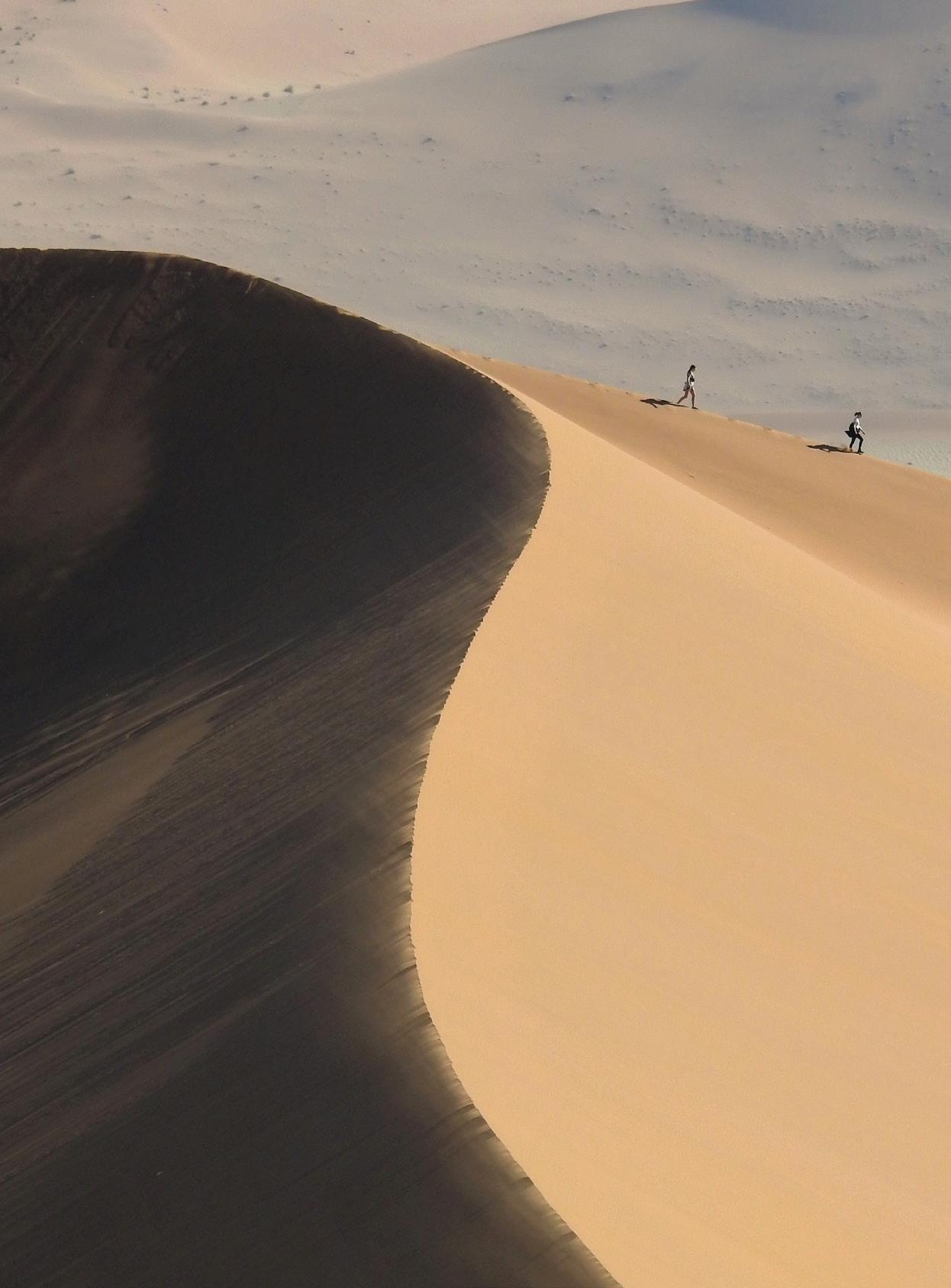
For his 60th birthday, Iga Motylska took her father on a month-long, 7000 km road trip around Namibia. Their tyre tracks stretched from the Zambezi Region to the Orange River and at times saw them sleeping in the back of his converted Landy.
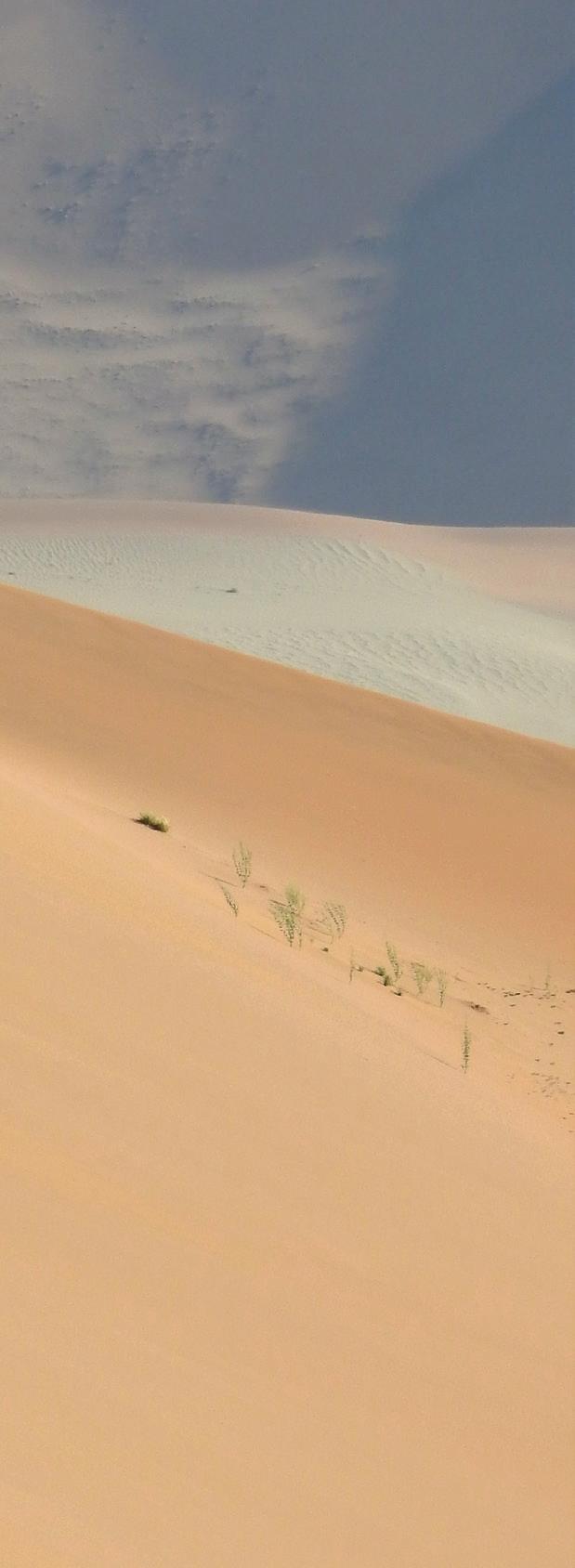 Text
Text
Despite what your English high school teacher might have told you, not every story begins at the very beginning. Particularly not this one. This one begins slap-bang in the middle of our month-long, 7000 km, father-daughter road trip across Namibia. It also begins on the side of a gravel road somewhere in Skeleton Coast National Park.
I am squinting into the distance, trying to make out whether that is the Atlantic swimming on the edge of the Earth. It is only later, as we get closer, that I realise it is a misty mirage of ocean air mingling with a dehydrated desert draft to create a condensation swirl that hangs heavy on the horizon.
My father is cranking the car jack. This is the second tyre we are changing in less than a week. And when I say ‘we’, I mean ‘he’ because his MacGyver-like resourcefulness would definitely see him picked first in Survivor. I know the drill by now and prop three large rocks against the remaining tyres. And although I ask a number of times if there is anything I can do to make myself useful, my work here is done. Instead, I resort to looking out for the desert-adapted lions that the sign at the gate warned us about. You would think they’d be easy enough to distinguish against the barren landscape (should they happen to be within our vicinity in the 17 000 km2 park), but alas, we are not that lucky.
Before you judge me too harshly, he is in charge of navigating and all things car-related, while I have taken the wheel in planning our cross-country trek down to a T, with enough flexibility for spontaneous detours – and the occasional tyre change.
It is tradition that I treat tatuś (the diminutive form of ‘father’ in Polish) – to an annual birthday trip. And the big 6-0 had to surpass our previous trips. Though top of his list, Namibia had always eluded him. We traced an itinerary onto a map a number of times, but somehow responsibilities elbowed their way into reality. For all those times we said we would, but didn’t, this time we went all out.
The plan was to explore as much of Namibia as time would allow. As we hopscotched around the country, we learned fairly early into our trip that distances in Namibia are measured in time rather than kilometres. Our tyre tracks stretched from the Zambezi Region to the Orange River. Our adventure saw us stay in some of the country’s most luxurious lodges, in familyrun guesthouses in the-middle-of-nowhere, a hostel and at camp sites in the back of his converted Landy with our supplies ‘Jenga-ed’ on the roof rack.
Tatuś drove his trusty Land Rover Discovery 4 to Namibia from Johannesburg via Botswana, while I flew into Hosea Kutako International Airport from Cape Town. The following days were spent indulging in eco-conscious experiences at Habitas Namibia.
Once rejuvenated, Windhoek was our springboard into the waterscapes of the Zambezi Region. Shortly after our FlyNamibia flight to Katima Mulilo, we floated along sections of the 450-km panhandle amidst wetlands and marshes in search of game and birds. For those few days, life revolved around water, offering a stark contrast to what many believe Namibia to be.
Back in the capital, we made a beeline towards Spitzkoppe’s granite peaks, arch-like Bridge and San rock art – home to the most spectacular camp site location we have stayed at. The White Lady welcomed us to Brandberg and pointed us in the direction of the Organ Pipes and one of the largest collections of petroglyphs in Africa at the Twyfelfontein UNESCO World Heritage Site.
It is tradition that I treat tatuś (the diminutive form of ‘father’ in Polish) –to an annual birthday trip. And the big 6-0 had to surpass our previous trips.
During our stay at Wilderness Desert Rhino Camp in the Palmwag Concession, we had the privilege of tracking the world’s largest population of free-roaming desert-adapted rhinos – alongside members of Save The Rhino Trust, who protect the 25 000 km2 concession. Next, a photographic safari took us along the Huab River Valley in Damaraland to watch a herd of desert-dwelling elephants saunter towards the next waterpoint.
And that was when our eventful introduction to the Skeleton Coast started. We conjured optical illusions on the salt flats, explored the abandoned mining sites and were humbled by nature’s might at the sight of the remains of countless illfated ships.
Then the coastal road spat us out in Namibia’s playground, where our day began with a flight with Hot Air Ballooning Namibia as the sun bathed the Rössing Mountains in morning light. Our days in Swakopmund were filled with sandboarding, fat-tyre e-biking along dune crests and living desert tours in search of lesser-seen critters.
Next, we hopped, skipped and jumped from Walvis Bay to the apple-pie capital of Solitaire and onwards to NamibNaukluft National Park. Photographs cannot convey the dimensions of the star-shaped dunes at Sossusvlei. It was only as we were standing before them that we wondered how the heck one scrambles to the 360-metre summit of Big Daddy. From atop the world’s highest sand dune, camelthorn skeletons danced with the sun across the white clay of Deadvlei. We bade the day farewell during a 45-minute sunset flight over the desertscape. Without him having to tell me, my father’s highlight was sitting next to the Desert Air pilot in our Cessna 210.
FlyNamibia has daily Safari Circuit flights that connect Windhoek to Sossusvlei and Etosha National Park, with onward flights from Sossusvlei to Swakopmund. The airline operates weekly flights to Ondangwa, Rundu, Katima Mulilo, Lüderitz and Oranjemund. Domestic and chartered flights depart from Eros Airport in Windhoek.
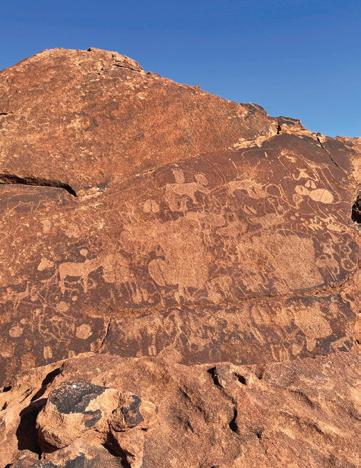


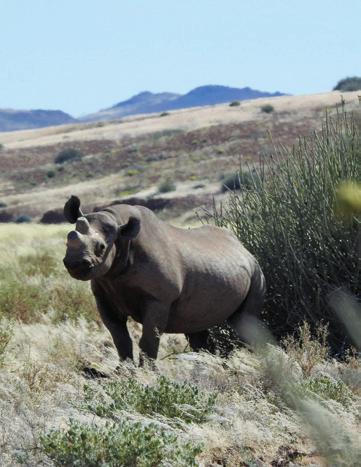
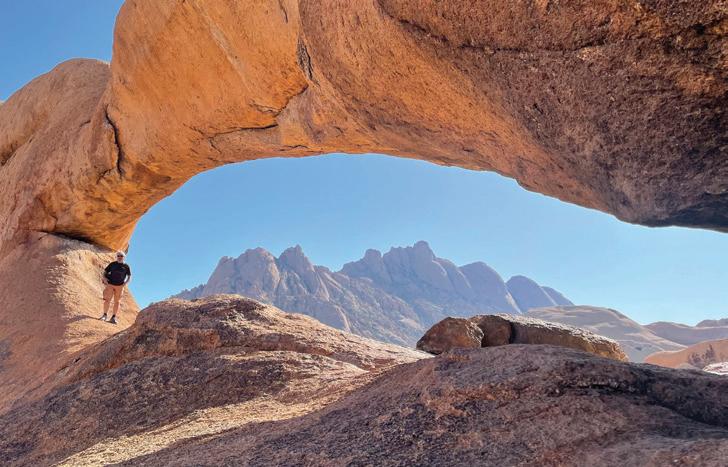 Water lilies on the Zambezi
Twyfelfontein rock engravings
The Rock Arch at the Spitzkoppe
Black Rhino
Water lilies on the Zambezi
Twyfelfontein rock engravings
The Rock Arch at the Spitzkoppe
Black Rhino
Book the DBB option: Consider booking a dinner, bed and breakfast (DBB) package, especially in remote areas where dining options are scarce.
Loyalty pays off: When booking multiple stays across the country with the same travel partner, ask about discounts, rewards and loyalty benefits.
Home sweet home: Renting a home on the Atlantic coastline is often more affordable and spacious than a hotel.
The whole package: DMCs offer set or tailor-made itineraries to suit your budget, travel style and interests, often at a more affordable cost than what independent travellers might find.

Rent a car: For groups, renting a car is a cost-effective alternative to taking (or chartering) a flight. A reliable 4x4 with air-conditioning is recommended. Book as soon as your travel plans are confirmed as the limited number of rentals disappear quickly during peak season.
Shuttle: McClunes Shuttle Service runs daily shuttles from Windhoek to Swakopmund and Walvis Bay.

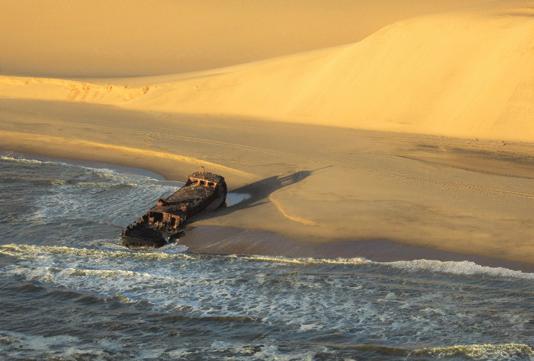
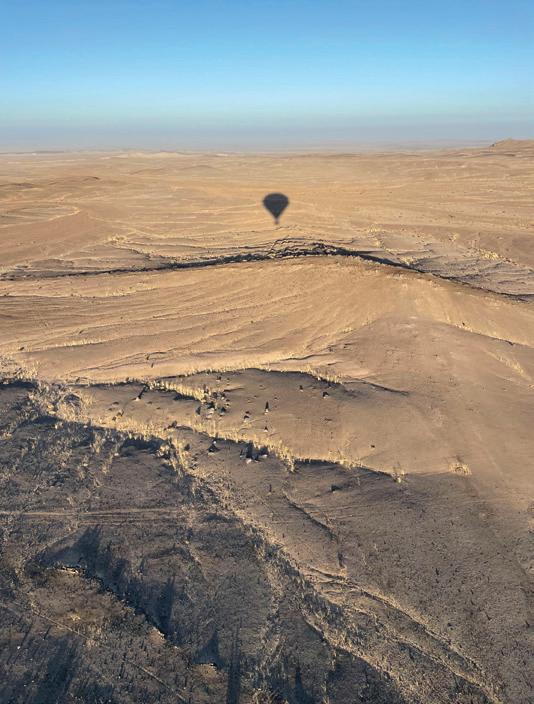 Shawnee Shipwreck
Dancing White Lady Spider
Shawnee Shipwreck
Dancing White Lady Spider
Resources: The ‘DriveNam’ Facebook Group is an invaluable online community where you can ask about the best, quickest, most picturesque driving routes. It posts updates about border crossings and driving permits. Download the Maps.me smartphone app for offline maps.
Check roads: Gravel roads are tricky to navigate and brakes respond differently to how they do on tarred roads. Before setting off, inquire about road conditions, especially after the seasonal rains. Certain parts of the Zambezi Region may only be accessible by boat during this time.
Avoid driving at night: Outside the main towns, roads are unlit and run through unfenced wildlife corridors, where nocturnal animals roam freely. You also don’t want to break down in ‘the middle of nowhere’ after sundown.
Stick to marked roads: While Namibia's landscapes may seem desolate and uninhabited, cars damage these delicate ecosystems, hamper rehabilitation efforts and leave scars for hundreds of years. Protect the environment by sticking to marked roads.
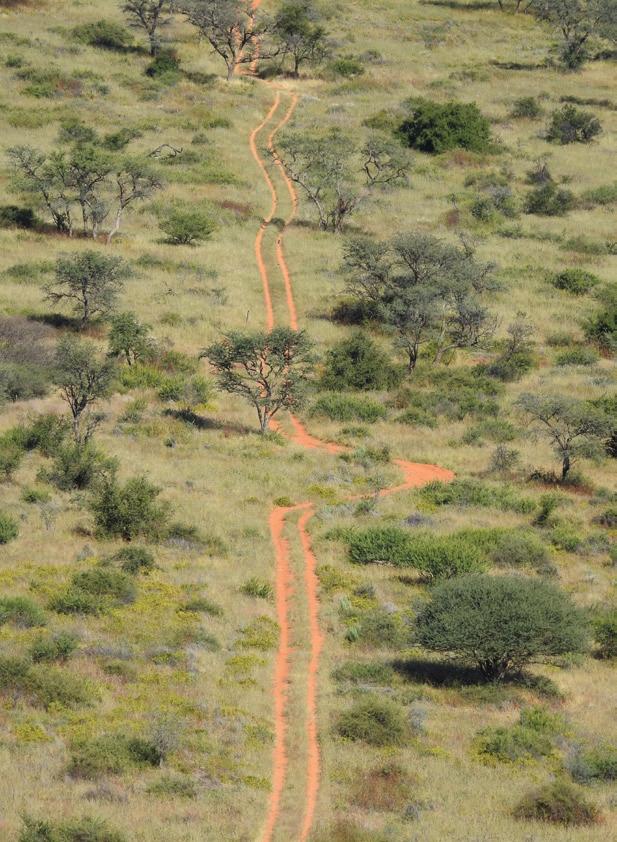
Come prepared: Pack spare tyres and repair kits, sufficient drinking water and extra fuel, especially during peak season when remote petrol stations may temporarily run out of fuel. In distant locations petrol stations are few and far between, so it is best to fill your tank and jerry can whenever possible. Some of them only accept cash. Don’t forget to pack your padkos
The sky at NamibRand Nature Reserve unfurled to reveal why it is Africa's first (and one of only two) Dark Sky Nature Reserves. The minimal light pollution in these remote parts make it an enviable location for astro-tourism. It was tatuś who woke before 4 am to witness the lunar eclipse with an astronomer at the nearby &Beyond Sossusvlei Desert Lodge in their observatory.
We were told to have our cameras at the ready as the C13 to Aus is said to be one of Namibia’s most scenic roads. Aus spoiled us with multiple sightings of the wild horses of the Namib, though we failed to find any alluvial diamonds at Kolmanskop ghost town. Instead we cheered our wealth of experiences with Lüderitz oysters washed down with a Hansa.
Long after returning to Cape Town, I was still shaking sand from my shoes – a reminder that I took home grains of sand from the world’s oldest desert. They have been fashioned from rock in slow motion, with nature as the artist that has shaped the land into an ever-changing, abstract sculpture. TNN
 Habitas Namibia
Habitas Namibia
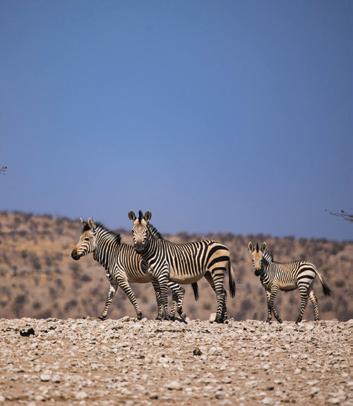
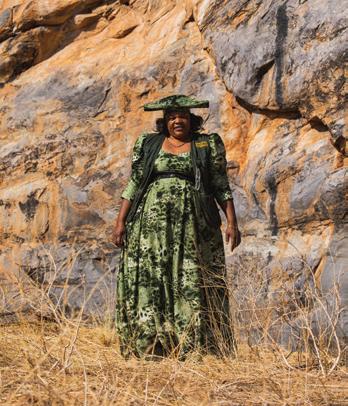

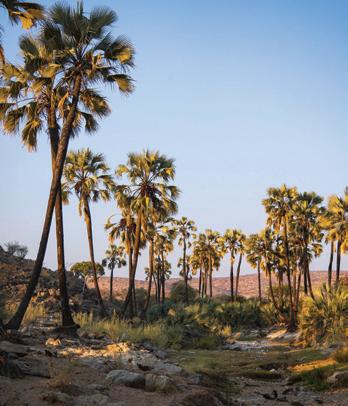



Home to a cluster of community conservancies collectively known as the Erongo-Kunene Community Conservation Area, the area offers authentic, untapped wilderness. Among these conservancies are EhiRovipuka and Omatendeka, whose respective Otjiherero communities have joined forces and resources to establish Ombonde People’s Park (OPP). While at present it is a park in the making – pending the green-light gazetting of the Namibian government – OPP will soon be ready to welcome the adventurous, off-the-beaten-path traveller.
As the guests of the soon-to-be-proclaimed OPP and their spokespeople, Travel News Namibia was invited to experience this landscape, visit future lodge and camping sites, and dip our toes into the next big thing for sustainable Namibian tourism. In fact, after spending time in the field and hearing the stories and aspirations of this patriotic community, this author is delighted to report that the park, in its prime, may showcase the most dynamic bridge between tradition and innovation.
The area of Ombonde, which is Otjiherero for camelthorn tree, covers 3,599 km² of semi-arid and arid landscapes. Varying in typography and geology, the park boasts some of the most scenic savannah woodlands, river valleys, hills and plains you could imagine.
Deep riverbeds occasionally form canyons of two-storeyhigh banks laced with the root systems of mopane, ana and leadwood trees, the bulges and lines on their trunks telling us stories of ancient times. Boulders made up of mosaic stones –fist-sized ochre-coloured rocks held together by finer sediment – offer a vantage point from which the plains can be viewed with dizzying wonder. At the base of a rock gorge that would send climbers and hikers into a frenzy, we look up to evergreen trees that polka-dot the rugged escarpment, growing at abstract angles against the odds of this arid place. The people of Ombonde are bound to this sacred land, knowing that their journey to explore its possibilities has only just begun.
For these communities – as with so many others across Namibia – wealth, cultural heritage and pride have long been associated with livestock such as goats and cattle. Ombonde People’s Park (OPP) recognises the importance of safeguarding these beliefs and heritage while simultaneously introducing new ideals. It seeks to showcase the endless opportunities that can arise from tourism, wildlife protection and the appreciation of valuable natural resources.
The population of the Ehi-Rovipuka and Omatendeka conservancies amount to 4,173 people, whose representatives wish to fulfil an inclusive developmental role to uplift the socio-economic standing of their beloved people. Dubbed a “people’s park”, the fundamental vision for Ombonde is putting the power back in the people’s hands, because ultimately they understand, live, breathe and exist in this land, and they bear its best interest at heart.
OPP holds a strong team of local governance who, in collaboration with IRDNC and GIZ, have the task to draw up management plans, conduct necessary meetings to resolve issues on the ground, and prepare financial reports to remain profitable and sustainable. Once the paperwork has fallen into place, it is this team that will drive the management, maintenance and operational activities in the park, including park entry fees and local guides.
From a traveller’s perspective, the outlook of exciting new camping spots and higher-end lodges remains hopeful. OPP’s team understand the aesthetics of pitching a tent on a riverbank or under a large-top acacia, as well as the endless vistas and comforts of a hill-top lodge with all the amenities.
With unwavering determination, the communities of EhiRovipuka and Omatendeka seek to create a park where visitors can witness the harmonious coexistence of humans, wildlife and nature. One where present and future generations of the Herero and Himba people can honour tradition and share their unique homeland with visitors. TNN
Namibia’s rugged northwest is one of its best kept secrets, included in only a handful of discerning traveller itineraries. Here, mopane forests meet boulders and springs, dry riverbeds and flat-top mountains, not to mention a host of free-roaming wildlife.

Humanity’s recent history has proven our species’ most significant skill and the core of our longevity and survival - our adaptability. The last few years, characterised by tumultuous tides, have changed how we see the world and navigate within it - causing a tremendous shift in how people work. For many, gone are the days of being office bound, or even continent bound. This is the era of the digital nomad.
We've experienced the potential of remote work firsthand, which has opened up a new world of opportunities for the adventurous. Nowadays, individuals across the globe can work successfully with just internet access and a place to charge their laptops. Digital Nomads can explore the world while staying connected to their work. They're out there discovering foreign places and cultures, breaking free from the confines of traditional workplaces. In Namibia, the vast expanses and wild freedoms provide an ideal opportunity for those tired of being bound to walls and limited views.
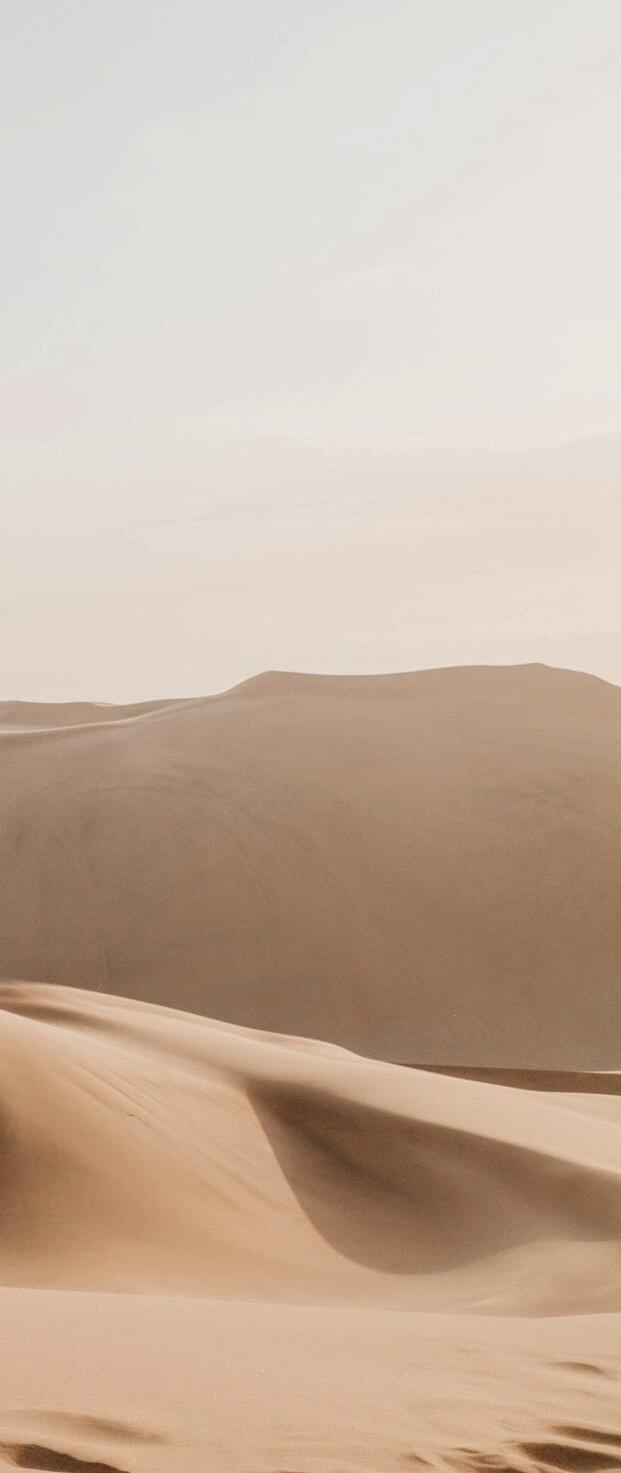
In the heart of southern Africa lies a land woven from contrasts, where the ancient and modern dance together under a sky so vast it seems to encompass all of time. This is Namibia, a land calling to a new breed of explorers — the digital nomad.
With the recent introduction of Namibia’s Digital Nomad Visa, a new pathway has opened for those looking to base themselves in our southern African gem, inviting the world's remote workers to step into a tale that stretches across deserts and mountains, coasts and plains. Valid for up to six months, it beckons the intrepid to explore, to create priceless memories, to establish lifelong contacts, and to immerse themselves in different cultures. A simple online application leads to a world where the ancient sand dunes of Sossusvlei tower like monuments to eternity, and the wildlife-rich plains of Etosha National Park pulse with the very essence of life.
The digital nomad who ventures into Namibia will find cities and even quaint towns alive with technological ease and rural landscapes brimming with soulful serenity. Coworking spaces buzz with creativity in urban areas, while remote locales offer solace and inspiration, never far from the digital heartbeat of the world. Namibia's tale is one of diversity and contrast.
As the seasons change, the digital nomad moves on, but the story of Namibia remains, an ever-present invitation. The contrasts linger in the mind, a reminder of a land where work transcends mere duty and becomes a part of something larger and more profound.
For those who seek more than a destination, who yearn to be part of a story that echoes the harmony of contrasts, Namibia awaits. The Digital Nomad Visa is not merely a document; it's a chapter in a never-ending tale, a verse in the song of a land that invites you to compose your own melody.

So, why not let Namibia be the backdrop to your work, the muse to your creativity, the setting to your own tale in the land of contrasts. It's a story waiting to be written, a narrative ready to be explored. The pages are open; the pen is in your hand. TNN
QUICK FACTS:
• Visa validity period: 6 months
• Open to all countries
• Visa paid upon arrival (USD 124)
• Renewable
The Namibia Digital Nomad Visa was developed to provide travellers who are yearning for a breath of fresh air, immersing in different cultures while working independently and remotely. The visa is valid for up to 6 months and visitors can create priceless memories, exploring ‘the land of contrasts’ and establishing lifelong contacts, all while gaining a unique international experience.
The visa application is completed online and further bookings for accommodation, flights and vehicle arrangements are easily accessible on the Namibia Digital Nomad Visa webpage: https://nipdb.com/nomadvisa/

For more information: Visit: www.nipdb.com/nomadvisa/ Email: nomadvisa@nipdb.com Telephone: +264 (0) 83 333 8600
The spectacular dune vista presenting itself to our guests in different subtle hues as the light changes throughout the day is a photographer’s delight! Situated on the edge of Swakopmund, it is only 3.5 km from the centre of town or from the beach. Quiet, spacious and beautifully appointed chalets with a view like none other and immersed in a unique natural setting.
+264 (0) 64 406 236 | +264 (0) 81 149 4979 info@desertbreezeswakopmund.com www.desertbreezeswakopmund.com
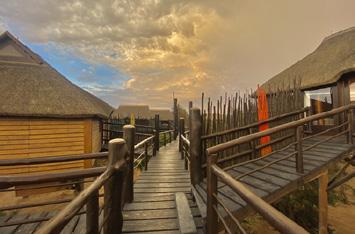
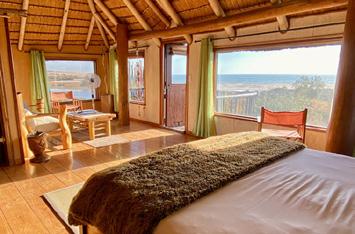


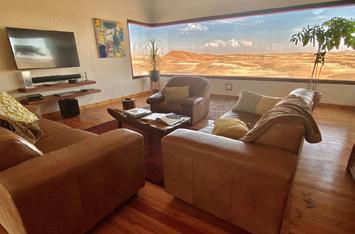
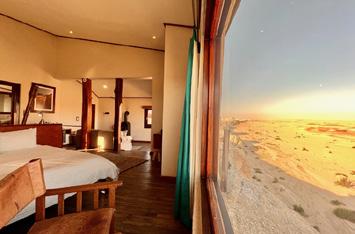
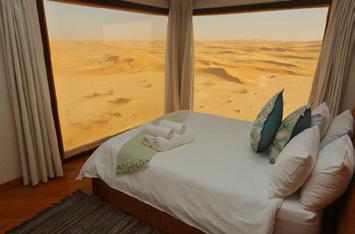

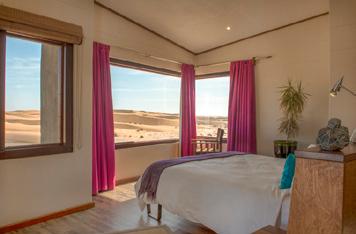
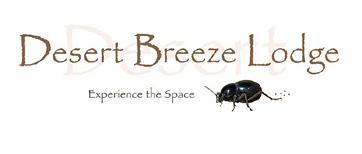
Above sand and tamarisk bushes bordering the Swakop River, nine wooden bungalows and two luxury villas stand on stilts with interlinked wooden walkways. The tamarisk merges into phragmites reeds, beach and sea, and in the distance the sensuous sand dunes of the Namib Desert lie seductively along the road to Walvis Bay and the west.
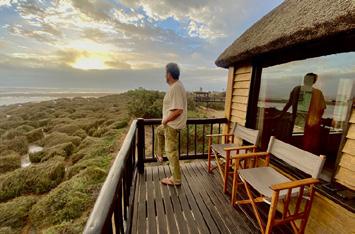
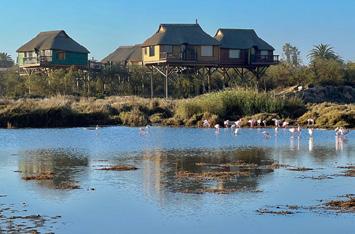
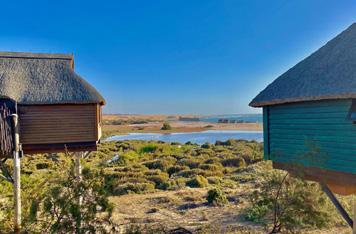
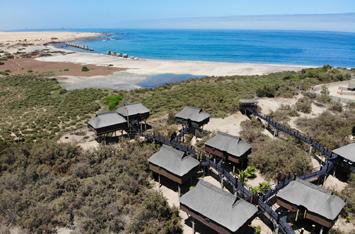
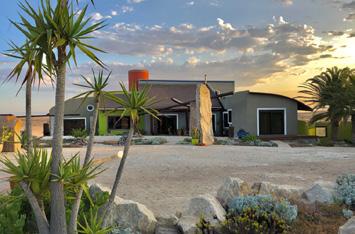
+264 (0) 64 400 771 | +264 (0) 64 400 711 info@thestiltz.com | reservations@thestiltz.com www.thestiltz.com

Along the scenic B4 tar road between Keetmanshoop and Lüderitz, about 50 km east of Aus, lies an unassuming farm stall which has become a well-known landmark to everyone who regularly travels this road. Biltongplaas is owned and managed by the husband-and-wife team of Danie and Launette Loots. This small roadside business has become a must-do stopover for homemade produce and meat products.
The couple started Biltongplaas, situated on Danie’s family farm, around six years ago. They set up shop in what was formerly known as Kuibis Castle, an accommodation establishment. Using the existing structures, they revamped and transformed it into the quaint shop and tea garden that it is today.
At the core of Biltongplaas is a butchery that produces delicious biltong, droëwors and chilli bites. They also offer fresh meat and boerewors from the cattle and sheep on the farm, making it the perfect place to stock up on meat when on holiday in the area or to pre-order when touring Namibia.
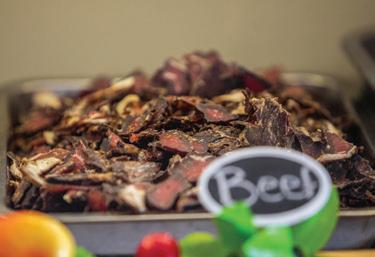
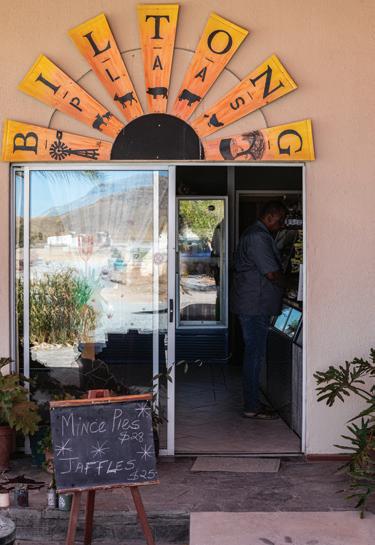
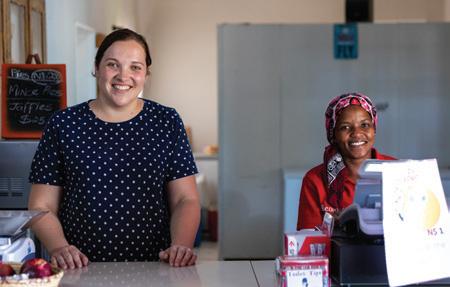
As a commitment to the quality of their products, Launette says they constantly fine-tune their recipes because they want to become well-known for their meat products. “We want our products like biltong and chilli bites to stand out and have people talking about it. We want to become a place where people simply have to stop when travelling this way,” she says.
In addition to their renowned meat products, Biltongplaas boasts an impressive array of homemade goodies. Pickled veggies, jams and preserves are lovingly crafted from the fruit trees that grow on the farm. From guava and fig jam to pickled onions and curried cabbage, each jar tells a story of seeds sown, nurtured and harvested with care.
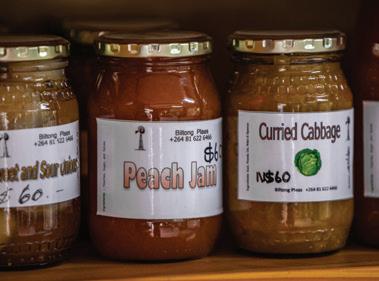
They have already made a name for themselves with some of their homemade products. “Our jaffles and ginger beer are firm favourites in the area. The main aim for us is to offer a quality product that our customers will enjoy,” says Launette.
For the hungry traveller, they produce freshly baked homemade pies, mouthwatering schnitzel burgers, as well as a selection of dried fruits, nuts and snacks. The tea garden offers a relaxing spot to enjoy a cappuccino alongside a slice of their delicious lemon meringue or chocolate cake.
For those captivated by the beauty of the region, Biltongplaas offers a cosy campsite with basic ablutions. Even though there is no electricity, the tranquil ambiance and the Loots’ hospitality create an experience that money can’t buy.
Whether in need of a coffee for the long road or some chilli bites to snack on, remember to stop at Biltongplaas next time you are in the area. TNN
Launette Loots and Beauty Boois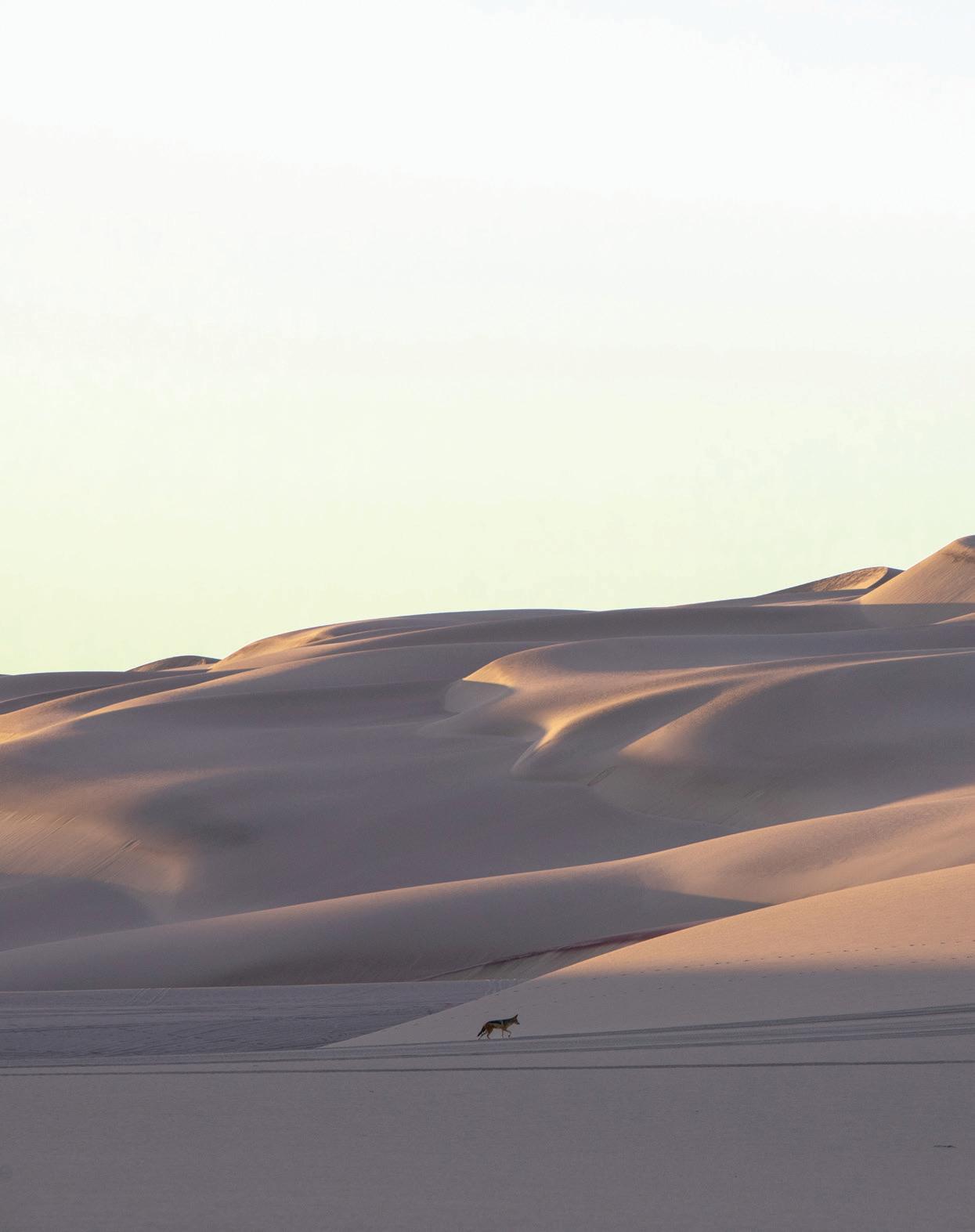
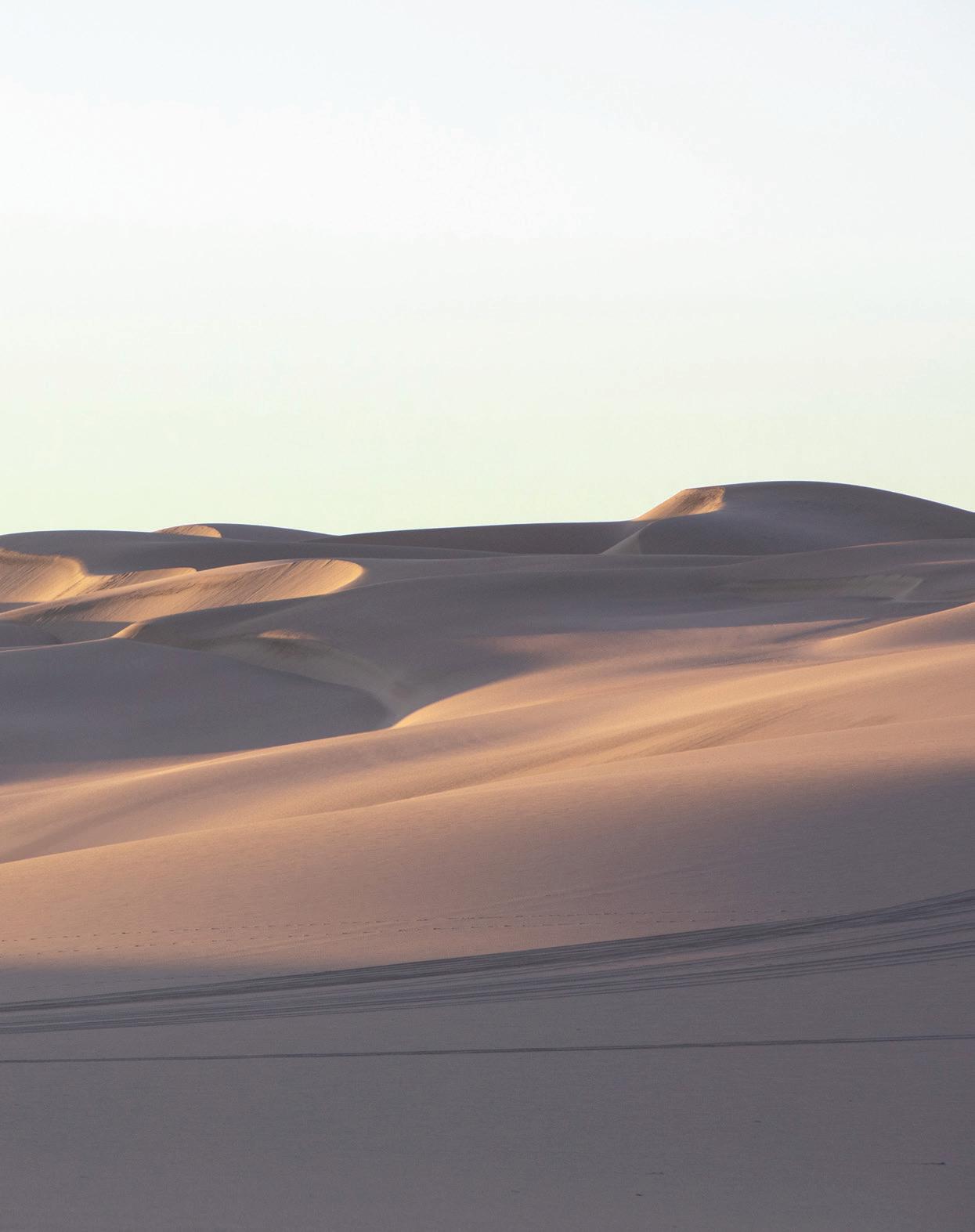
Ihave two items on my medium-term bucket list, one of them being a hot-air-balloon safari over the Namib Desert. The second, delightfully ticked off the growing list on a recent visit, was experiencing Shipwreck Lodge in the Skeleton Coast National Park.
It must be emphasised that this corner of our coastline remains one of the few truly untouched landscapes in the country. While wide open spaces are our forte, the favoured and easily accessible attractions have harboured clusters of lodges and activities, dotted around the noteworthy sights within Namibia. The Skeleton Coast National Park is well and truly the most forlorn place the country over, and Journeys Namibia managed to punctuate the deserted isolation with a few cabins on a dune, surrounded by sheer nothingness.
Getting there is half the journey. First, two large gates decorated with a skull and crossbones mark your entry to the fragile, protected area of the park from the southern gate. Then follows a long winding road between sea and sand to Möwe Bay, the small home settlement of ministry rangers and a handful of scientists. Another ride, this time with a seasoned guide, takes us over biscuit-coloured dunes and passes a few famed shipwrecks before trekking thick sand to the front deck of Shipwreck Lodge.
Here, the misty Atlantic winds whisper legends of pioneers and sailors who met an end on this coastline. The sands of time venture into every crevice of a wretched shipwreck, left to wither away until the end of time. Remnants of the nomadic Strandloper people, their clay pots and ostrich eggshell beads shattered and scattered, tell ever more fables of life in this deserted place. Our guide shares the legend of inland settlers, whose donkeys ventured through the Hoarusib River to the sea to graze by the consistent spring within eyesight of the lodge. The donkeys have since returned home, but the story sparks intrigue into the secrets of this special place.
Ten cabins are immaculately constructed with slanted and curved walls. Organic timber is employed in various angles and directions, constantly leading the eye to the next interior marvel. Portholes frame the desert and distant sea views in a nostalgically nautical style. And plush blankets and cushions beckon to be cuddled up in once the southwesterly wind begins to howl.
Good weather is not to be taken for granted on this coastline that is notoriously misty. We were lucky enough to have two
splendid days of sunshine while at Shipwreck, calling for every outdoor activity on their roster.
On our journey to Möwe Bay, rumours began circulating that a few cheetahs were spotted near the lodge. I cannot begin to stress how utterly rare this is – the big cats roam freely inland, but very seldom do they venture this far west. We kept our fingers crossed, but simultaneously dismissed the likelihood of such a sighting. No point in getting our hopes up!
The sheltering game viewer sluggishly departed from the reception as we set our sights on the dry riverbed. This river runs through a most juxtaposed landscape. On our right, a 40-km-wide dune belt descended ceremoniously onto the flat surface of the Hoarusib. Peeking through the velvet-textured sand were contrasting black granite boulders, larger than life itself. Our guide nonchalantly mentioned that the monolithic rocks are the base of the dune belt. Under all that sand lies unfathomable masses of boulder.
To our left, the river’s rim was lined by soft grey granite structures, eroded endlessly to create hollows, holes, round peaks and surreal shapes. I have only just begun gawking at the landscape, unlike anything I had ever witnessed, when we spotted a small figure in the distance of the jeep track. A black-backed jackal, surely? Two… no three of them. Only, that instantly recognisable trot of a scavenger seemed more gracious, and the tail appeared a bit too long for a jackal.
You would not believe me if I were not accompanied by a photographer, but less than a kilometre into our nature drive, the rumoured cheetahs dashed across our path. The stealthy big cats came trotting over the dry riverbed from the dunes to the boulders on the other side, except, the previous sighting recorded four, and we had only seen three. With eager eyes, a long camera lens and a single pair of binoculars, we peered attentively at the dunes, surveying for the fourth cheetah. And sure as the sun rises in the east, tucked between the crescent of a skyscraper-high dune, hid a pair of perfectly rounded fluffy ears.
Her siblings had long disappeared between the rocks on the other side, so we spent a good hour moving at 400-metre increments, following the last cheetah as she climbed and hid, then appeared again. Slowly she moved up the slip face of a dune, leaving a jagged trail of footprints as she periodically stopped to peek over her shoulder.
There comes a moment of tense anticipation when you finally venture to a new destination, an uncharted adventure precluded with so much hype. Will this place that you have seen endlessly on social media, heard about from many travellers, envied and vowed to discover for yourself, really live up to all the expectations?


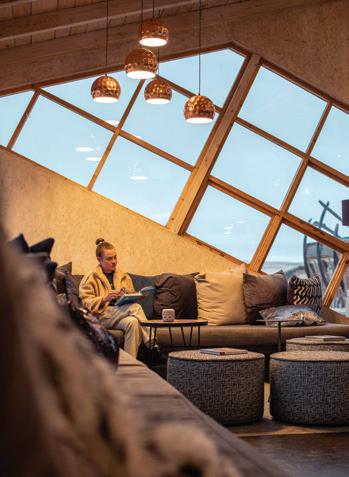
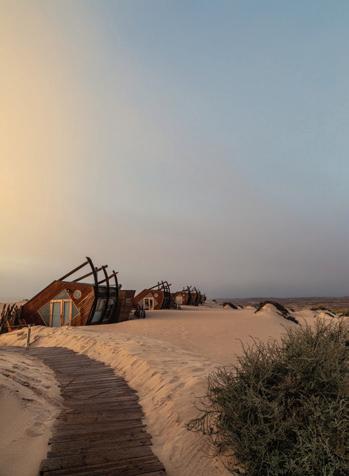
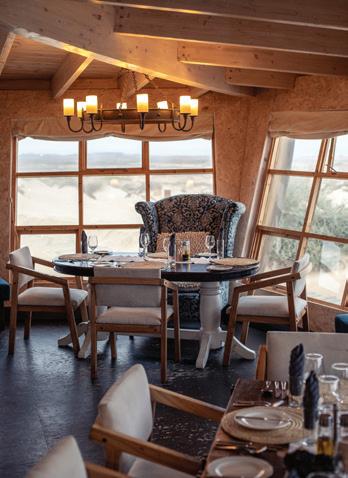


Shipwreck offers quad bike tours, nature drives, sundowners and lunches on the beach, as well as historically and geologically informative walks. All inclusive.
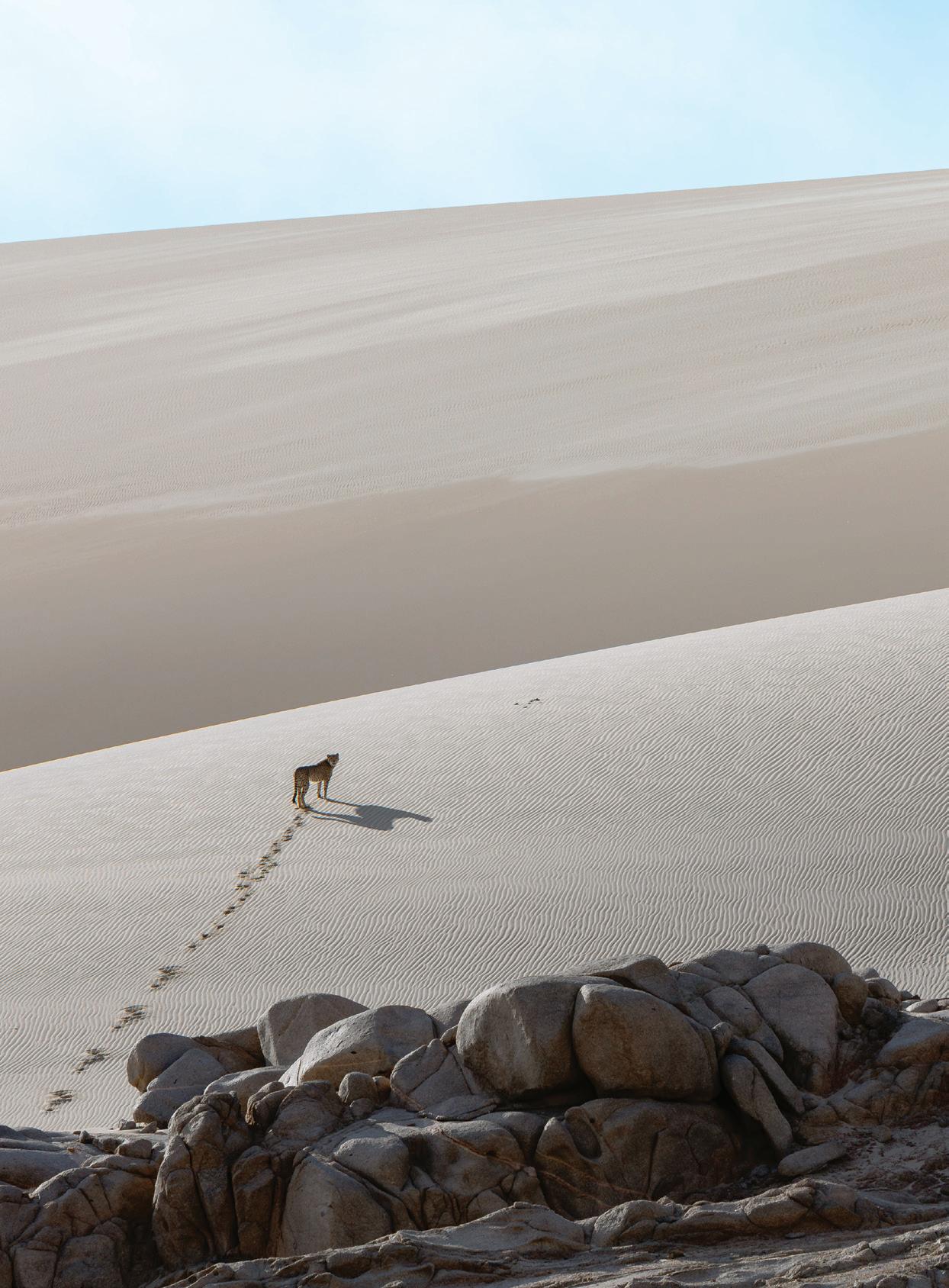
Charter flights touch down at Möwe Bay, where a Shipwreck guide welcomes guests and transports them to the lodge with a roughly one-hour drive.
For self-drives, access to the park is either via the southern gate at Ugabmund, or southeastern gate at Springbokwater, where permits can be obtained. Self-driving guests park and leave their vehicles at Möwe Bay, where a Shipwreck guide takes over and drives to the lodge. Special arrangements can be made for self-drive guests wishing to access Shipwreck Lodge via the Hoarusib River.
Eventually we peeled ourselves away from the once-in-alifetime sighting, leaving the cheetahs to reunite on a single side of the river, and drove deeper into the Hoarusib and out of the canyon to a viewpoint. Life exists in this desolate place, from the desert-adapted elephant and lion (a potential sighting which we sacrificed for the cheetahs) down to the lichens that grow on the desert floor. From a distance they radiate green and orange hues easily mistaken for the colour of the soil, but these minute organisms flourish on top of rocks, forming lines of textured tangerine and frilly lettuce.
On our route back to the lodge, we passed through a massive gorge lined with jaw-dropping rock walls. Marbled swirls of black and burnt orange stand sentinel over a sixmetre-wide stretch of the riverbed, where springbok and gemsbok graze unbothered. The natural wonder of this place continues to leave me speechless.
Bright-eyed and wonderstruck by the beguiling drive, our return to Shipwreck Lodge meant red wine by the woodburning stove and longing looks over the landscape. On the menu as we settled in for dinner was seared tuna steak, accompanied by an umami-loaded tahini and soya sauce drizzle. Silence fell across the entire dining room as our fellow guests were equally as enamoured by the taste sensation, perfectly prepared and paired with the misty and moody immediate surroundings.
Halfway through our three-course meal, a staff member did the rounds asking whether guests would like a fire started in the cabin stove. A resounding yes from everyone! When we returned to our sojourn after dinner, the room was engulfed in a warm glow from the fireplace, creating an uncanny cosy atmosphere. Curled up under the blankets, you drift into a calm slumber as the crackle of wood lulls you to sleep.
Awakened with the soft, filtered sunlight of dawn, the floorto-ceiling windows in the bedroom look out onto the mouth of the Hoarusib and distant ocean. Shipwreck Lodge is one of those rare finds where staying inside the belly of a ship with a coffee and a book, while watching the landscape change with the coming and going of the sun, seems like the logical thing to do. The outdoor activities are endless and exhilarating, yet we find ourselves longing to return, because this cabin feels like home.
Spoiled with more splendid weather, after a wholesome breakfast and one of the best omelettes I have ever had, we embarked on a quad bike excursion onto the dunes. With ease and a crisp breeze, our guide took us up and over unfathomable stretches of beige hills, periodically stopping to take in the views that redefine the term “sand sea”. Injected with the adrenaline that comes from cruising down the steep slip face of a dune, your greatest challenge is focussing on driving as the landscape insists on being a show-off.
If ever you crave an ego death, I urge you to stand on top of a dune in the Skeleton Coast National Park. The term “speck of dust” takes on new meaning when surrounded by 360 degrees of endless sand.

Many more memorable meals were dished up, as the kitchen at Shipwreck set out to serve sensational seafood seeped in flavour. Even more glasses of red wine were savoured by the fireside, after sundowners on the beach and informative nature walks. Without a glimmer of doubt, Shipwreck Lodge lived up to every expectation, in fact, exceeding them. We stepped into a storybook, stayed in a metaphorical shipwreck, stimulated every one of our senses with food, fun and fireplaces, and departed feeling like family. TNN
The clay castles of the Hoarusib are fascinating geological formations to be seen on a nature drive from Shipwreck. Lucky guests might spot the desert-adapted elephant and lion that freely roam the area. Remnants of the nomadic Strandloper people, like clay pots, stone tools and ostrich shell beads can be seen on a guided walking tour. Overall, the area offers awe-inspiring vistas, geological formations and untouched landscapes.


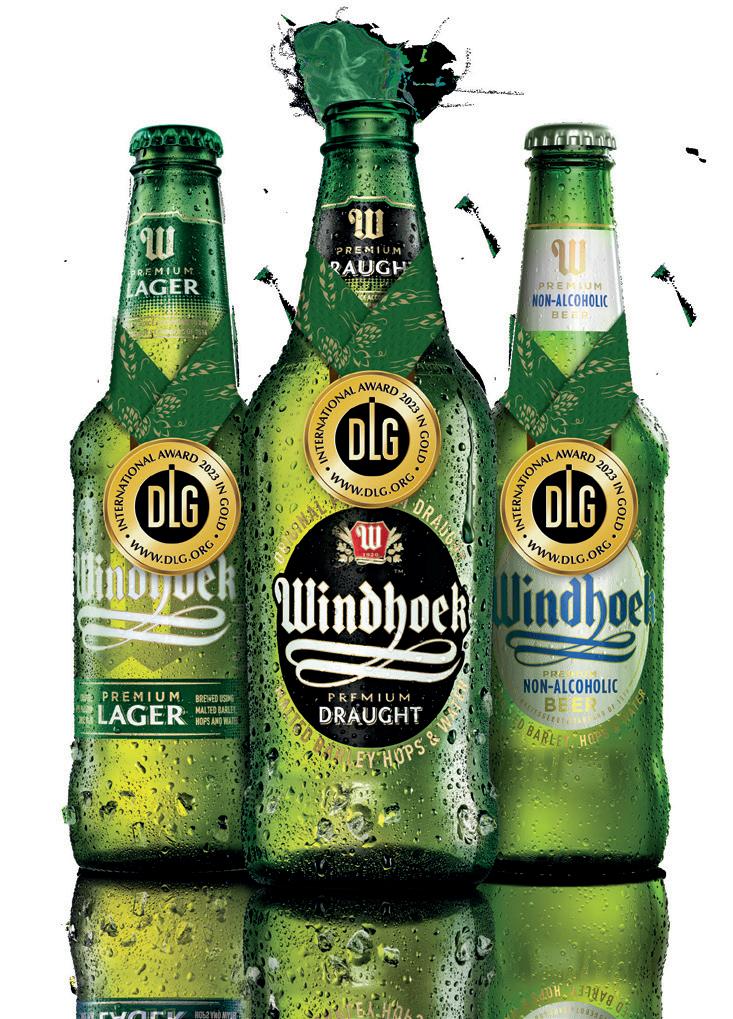
An enigmatic and desolate stretch of land wedged between the vast Namib Desert and the icy Atlantic Ocean in the southwestern parts of Africa, is known as the Skeleton Coast. More often than not, this inhospitable coastal region in Namibia presents a haunting and eerie facade. But beyond lies a gripping history that speaks of tragedy and adventure, which gave the Skeleton Coast its name. Countless shipwrecks have met their demise along its treacherous shores. About 300 ships are recorded to have sunk in these unforgiving waters, while evidence suggests that another 200 vessels may have had the same fate. Today, the map of the Skeleton Coast shows the locations of some wrecks. Here are the best-known shipwrecks that you can tick off during your visit to Namibia.
Probably the most famous of all the shipwrecks along the coast. The British passenger-cargo ship, en route to South Africa in 1942, struck rocks and began to sink. Its crew and passengers faced a perilous struggle for survival in the harsh desert environment. After weeks of hardship, they were miraculously rescued, thanks to several brave rescue missions.
This German cargo ship ran aground in thick fog in 1909 at Conception Bay. Its deteriorating remains now lie stranded some 400 metres inland from the sea, half-buried in the shifting sands of the Namib Desert. It is a surreal sight.
The Otavi was a cargo ship that sank in 1945 due to a navigational error. Its wreckage in Spencer Bay remains visible.
The Shawnee was a fishing trawler that sank in 1976 where the shifting sands of the dunes meet the sea. Sometimes it is covered with sand while at other times it lies in the water. It is much photographed because of this.
In August 2008, the Zeila, a fishing trawler, got stranded near Die Walle, a fishing spot south of Henties Bay. It had been sold as scrap metal to an Indian company by Hangana Fishing of Walvis Bay. Destined for Bombay, India, it came loose from its towing line after departing Walvis Bay and drifted north on the Benguela Current. TNN


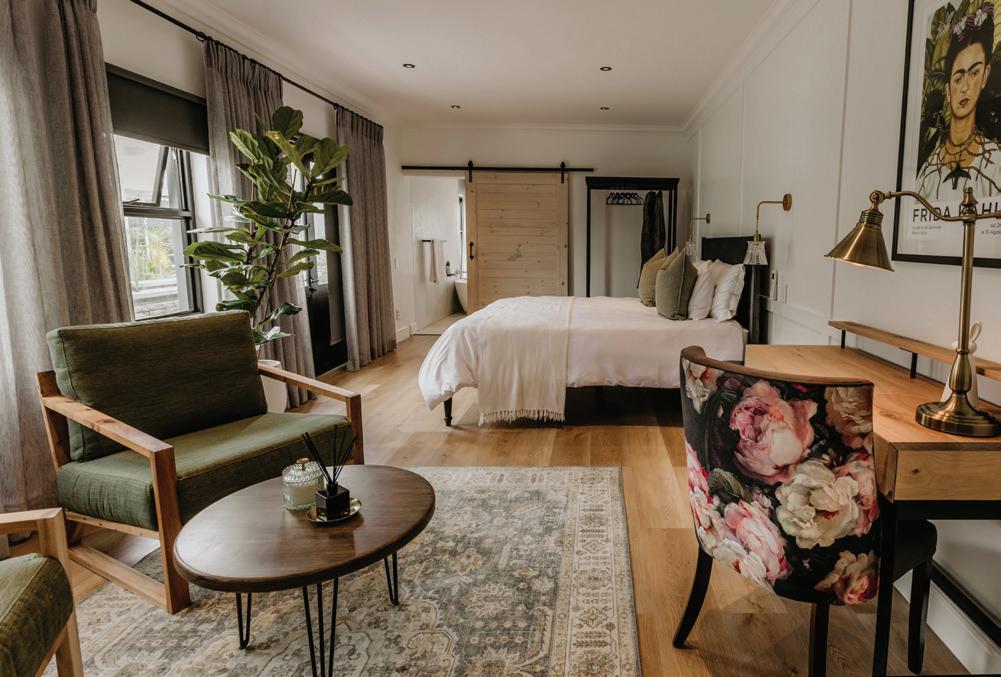 Text Charene Labuschagne | Photographs Taryn Germishuizen
Text Charene Labuschagne | Photographs Taryn Germishuizen
In a town filled to the brim with guesthouses and hotels, it’s hard to come by a stay that is truly unique. Swakopmund is the epicentre of tourism in Namibia, and with good reason, as it offers historic architecture, specialist shops selling antiques, homemade goods and curios and activities for the entire entourage. Yet, none seem to have captured the essence of this small coastal town within an accommodation space quite like Fancy Fritz.
Fancy Fritz is the new kid on the block at the corner of Leutwein and Windhoeker Street, centrally located to all the abovementioned sights and to-dos, and they have effortlessly pulled off the old-meets-new home away from home with their three exclusive suites.


The brain (and love) child of Jandré and Taryn
Germishuizen, Fancy Fritz used to be a historic home. The original floor plan of the property hangs sentinel over the foyer, testament to the fact that the couple have used the original building’s solid “bones” as the blueprint for their renovations. Both avid travellers, the onset of 2022 saw Jandré and Taryn venturing to create a stay that ticks all their seasoned-lodge-guest boxes, with comfort being the number one priority.
Fancy Fritz’s three suites, bar and lounge all open onto an enclosed courtyard. On the Namibian coast, this is pure genius. The landscaped garden, sunken bonfire and trickling fishpond form a refuge from the often unpredictably windy and wet weather. When the sun sets, a crackling camelthorn wood fire invites guests to huddle around with a drink from Fancy Fritz’s superstocked bar, before heading out for dinner in town.
Curled up in their crisp cotton bedding, a deep, restful slumber is inevitable. Roller blinds block out every slither of light, so if you’ve planned any morning
activities during your stay, be sure to set an alarm. It is ridiculously easy, and frankly recommended, to sleep in when staying at Fancy Fritz. The suites also have a nifty tea and coffee station, fit with Swakopmund-roasted coffee pods, and a boisterous cookie jar, just like at your gran’s house. Plush occasional chairs beckon for a bookreading, and guests can even get a little admin done at the desk. But you must wear one of their fluffy robes while doing so!
With so many great eateries in town, Fancy Fritz ushers guests to support the local restaurants, while they offer only breakfast on request. Their breakfast basket can either be delivered to your suite, or served in the cosy dining room sporting a gallery wall filled with intriguing art pieces, a fiddle-leaf ficus flourishing in the corner and French windows overlooking the quiet street. Pair that with a croissant and bacon, and Bob’s your uncle!
Lovers of design will revel in the lounge and bar area, where skylights flood velvet and cane couches with ambience. A row of double doors open onto the patio, where bistro-style tables and umbrellas cement the old-meets-new vibe, and inside, carefully considered coffee table books, knick-knacks and guitars are enveloped in a colour palette of peach and olive green.
After a day’s gallivanting in Swakopmund, returning to Fancy Fritz is a homecoming. Sleep well, bask in a sunlit room while paging through a picture book, sit around a Namibian fire and drink a generous gin and tonic. Few things say “home” like this combo does. TNN
 Text & Photographs Zan Le Roux
Text & Photographs Zan Le Roux
I am no climber, not self or otherwise proclaimed, and what follows should not be seen as a definitive guide to the Spitzkoppe. I have also never been to the Matterhorn, the comparison inspired by a simple google search of “Spitzkoppe”, so I can in no way attest to the accuracy of the statement “Namibia’s Matterhorn”. In spite of this, it has an adventurous ring to it – climber or not. In June this year a group of friends and I managed to summit that great granite beast known as the Spitzkoppe, and here’s hoping that qualifies me to tell the tale of summiting it.
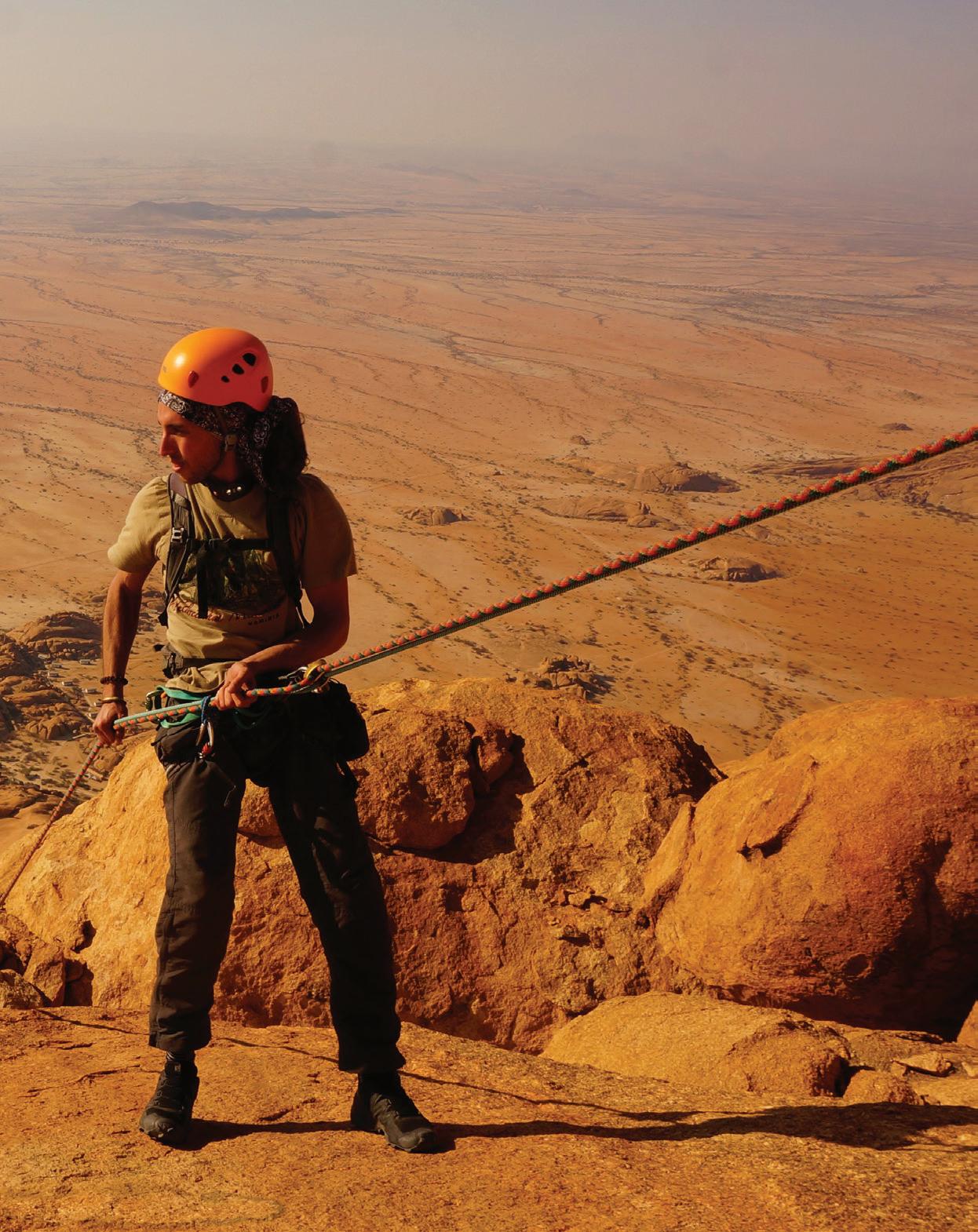
The epic began some months earlier when a friend of mine added me to the WhatsApp group “Spitzkoppe Summit”. The name said it all, the plan was to summit the Spitzkoppe. Simple as the plan was, we had to get a few things in order before setting off – assemble a team, beg, borrow or steal the necessary equipment, learn how to climb and finally go climb that mountain.
The motley six, as I’ve named us, included: Luke Brinkman (the founder of the Whatsapp group), Joe Lichtman (medical officer), Josh Lichtman (head chef), Søren Jensen (chief abseiler), Freddy Setzkorn (the only experienced climber) and myself (photographer). Our gear consisted of harnesses, tight fitting climbing shoes, helmets, chalk bags, ropes, slings, prusiks, quickdraws, cams, nuts, bugs, grigris and an array of other devices, each with their own equally non-descript name in climbing vernacular. Training had all of us joining the local climbing gym, Urban Friction, where we would spend a few evenings each week familiarising ourselves with the gear and building up fitness before heading to a local bar to discuss strategy.
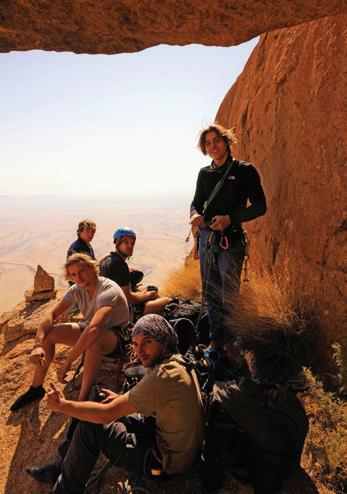
In what felt like in a flash, the months of training had passed and it was time to head to the mountain. On a Friday morning we scurried around Windhoek collecting the last few pieces of borrowed gear before setting off towards the Spitzkoppe. After the mandatory stop at Wilhelmstal farm stall for coffee and biltong, and Usakos for refreshments, we turned right onto the familiar dirt road towards Spitzkoppe, and the magnitude of what we were undertaking started to set in.
The Spitzkoppe, a set of granite inselbergs, rises approximately 700 metres out of the surrounding Namib Desert and tops out at a height of 1728 metres above sea level. At 120 million years old with solid granite faces running up its sides, the mountain is impressive to say the least. Hans and Else Wongtschowski and Johannes de Villiers Graaff were the first to climb the mountain in 1946, probably wearing veldskoene and using manilla rope
(the type we see in pirate movies). Now, 77 years later, we too wanted to leave our mark in history and make our way up the red mountain.

On arrival on Friday afternoon we immediately set off to one of the easier routes where we could do a bit of practice climbing and get “a feel of the rock”. After our first collective outdoor climb we made our way back to our campsite, which we shared with a horned adder and a genet, and busied ourselves with repacking gear and filling water bottles for the following day. As with most Namibian gatherings, supper was prepared on the fire and paired with a few Tafels. Sitting in the firelight, with the Spitzkoppe rising into the night sky above us, we all felt privileged to be there. Beer and tea flowed throughout the night and conversations drifted from history to philosophy to religion. We differed on why we had been born into our lives and what we should be doing with our time on this earth, but we were all equally in awe of this journey, and eager to live it well. Importantly, we had all come to the conclusion that in that particular time and place, the correct thing to do was to climb the mountain we had set out to climb. As the fire and the conversation died down, we each in turn settled down under the stars and slipped into sleep lulled by the sound of barking geckos and excited for the awaiting adventure.
Saturday morning had us up and packing long before sunrise. After a quick breakfast we gathered what we needed and drove to the starting point at the base of the mountain. As the first light of dawn appeared above the eastern horizon, with the stars still visible in the sky, we started our ascent of the Spitzkoppe. Following the “normal route”, marked by rock cairns and a faint footpath, we slowly made our way up the mountain. With coils of climbing rope wrapped around our bodies and climbing gear jingling in our packs we definitely looked the part and before we knew it, we were thoroughly into “the scramble”.
This first section of the route takes you up a few slabs and gullies, over, under and around a few boulders and could loosely be called hiking. Two chimneys need to be wriggled up, the last one being particularly tight, and generally there is no need to tie into a rope for this section. The last chimney has you passing through a narrow crack in the rock in almost complete darkness and bags need to be passed along overhead as you won’t fit through
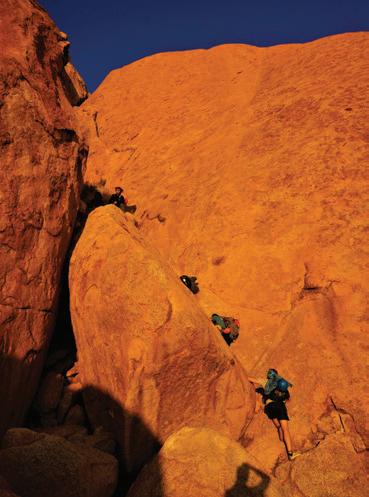
with one on your back. Emerging from the belly of the beast, we reached a point where we had to abseil down roughly ten metres and make our way along a ledge to the start of “the climb”.
A smooth, near vertical granite slab bars the way to the top and rather obviously indicates the start of the climb. If I had any doubts about whether it was necessary to tie into a rope up until this point, these doubts are quickly replaced by a desire to be secured to the mountain by as many means as possible. Freddy leads the way, effortlessly climbing up the slab and out of sight placing protection as he goes along. Freddy is followed by Luke, then Søren, Josh and Joe, and I bring up the rear. In this way we slowly move up the mountain, each tied to the other and equally invested in the safety of all of us. The climb is broken up into five sections known as pitches and varying from 25 to 50 metres in length. At the end of each pitch there is an anchor place where everyone can tie in, have a drink of water, and discuss the next section. These little gatherings become a safe haven and are the goal of each pitch. Out on the open face you are alone with the rock, systematically placing hand over hand and foot over foot, your friends are out of sight and the wind blows their words of encouragement away before they can reach you. One rope runs up to safety and one rope runs down to the next soul coming up. At the end of the pitch your friends sit waiting, smiling nervously, there is shelter and banter and strength for the next section.
The climb continues in this fashion until you reach the last pitch. At this point the trees on the landscape below are reduced to specks and it feels like the rock you are sitting on could slide off the mountain at any moment. If in this situation you do not experience a fear of heights, I think it is safe to say that you are fearless. Regardless, for those of you who like me enjoy spending your time on ground level with two feet firmly planted, I suggest that you do not look down and simply focus on the rock in front of you and the task quite literally at hand. This last section has us squeezing up a short chimney, breathing heavily and, in the truest sense of the word, following a trail of blood where the first few of our party have wedged their bare legs against the sharp granite crystals. Emerging from the chimney you crawl out onto a slab dropping off for hundreds of metres in all directions and slowly make your way up to the summit.
Almost suddenly, after a gruelling climb, we were on top, with the desert stretching as far as the eye can see in a 360 degree panorama. The dry riverbeds lined with shrubs are scrawled
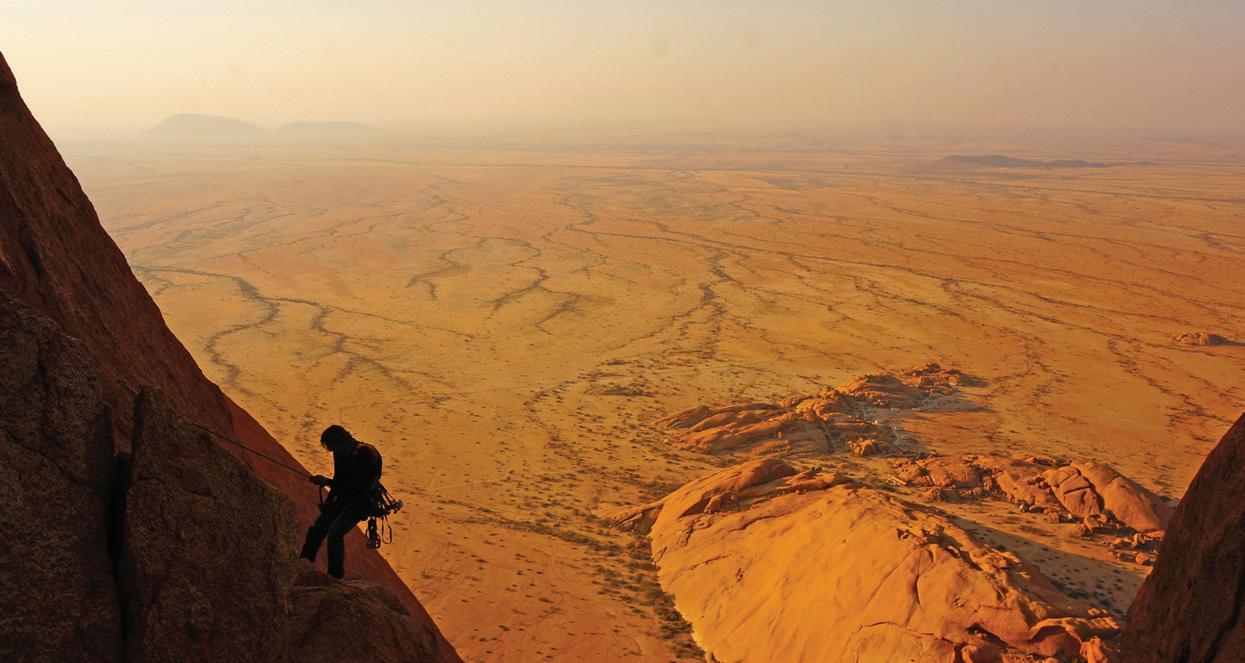

across the landscape like patterns on a carpet, and in the distance you can see the Brandberg to the north and the Erongo Mountains to the east. The summit is marked by an unassuming pile of rocks and a metal box containing the summit book. We scribbled our names into it and enjoyed paging through the history. Many familiar names were found on those pages. Friends, family and the who is who of the Namibian climbing scene. Everyone writes about the challenge of getting to the top, the awe of reaching the summit and signs off with their name. They, too, thought it was simply necessary to climb the mountain and did it, all of them searching for their own taste of heaven.
As the ecstasy of reaching the top wore off, we were faced with the next challenge: getting down. Climbing down the mountain involves a series of abseils down sheer and often overhanging faces from one anchor point to the next. As each in turn stepped over the edge and into the abyss, we quickly realised that this is not for the faint-hearted and that abseiling is not as easy as Tom Cruise made it look in Mission Impossible. The first abseil has you descending nearly 60 metres onto a sheer face where you clip into an anchor and dangle off the side of the mountain while setting up the next abseil. With nowhere to stand, never mind sit, this would not be a good place to spend the night. In spite of this, after a few hair-raising moments and heated exchanges we all reached the bottom of the abseils safely and were happy to be on our feet again. From the bottom of the abseils we walked down on the same trail we had come up earlier in the day and made our way back to the car. The sun started to set when we arrived at the car, exhausted yet full of energy and relieved to be back in familiar territory. The story continues with the usual post-achievement celebrations of cold beer, meat and the excited telling and retelling of the day’s events.
Our friends and families back in Windhoek have heard the stories multiple times. Each time we tell it we seem to have missed an important detail that needs to be reiterated. I was so enthralled with the achievement that I agreed to write an article about it. I am grateful for the opportunity to have climbed the Spitzkoppe. I feel it was an excellent way to spend my time. Experiences like these, shared with friends, are what I enjoy, and I am privileged to live in a country that affords me these occasions in more ways than I can name. As for what to do with one’s time on earth, I can highly recommend visiting the Spitzkoppe. If you have the urge to climb it, then climb it. If not – then don’t. The mountain was there long before us and will be there long after we are gone. TNN

This spring we celebrate Namibia’s acclaimed conservation areas as a cornerstone of our Green Issue. So let us embark on an awe-inspiring, although highly summarised journey through the untamed hearts of Namibia's national parks. Hundreds of magazine pages are needed to truly share the story of each of these remarkable havens of nature, but we will try our best to share the highlights with you, and in doing so, hopefully inspire and beckon the adventurous souls to come and explore the tapestry of diverse landscapes and rare wildlife encounters that are found in Namibia’s incomparable national parks. Let the allure of Nkasa Rupara, Skeleton Coast, Tsau //Khaeb and so many more ignite your wanderlust as we dip our toes into their enchanting stories, reminding us all of the vital role we play in safeguarding our planet's most treasured ecosystems.
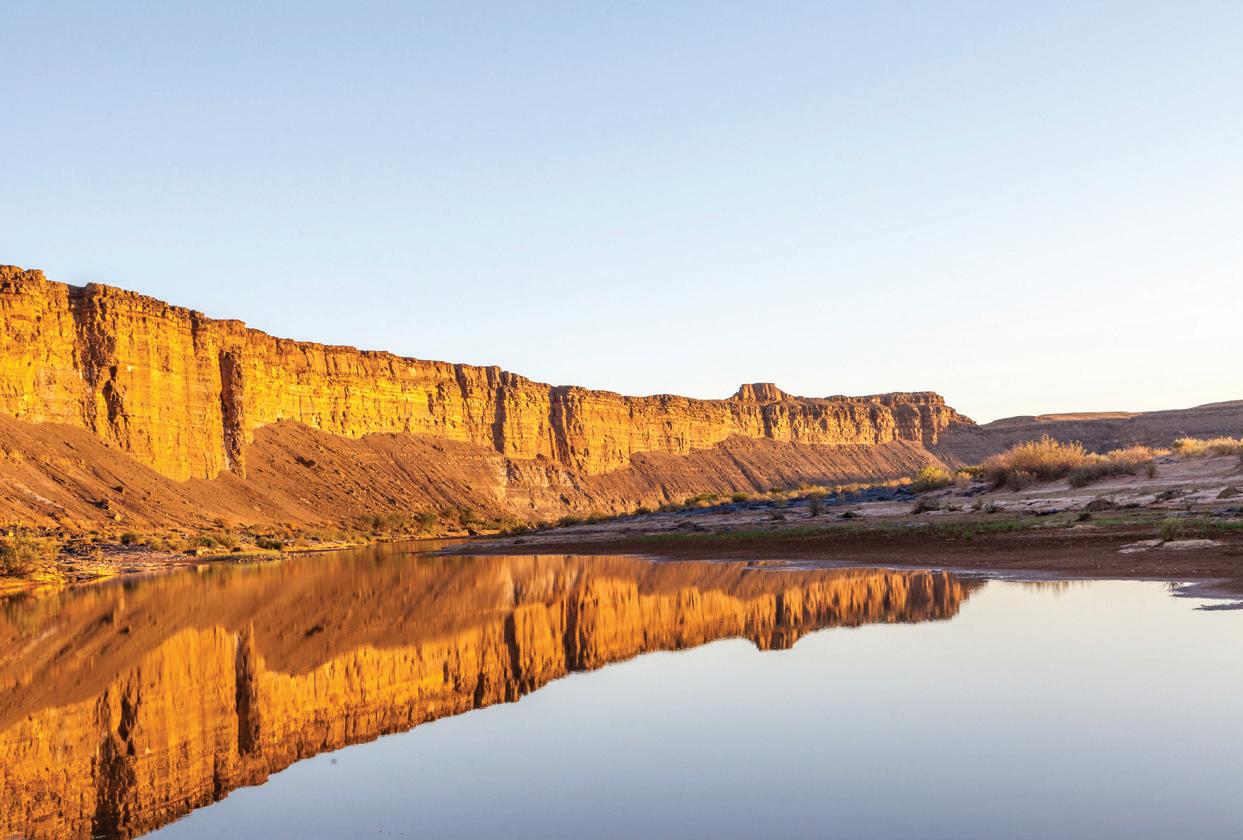 Text Elzanne McCulloch
Text Elzanne McCulloch
Once known as the forbidden territory due to its diamond riches, Tsau //Khaeb National Park now stands as a testament to conservation and renewal. Home to the unique Succulent Karoo biome, this protected area boasts a remarkable diversity of succulent species, making it one of the world's top biodiversity hotspots. Tsau //Khaeb National Park shows how nature and industry can coexist harmoniously, offering visitors a rare opportunity to witness untouched and pristine wilderness around the interesting and alluring remains of a bygone era of diamond exploration.
Experience the untamed wilderness of /Ai-/Ais Richtersveld Transfrontier Park, where nature's grandeur unfolds on an unimaginable scale. Stand at the edge of Africa's largest gorge, the second-largest canyon in the world: the Fish River Canyon. This transfrontier conservation area spans across the South African border and is a sanctuary for the Succulent Karoo biome, one of the world's most diverse botanical hotspots. For the daring and well-prepared hiker, the fiveday, 90-kilometre Fish River Canyon hiking trail promises an exhilarating journey. Descend down steep cliffs to the sandy banks of the Fish River, surrounded by towering canyon walls that reach over 550 metres in height. Klipspringers bound up the cliffs, and Mountain Chats drink from the pools left by the river. The challenging hike through ancient rock formations and isolation makes for a timeless and euphoric experience.

Prepare to be awed by the grandeur of Namib-Naukluft National Park, Namibia's largest conservation area. This park offers a wealth of adventure for the intrepid traveller. Hike through the Naukluft massif's rugged gorges and paths or challenge yourself on one of the 4x4 trails. Explore the fascinating Sesriem Canyon, marvel at fairy circles, and slide down towering sand dunes in Sossusvlei. The park's diverse landscapes encompass mountains, the Sand Sea, riverbeds and gravel plains. Encounter unique wildlife and plant life that have adapted to the extreme conditions of the Namib Desert. This extraordinary park, with its stunning contrasts, promises endless discoveries to curious souls. Read more on page 66.
On your journey south, don't overlook the Hardap Game Park on the upper reaches of the Fish River. As one of Namibia's largest reservoirs, Hardap Dam offers a welcome relief from the sweltering heat, making it a popular destination for water sports enthusiasts in particular. Enjoy canoeing or boating on the dam. The park's rest camp, perched high above the northern shore, offers stunning views of the expanse of water. Hardap Game Park is a sanctuary for various game species, such as kudu, gemsbok, springbok and Hartmann's mountain zebra. Birdwatchers will delight in the abundant birdlife, including flamingos, Fish Eagles and Goliath Herons.
Kick off your shoes, put up your feet and embrace the serenity at the Naute Recreation Area. Set around Namibia's thirdlargest dam, this park welcomes water sports and adventure enthusiasts to indulge in activities such as angling, boating and camping. Surrounded by flat-topped ridges and rustcoloured boulders, the Naute Recreation Area surprises visitors with its verdant charm amid the seemingly barren Karas Region. The park stands as a testament to Namibia's commitment to preserving its natural wonders, where both locals and travellers find solace in the lap of nature.
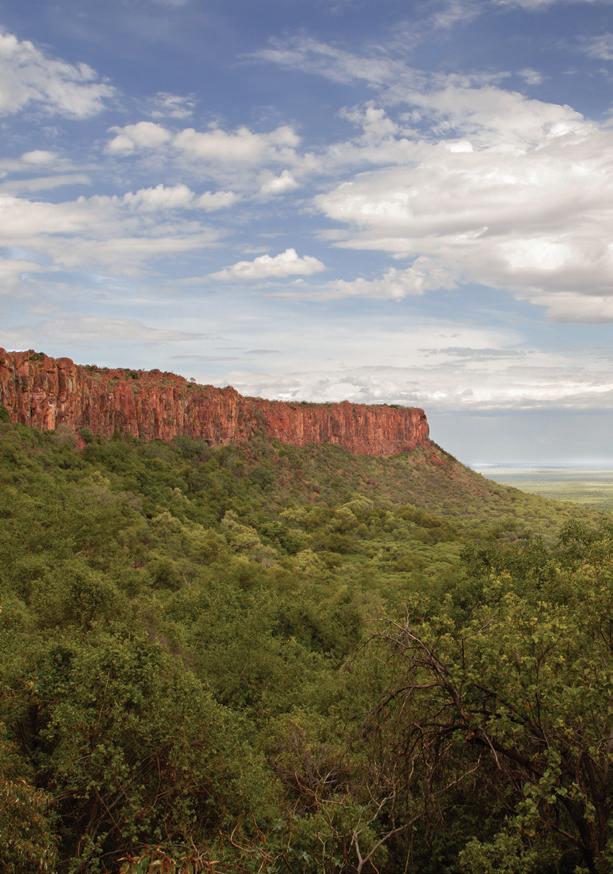
Journey back in time at Waterberg Plateau National Park, where more than 150 million years ago dinosaurs used to roam. Today, this ancient land thrives with a rich variety of plant and animal life, including elusive leopards and herds of sable. As a natural fortress for conservation, this unique park has played a crucial role in protecting endangered species such as black rhino and hosting the reintroduction of wildlife such as eland to the region, all while preserving the region's ecological balance.
Discover the tranquillity of the Namibian bush on the doorstep of Windhoek in Daan Viljoen National Park. It covers an area of acacia bushland in the Khomas Hochland and is home to various game species, including kudu, giraffe and gemsbok. The Augeigas Dam near the park’s lodge attracts over 200 bird species, making it a bird watcher's paradise.
Hikers can explore the park on various trails, such as the leisurely 3-kilometre Wag 'n Bietjie Trail to the Senegal Dam or the more challenging 9-kilometre Rooibos Trail through diverse scenery.
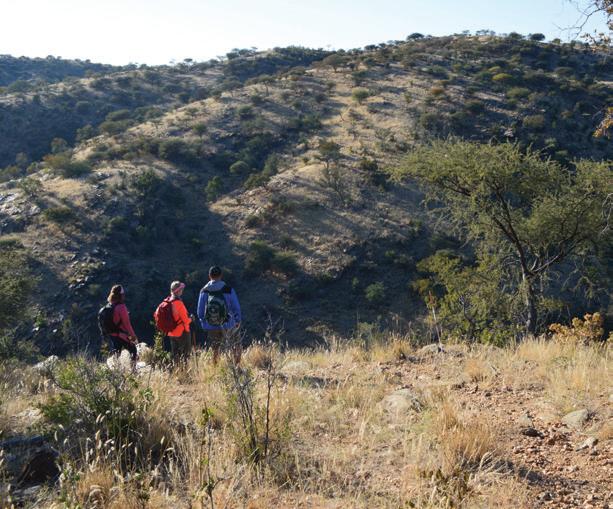
Nestled among the Auas Mountains and just an hour's drive from Namibia's capital, the Von Bach Recreation Area beckons nature lovers and adventurers alike. Its abundant flora and fauna create a haven for bush enthusiasts, while the dam provides thrilling opportunities for water sports and fishing.
Daan Viljoen National Park Waterberg Plateau National Park
Be captivated by the world's largest breeding colony of Cape fur seals at the Cape Cross Seal Reserve. Located near Henties Bay on the coastal stretch between the Swakop and Ugab rivers, this area is famous for angling and for geological wonders. The colony, home to up to 210,000 seals during the breeding season, is characterised by a cacophony of bleats and barks as massive bulls compete for territory and mating rights. Explore the history of Cape Cross, where Portuguese explorer Diogo Cão erected a stone cross in 1486 as one of the landmarks along his voyage of discovery.
The reserve's rich marine life sustains a wealth of birds and animals, including Kelp Gulls, Cormorants, orcas and copper sharks. Lichen fields, nourished by fog rising from the cold Benguela Current, contribute to the fragile desert ecosystem.
Dorob National Park, bordering the Atlantic coastline, is a diverse landscape comprising gravel plains, sandy beaches, ephemeral rivers and colourful lichen fields. It is part of a conservation project along the coastline that also offers adventure and leisure pursuits for tourists. Activities like quad biking, skydiving, windsurfing or kayaking with seals and dolphins provide thrilling experiences.
Despite the aridity implied by its name (dry land), Dorob surprises with rich fishing waters. Anglers are attracted by species such as kabeljou, galjoen and steenbras. The park's conservation efforts include preserving endangered species like the Damara Tern, a nearendemic. The vast lagoon at Walvis Bay is a RAMSAR site. Visitors can also explore the ancient Messum Crater, a volcanic ring complex.
The hauntingly beautiful landscape of the Skeleton Coast Park has remained one of the world's last great wildernesses. With its dunes, rocky beaches and nutrient-rich waters, this coastal gem hosts an abundance of wildlife, including desert-dwelling elephants and rare sightings of lions. Its geological wonders tell tales of ice ages and lava flows millions of years ago, which created a dreamscape of sand and rock that mesmerises visitors. The park's history intertwines with accounts of shipwrecks and survival, adding an air of mystery to its rugged allure. Read more on page 28.
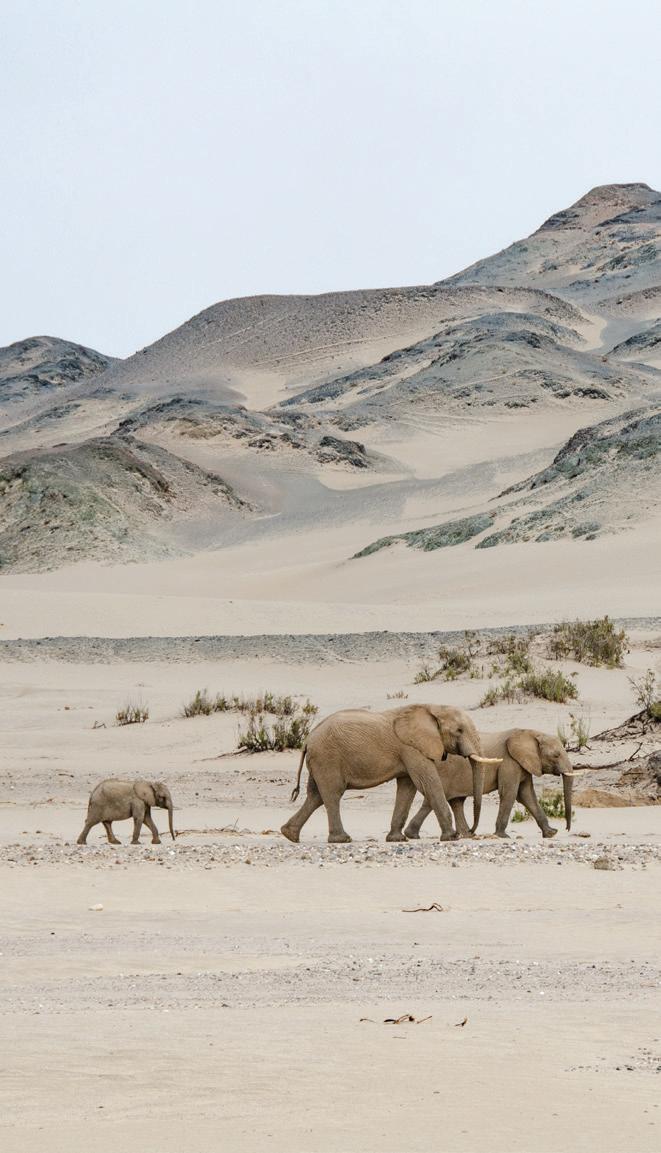
Welcome to the future – in Bwabwata National Park, where wildlife and local communities coexist harmoniously. Located across Namibia’s northeastern ‘arm’, this lush area boasts rivers, floodplains, wetlands and forests. It forms part of the Kavango-Zambezi Transfrontier Conservation Area (KAZA), a five-nation conservation area which houses the world's largest elephant population. Watch hippo-frequented rivers flow gently by, as red lechwe, sitatunga, reedbuck, crocodiles – and hippos – thrive in their natural habitat. Experience the spectacle of Popa Falls on the Okavango River and take guided or unaccompanied game drives to witness the vibrant floodplains and woodland of the Buffalo, Mahango or Kwando Core Areas of the park – each with their own highlights. During seasonal rains, temporary pans on the floodplains offer an ideal setting for birdwatchers, with over 400 bird species recorded. The park's success lies in the comanagement between the Ministry of Environment, Forestry and Tourism, resident communities and conservancies, which is beneficial to both conservation and rural community development.
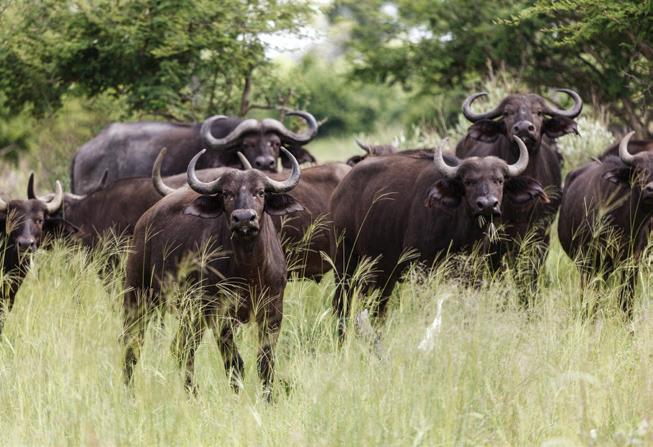
For the true adventurers seeking a raw and authentic African experience, Nkasa Rupara National Park is a dream come true. This vast wetland area offers an extraordinary wilderness waiting to be explored. The park's diverse landscape, from lush marshes and dense savannah to tall river reeds, creates an ideal habitat for an array of wildlife, including large herds of elephants during the dry season. As a vital part of KAZA, Nkasa Rupara National Park stands as a shining example of cross-border cooperation in preserving biodiversity.
Situated southwest of Rundu, Mangetti National Park embodies Namibia's commitment to conservation and
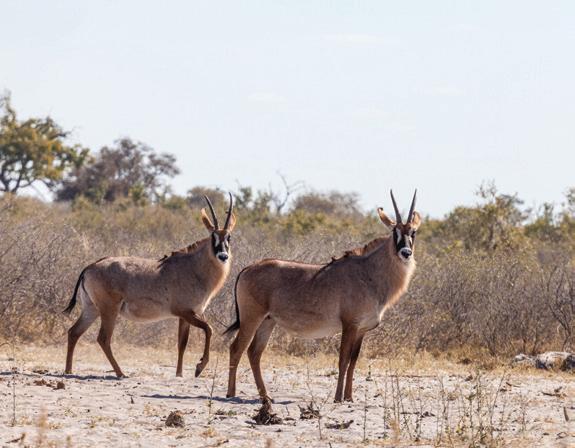
community support. Jointly managed by the Ukwangali Traditional Authority, the park protects wildlife and vegetation while providing socio-economic benefits to local communities. Mangetti offers an abundance of wildlife, including eland, blue wildebeest, leopard, hyena, elephant, rhino, giraffe and the rare sable antelope. Notably, the park is a sanctuary for the African wild dog.
Nestled in Namibia's Kavango East Region, Khaudum National Park remains a hidden gem, rarely visited, and wonderfully wild. Adventurers seeking an off-the-beaten-path experience will find solace here. Traverse rugged 4x4 trails that weave through plains and thick Kalahari forests. Witness large herds of elephants and the endangered African wild dog in this protected haven. Khaudum is unique in that it allows wildlife to pursue hereditary migratory routes, linking Namibia, Botswana and Angola. Khaudum’s open-park system supports various wildlife year-round, including rare species like roan antelope. The park's existence has also fostered conservation-driven community development in surrounding conservancies, benefiting both wildlife and rural communities.
Mudumu National Park boasts an incredible diversity of landscapes, from thick mopane forests to wide floodplains. The Kwando River, the lifeblood of the region, supports a variety of water-loving creatures like elephants, hippos, otters and crocodiles. Rare species, including the red lechwe and sitatunga antelope, thrive in Mudumu's unique ecosystem. The absence of fences allows elephants and other wildlife to freely migrate between Namibia, Botswana and Angola. Lions, leopards, hyenas and wild dogs roam freely, making Mudumu an environment rich in predators. The park's conservation efforts have facilitated the reintroduction of various animal species into the region.
Nkasa Rupara National Park Roan - Mudumu National Park Le Roux van SchalkwykETOSHA NATIONAL PARK: THE SPECTACLE OF WILDLIFE
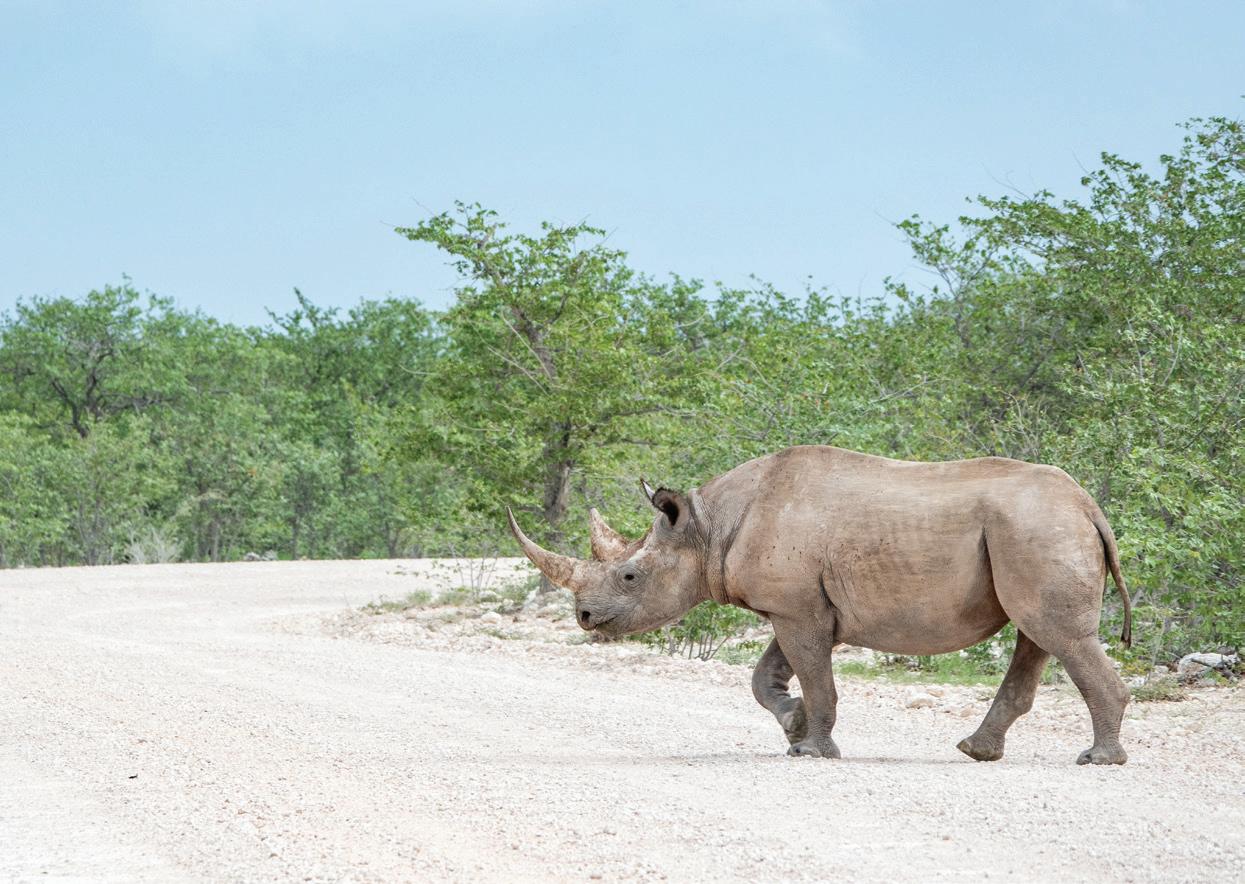
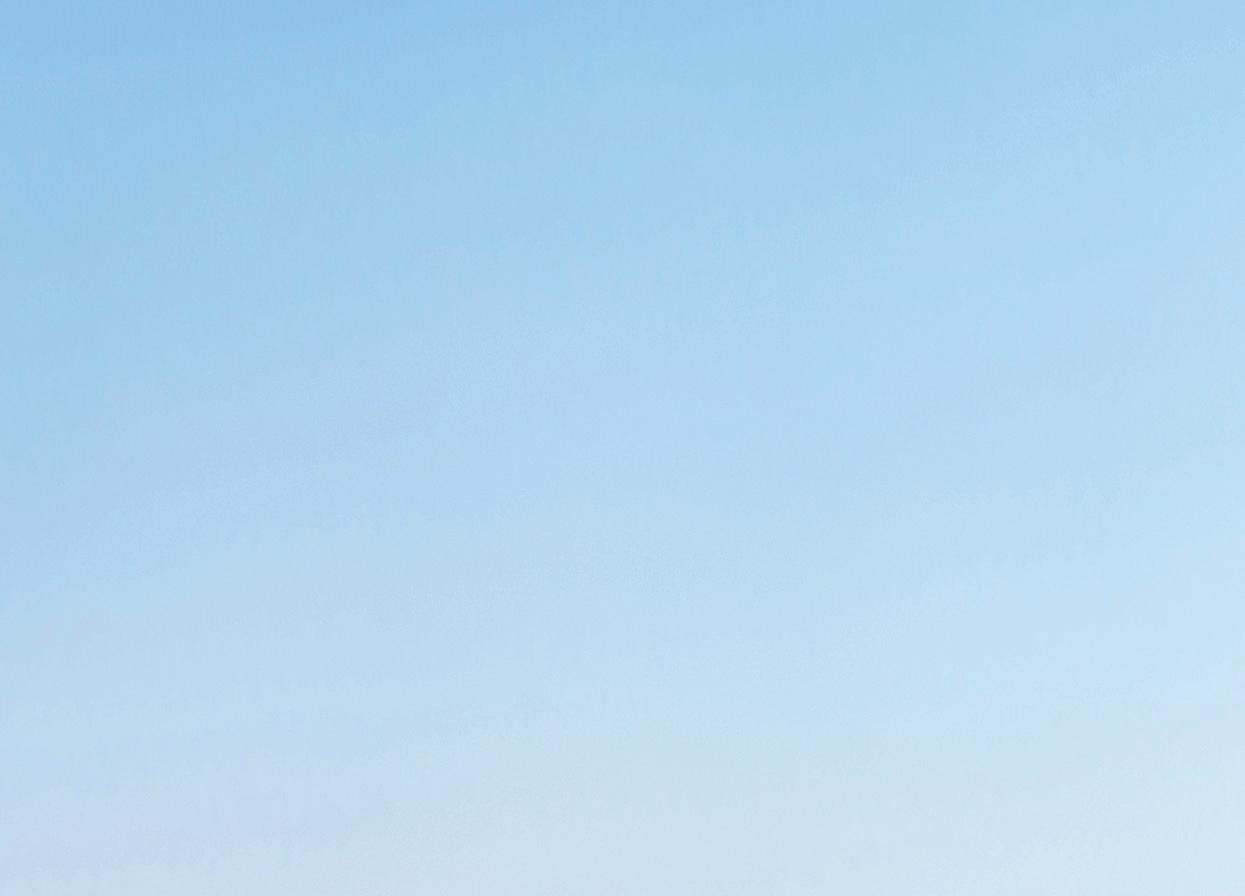
Etosha National Park is certainly the stage for one of the world's most remarkable wildlife spectacles. Here, amidst the vast plains and immense white clay pan, you can encounter herds of elephants, lion prides and members of the largest population of rare black rhinos. Etosha is home to an astounding diversity of wildlife: 114 large and small animal species and 340 bird species. Explore the park's 763 kilometres of open roads and be thrilled by the sight of animals on the plains, at waterholes or traversing the bushlands. Watch wildebeest herds, ostrich flocks and zebras in single file emerge from the heat haze to drink at the edge of the magnificent Etosha Pan. At the park's 86 springs, fountains and waterholes you can witness springbok pronking, jackals prancing and giraffes cautiously approaching the water, trying to elude the large predators that roam the vicinity. Don't miss the chance to experience the magic of Etosha's floodlit waterholes at night – be prepared for unexpected wildlife encounters. TNN
Beyond the allure of adventure lies a profound responsibility to protect the splendour of these untamed realms for generations to come. Read more about each of Namibia’s national parks and conservation areas on www.thisisnamibia.com
Here, amidst the vast plains and immense white clay pan, you can encounter herds of elephants, lion prides and members of the largest population of rare black rhinos.Black Rhino - Etosha National Park

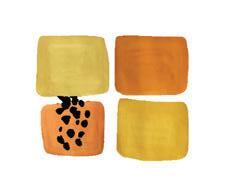

through the car speakers tells fables of new beginnings, of shaking off the dead leaves and growing new hopeful ones. This playlist was created to emulate precisely that feeling, save for the “Like a G6” that more realistically played during that trip.

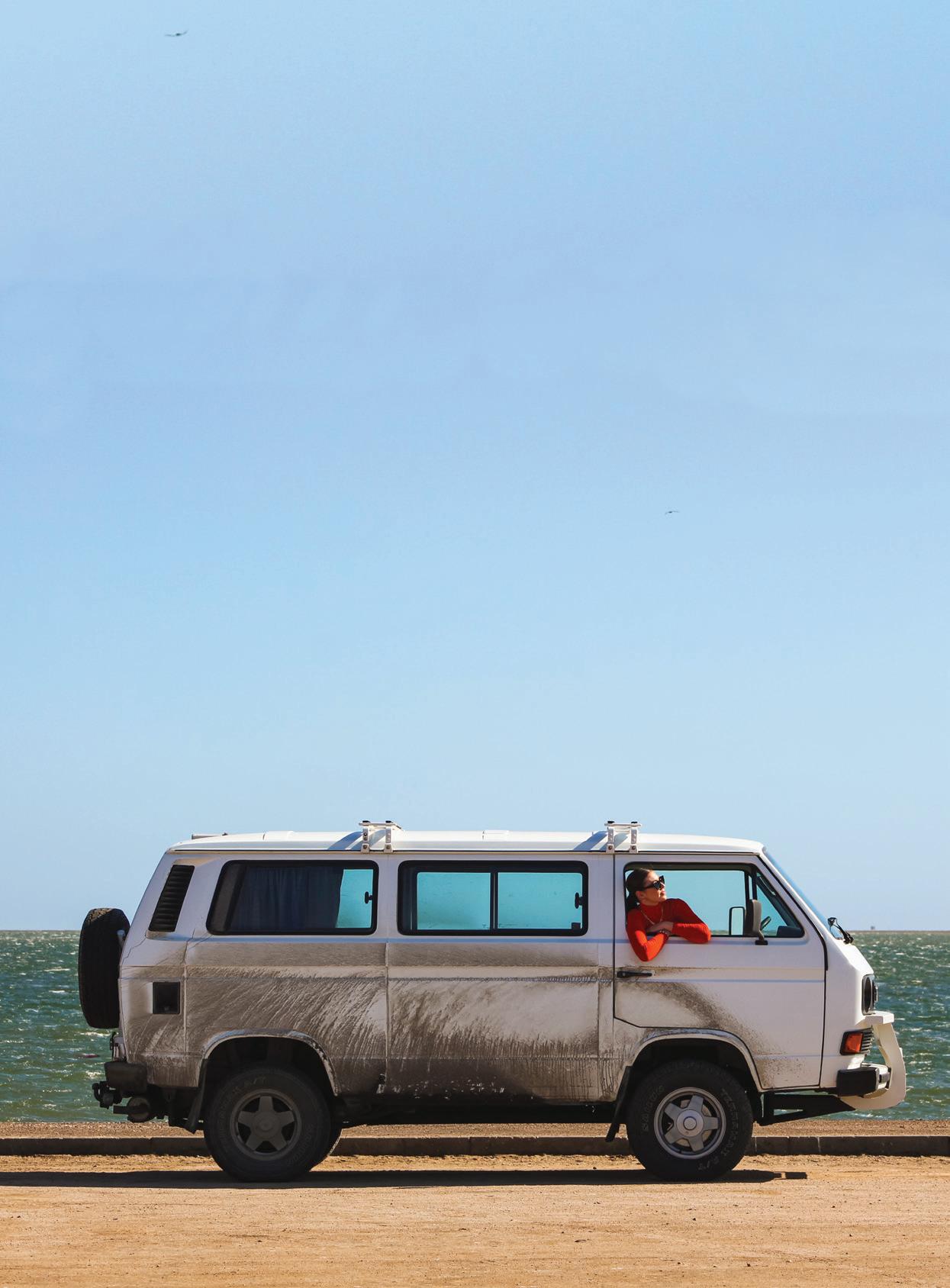
Atlantic Coastin’ playlist you’ll find feel-good, groovy songs that stir nostalgia. A few of my favourites include acoustic melodies and saxophone solos, all driven by electronic rhythms. They start slow, keeping you intrigued with a consistent beat, like the continuous roll of wheels on the road, and build up to a youthful pay off, or as the kids call it, a “beat drop”. What these songs have in common is their subtle synth feel – synonymous with being young, wild and free – and lyrics that link back to beachy vibes.
Our coastline is the pinnacle of care-free and adventurous existence. This long stretch encompasses equal parts lively little towns and long roads between sand and sea. Whether you are going on a short trip or taking to the road for a few hours, let Atlantic Coastin’ bring you a spirit of new beginnings and teenage optimism. TNN


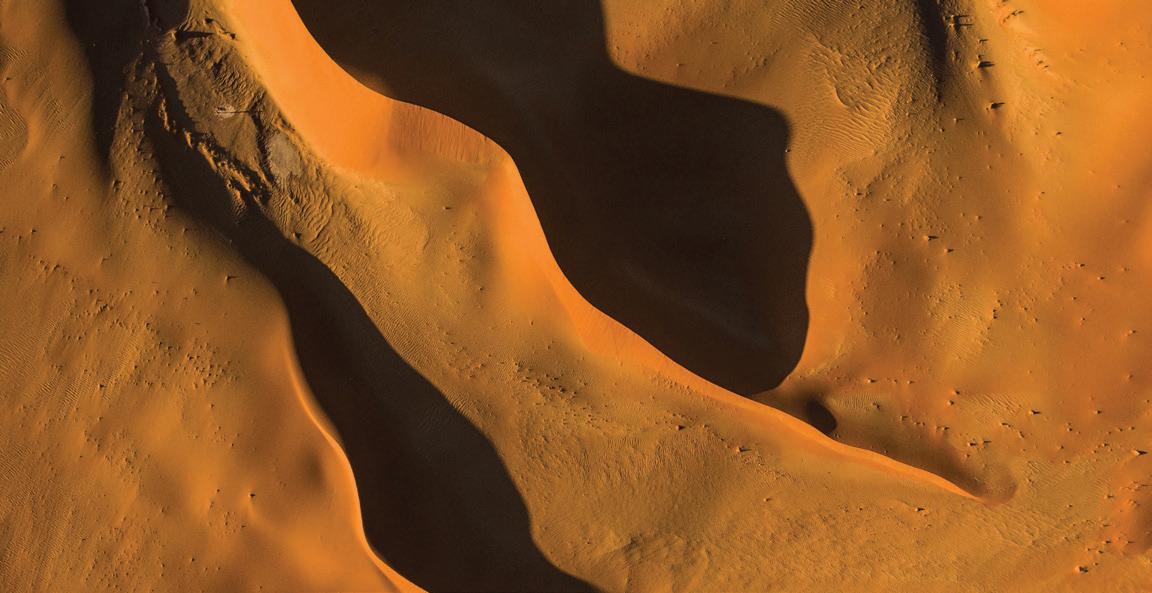


Its numerous national parks and private reserves are a testament to Namibia’s commitment to protecting its abundant and diverse wildlife, which makes it a premier tourist destination for nature enthusiasts. Etosha National Park, home to 114 mammal species, is undoubtedly the most famous of these protected areas. Among Namibia's natural treasures are 220 mammal species, eight of them near-endemic. According to the IUCN Red list, the three truly endemic mammal species are the Namib round-eared sengi (or elephant shrew), Etendeka roundeared sengi and the dune hairy-footed gerbil.
Namibia’s eponymous Namib Desert is renowned for its remarkable dune-dwelling creatures, such as the numerous species of endemic reptiles – 43 in total – that thrive in this harsh environment. Moreover, Namibia boasts a vibrant avian population of 647 species, making it a haven for birdwatchers. Namibia has only one truly endemic bird – the Dune Lark.
However, despite its rich biodiversity, Namibia faces the challenging reality of hosting endangered species. Several creatures on the brink of extinction are found in Namibia. Among them are the African wild dog, black rhino and African elephant.
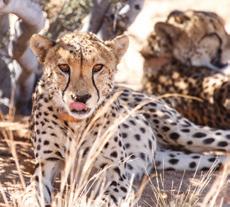
African elephant, black and white rhino are the species most threatened by poaching. Fortunately, conservation efforts have been pivotal in their preservation, and many reserves have successfully reintroduced these majestic creatures. Namibia’s populations have seen encouraging resuscitation.
Namibia also boasts the largest population of cheetahs in southern Africa outside of national parks, offering hope for the survival of this incredible predator. Furthermore, the country sustains numerous antelope species, ranging from the massive eland to the diminutive Damara dik-dik. The striking gemsbok, adorned with symmetrical horns and distinctive black and white markings, proudly graces Namibia's coat of arms.
In addition to these charismatic creatures, Namibia shelters a wealth of smaller mammals, including the elusive mongoose, jackal, antbear and honey badger. They are rarely seen due to their solitary and nocturnal nature.
Namibia's parks and reserves consist of a wide range of environments, from lush woodlands to the barren coastal strip with its monumental sand dunes. Etosha National Park, the great white place, offers a typical southern savannah experience with a variety of plains game and predators. Waterberg Plateau National Park, on the other hand, supports rare animals like the tsessebe, roan and sable antelope.
Protecting its endangered species is crucial for the preservation of Namibia's rich biodiversity and maintaining
ecological balance. The Namibian government, along with non-government organisations and conservancies, has taken impressive steps to safeguard the country's unique wildlife heritage. These efforts contribute not only to conservation but also to the well-being of local communities through sustainable ecotourism initiatives.
Namibia's commitment to protecting its wildlife reflects the nation's dedication to responsible tourism and showcases the true beauty of this vast, diverse and enchanting country. As travellers venture into the heart of Namibia, they actively contribute and become part of the efforts to safeguard these endangered species and the long-term survival of Namibia's precious wildlife, ensuring that future generations will continue to marvel at the wonders of this extraordinary land. TNN
DURING YOUR VISIT:
Here are some of Namibia’s most endangered or vulnerable mammals (there are 57 endangered animal species in total; data from IUCN Red List):
BLACK RHINO (Critically Endangered)

AFRICAN WILD DOG (Endangered)
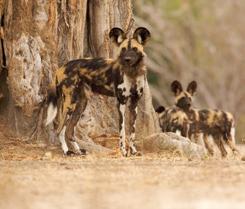
AFRICAN ELEPHANT (Endangered)
EUROPEAN RABBIT (Endangered)
SEI WHALE (Endangered)
BLUE WHALE (Endangered)
CHEETAH (Vulnerable)
LEOPARD (Vulnerable)
FIN WHALE (Vulnerable)
LION (Vulnerable)
GIRAFFE (Vulnerable)
BLACK-FOOTED CAT (Vulnerable)
HIPPOPOTAMUS (Vulnerable)
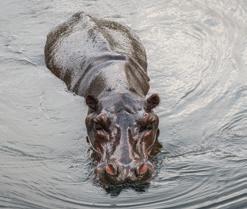
SPERM WHALE (Vulnerable)
TEMMINCK’S PANGOLIN (Vulnerable)
MOUNTAIN ZEBRA (Vulnerable)
Increasing Decreasing Stable

The dust has settled, the bikes have been given their much-needed lube services, and the 9th annual RMB & Wilderness Ride for Rhinos has come to a triumphant close. From May 24th to May 28th and from May 29th to June 2nd, 2023, cycling enthusiasts and conservation advocates united in the vast and rugged Palmwag Concession in northwestern Namibia to raise funds for Save the Rhino Trust Namibia and Children in the Wilderness.
This year's event marked a significant milestone: for the first time two back-to-back multi-day rides were hosted, welcoming a total of only 36 riders, 18 per tour. The exclusivity added an air of anticipation and excitement, as participants geared up for an unforgettable adventure through the breathtaking landscapes of this vital rhino conservation area.
In the vast and untamed heart of northwestern Namibia, where the sky touches jagged peaks and the earth breathes life into the barren wilderness, a timeless battle unfolds – a struggle for the very survival of the majestic black rhino. Against the backdrop of arid desert and rugged mountains, these enigmatic creatures face numerous threats, most notably poaching and habitat loss. Their numbers have dwindled perilously, pushing them to the brink of extinction.
In this precarious situation rhino conservation becomes paramount. Organisations such as Save the Rhino Trust Namibia have taken up the noble cause, dedicating themselves to the protection and preservation of these magnificent animals. But the task is immense. Through tireless patrols, tracking and community engagement they strive to ensure the survival of the last free-roaming black rhino population on Earth. The goal of the RMB & Wilderness Ride for Rhinos is to raise funds and awareness in support of this endeavour.
Thanks to the continued support of its title sponsors, partners and participants, the tour has continued to exceed all expectations for almost a decade. RMB has been the tour's title sponsorship since its inception, their dedication mirroring their commitment to supporting causes intrinsic to community development and the success of Namibia as a whole. Wilderness, renowned for its commitment to
preserving and protecting the world's iconic wilderness areas, has also been a steadfast supporter of the event since its inception in 2015. Their unwavering dedication to rhino conservation and community initiatives shine through every aspect of the event.
The tour, an ideal event for avid mountain-bikers with an equally enthusiastic passion for nature and conservation, has an overarching theme which emphasises the importance of raising awareness for Namibia's black rhino population and the crucial role that community involvement and education play in conservation efforts, especially in this remote, rural region. The Ride for Rhinos serves as a powerful platform for collaboration and partnerships between corporate entities, influential Namibians and the projects and associations that the tour aims to raise funds and awareness for.

Throughout the four-day event participants are treated to an immersive experience in nature, embracing the rugged beauty of the Palmwag Concession. Starting from a bush camp – where the group spends three of the four nights wild camping – nestled within this extraordinary landscape, cyclists embarked on daily rides of 40-50 km. The diverse terrains, including dry riverbeds and challenging single track game paths, tested their skills and rewarded their efforts with awe-inspiring vistas and wild encounters at every turn. But this event is about much more than the thrill of the ride. It is an opportunity to make a tangible difference in the fight against poaching and the preservation of the critically endangered black rhino. The proceeds from the tour are equally divided between Save the Rhino Trust Namibia and Children in the Wilderness, reinforcing a commitment to both rhino conservation and community development.
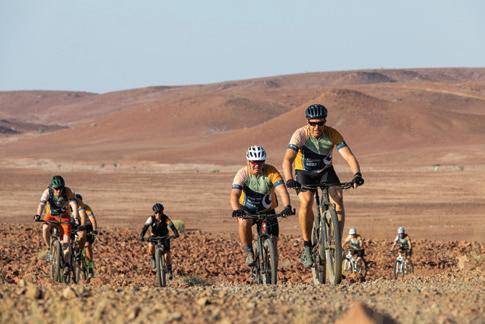
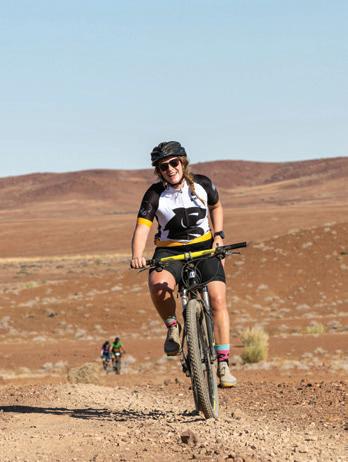


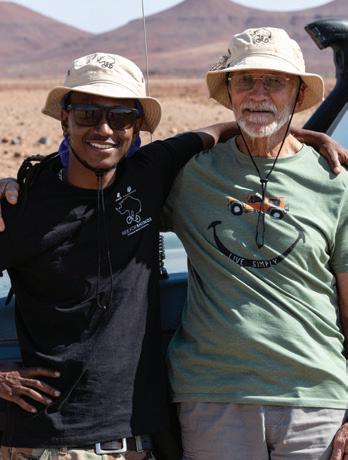
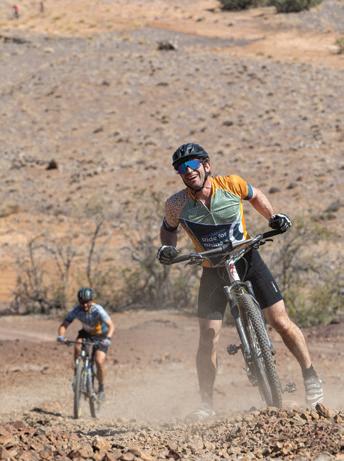



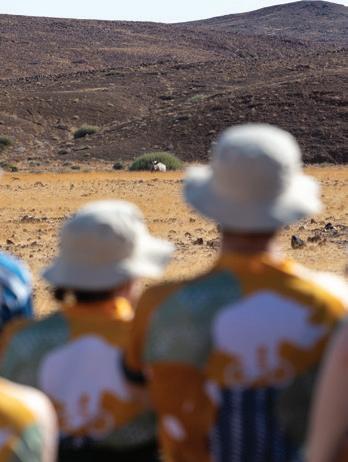 Super Crew - Martin and Le Roux
Wilderness Chef Annemarie and Jan Braai
Rookie surprise - Nina Louw
Odile and Dan
King of the Hill - as tough as it looks
R4R Veteran - Angelique Peak
Super Crew - Martin and Le Roux
Wilderness Chef Annemarie and Jan Braai
Rookie surprise - Nina Louw
Odile and Dan
King of the Hill - as tough as it looks
R4R Veteran - Angelique Peak
The Wilderness Desert Rhino Camp, the tour's final destination, holds a special place in the hearts of the organisers and past and present participants. It stands as a symbol of collaboration and success, a testament to the vital role played by Wilderness, Save the Rhino Trust and the Anabeb, Sesfontein, and Torra conservancies in protecting the desert-adapted black rhino population. By supporting the camp, guests not only contribute to the preservation of these iconic creatures but also uplift the local communities through employment opportunities and sustainable growth.
Apart from the daily cycling routes, the tour also offers guests the opportunity to go rhino tracking with the Save the Rhino Trust rangers and enjoy life-changing encounters with the ancient denizens of these rugged terrains. On foot, the guests on the first tour had the incredible experience of approaching not one, but two rhino bulls and watching from an unobtrusive distance as they went about their afternoons. The next morning, for only the second time in nine years, the group came upon the same rhino while out on their bicycles. It is an incredible experience to be able to share the terrain with these special creatures. The second tour had equally magnetic moments with the event’s eponymous mammals.
This year, special emphasis was placed on the tour’s other beneficiary – Children in the Wilderness. CITW is an inspiring initiative that aims to connect children in Namibia with their natural heritage and foster a sense of environmental stewardship. With a focus on conservation education and community engagement, this program has made a significant impact on the lives of the children involved as well as the ecosystems they inhabit. Namibia, a country known for its vast landscapes, diverse wildlife and rich cultural heritage, provides an ideal backdrop for this transformative project. The program focuses on children from rural communities near key wildlife areas, such as the northwest. By engaging with local schools and communities, the project creates an immersive experience that combines education, practical skills and hands-on conservation activities.
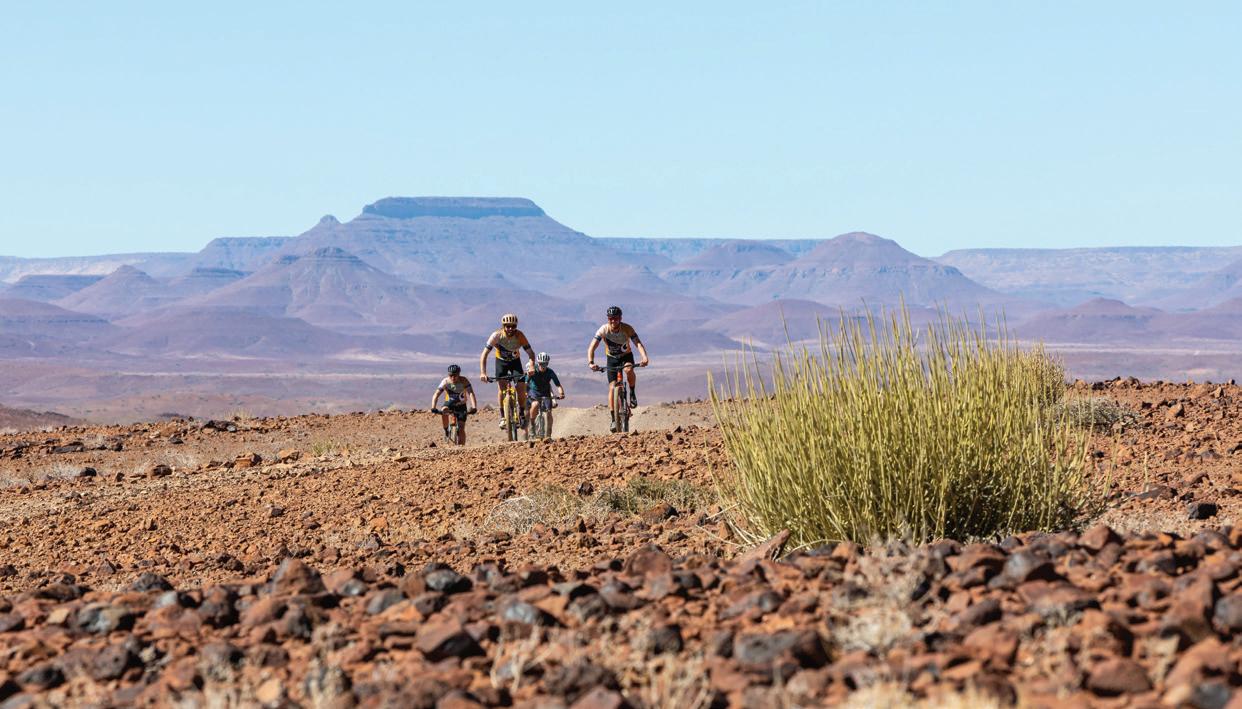
One of the primary goals of the project is to instil in children a deep understanding and appreciation for their natural
surroundings. Through interactive workshops, wilderness camps and mentorship programs they are exposed to various aspects of conservation, including wildlife biology, environmental sustainability and the importance of preserving biodiversity. These experiences serve to inspire a sense of responsibility and a desire to safeguard their natural heritage for future generations.
Each time a Ride for Rhinos event comes to an end, feelings of accomplishment and camaraderie permeate the air. Riders and organisers gather around the campfire, sharing stories of their experiences and how their first-hand introduction to this region has reshaped their views on conservation. The success of the 2023 Ride for Rhinos was made possible by the unwavering support of RMB Namibia, Wilderness, CYMOT (providing technical MTB support), Venture Media as tour organisers, and numerous other generous supporters. Their collective efforts and dedication to rhino conservation have propelled this event forward for nearly a decade.
With each passing year, the Ride for Rhinos grows in significance and impact. It serves as a beacon of hope, uniting individuals in the fight to protect these magnificent creatures and preserve the biodiversity of Namibia's northwest. The struggle for rhino conservation in the region is an arduous one, fraught with challenges and obstacles. Tough terrains and even tougher economic circumstances. However, it is a battle that must be fought. By supporting initiatives like Save the Rhino Trust Namibia and Children in the Wilderness, we can help protect these extraordinary animals and educate and support the communities that share this homeland with them, ensuring their continued existence for generations to come. Together, we can preserve the natural heritage of this region and safeguard the delicate harmony of its wildlife and ecosystems.
As we reflect on the accomplishments of the 2023 event, we look to the future with renewed determination, knowing that together we can make a difference for the black rhino and the communities that depend on its survival. TNN
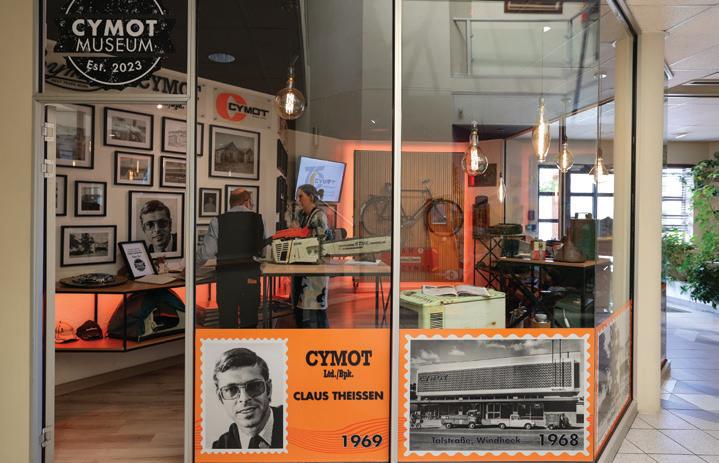

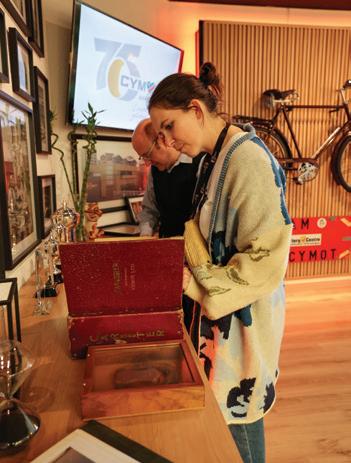

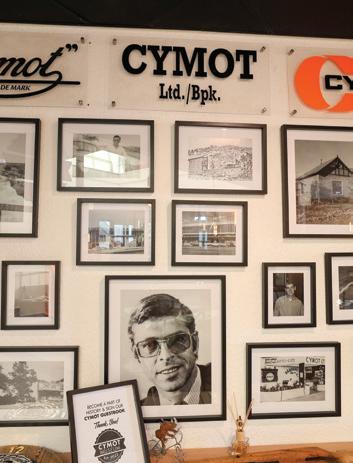
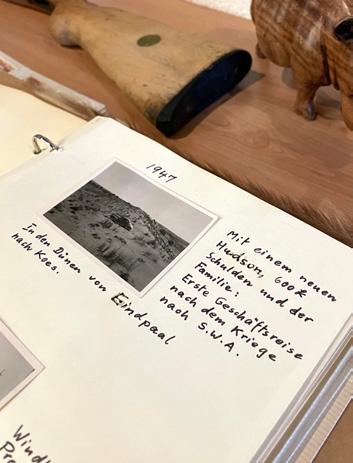

Ajourney through time, an emblem of innovation, a chronicler of culture; this is the essence of what CYMOT embodies and what you will find when stepping through the door to the recently unveiled CYMOT Museum. Housed in a refurbished corner of their head office in Windhoek’s northern industrial area, the CYMOT Museum celebrates 75 years of the company’s existence, and in many ways, 75 years of Namibian history itself.
From the moment you walk into the room, you're greeted by a wave of nostalgia. Filled to the brim with artefacts and photos, the space comes alive with tales of achievement and perseverance. The walls narrate the company's journey, resonating with the impact it has had on the nation.
On display is evidence of manual stock-taking systems from bygone eras, reminders of simpler times when lunchtime table tennis tournaments brought joy and camaraderie. Shelves upon shelves display classic photo albums brimming with memories. These pages of history don't just recount the story of a company, but the story of Namibian people and their relentless pursuit of excellence.
It all began with Helmut Brass in 1948, with nothing more than his family and £600 in debt, they set off for South West Africa from South Africa in a new Hudson. Through desert sands and across vast plains they voyaged to an uncertain future. From selling Autolite car batteries out of his residence to opening CYMOT's first official branch in 1950, the company's journey mirrors Namibia's growth itself. In 1958, groundbreaking innovation saw them importing and distributing Irvin Safety Belts, a testament to CYMOT's commitment to pioneering change.
As you move through the museum, you'll find evidence of this first ever car seat belt marketed in Namibia, along with a myriad of other vintage odds and ends. A 40-year old Engel camping fridge donated by Le Roux van Schalkwyk is displayed with
pride of place. The fridge is still running today. The beers cheekily stored inside are perfectly chilled upon inspection.
The faces of 75 years worth of employees and their achievements add a human touch to the corporate tale. Alongside, an iconic box iMac, juxtaposed with Mr Claus Theissen's secretary's old typewriter, evokes a sense of transition from the old to the new.
A vintage bicycle, with automated turning wheels, is mounted against a feature wall, reminding visitors of CYMOT's dedication and ingenuity in importing bicycles to Namibia. Each artefact tells a story of progress, of embracing new beginnings without losing touch with the past.
CYMOT's history is a tapestry of growth, expansion, and innovation. From Claus Theissen to Axel Theissen's 20-year service as Managing Director, leading to the current CEO, Ralph Ellinger, the baton has been passed with integrity and foresight. The new flagship branch at Hilltop Estate will stand as an example of the company's ongoing commitment to growth and innovation.
As the museum reflects on the past, it also symbolises a bright future for CYMOT. A company deeply rooted in serving its customers, impacting local communities, and consistently innovating, it remains well-positioned to carry on its success story.
The CYMOT Museum is not just a place but an experience. A vivid representation of Namibian pride, industry, and human spirit. It is a celebration of 75 years of courage, resilience, and innovation. As you walk out of the museum, you carry with you a piece of Namibian history, a sense of shared identity, and an overwhelming inspiration to look towards the future with hope and ambition. CYMOT invites those who are eager to celebrate its 75th anniversary and the shared history of Namibia to come visit their new museum at their head office. TNN
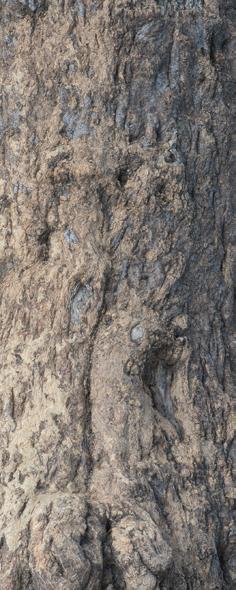
In this series we explore the beauty of trees with our beloved local nature-enthusiasts and authors, Helga and Pompie Burger. Each with a unique voice and opinions on how best to identify the trees of the Kavango and Zambezi, Helga and Pompie help us through the tricky trials of identifying northeastern Namibia’s most iconic flora.


Apiece of cake for me to identify it in the south of Namibia since there are millions of them. It is another ball game altogether in the north-eastern part of the country. Contrary to being conspicuous as they are in the south, the shepherd’s tree is well-hidden in the woodlands of the north. Not only is the shape often more slender, but the leaves also tend to be hanging down on strings – giving the tree a much softer look than its southern counterpart.
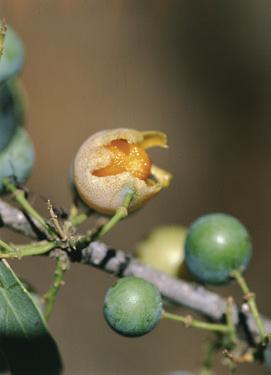
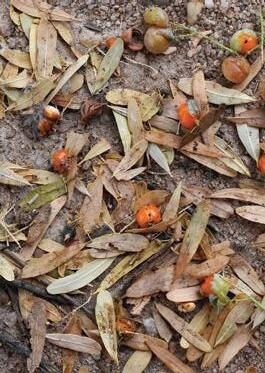 - Helga Burger
- Helga Burger
One of the better known trees in Namibia. Somehow, they are larger in the north (more water?), with a less impressive trunk but greener leaves, much more fruit and looking much happier than in the south. When the tree turns light green, whereas it has an olive colour in summer. The fruit is usually packed on the stems like coffee beans.
- Pompie Burger Small yellowish green flowers on very short stems Olive green and dome shapedSCIENTIFIC NAME: Boscia albitrunca
AFRIKAANS: Witgatboom
GERMAN: Hirtenbaum, Weißstamm
KWANGALI: Munkudi
LOZI: Katemabakulu
STRIKING FEATURES OF THE SHEPHERD’S TREE
• Bark is pale to white
• Larger in north-eastern Namibia than in the south
• Covered with flowers in spring, giving it a buoyant light green appearance
• Hundreds of fruits envelop it in early summer
MAP GUIDE Main road
Tree density in various areas
SEASONS OF THE SHEPHERD’S TREE
DRINK & DRIVE
• A sturdy single trunk with light bark
• Olive green and dome shaped
• When in flower it has a light green almost yellowish colour
• It typically shows a clear browse line
STOP & STARE
• Fruit is packed on the branches in clusters
• Berry-like globose fruit green at first later turns into shades of yellow
• Fruit is edible and loved by birds
TOUCH & TASTE
• Small yellowish green flowers on very short stems
• Flowers in dense clusters
• Flowers glistening with nectar
DOWN UNDER
• Fruit (half eaten) under the tree shows bright orange flesh
• Leaves are elliptic with rounded tips
• Leaves are rigid and leathery
This article is an extract from The unbearable beauty of trees: 56 magnificent trees of Kavango and Zambezi written by Helga Burger, published in 2020.
To order The unbearable beauty of trees , contact Bonn at bonn@venture.com.na

Where to find Shepherd’s Trees in the northeast
Enhancing capacities and empowering young African wildlife veterinarians
 Text & Photographs Giraffe Conservation Foundation
Text & Photographs Giraffe Conservation Foundation
Being a wildlife veterinarian in Africa is a tough job! You have to be flexible, resourceful and work in often extremely remote areas under challenging conditions. And to make matters worse, training opportunities are very limited, so most wildlife vets end up training on the job. They must understand a vast diversity of species, from the smallest antelope to lions to elephants; and that does not even consider the reptiles and birds that also come into the mix. Then there is the giraffe – darting, immobilising and treating the world’s tallest animal adds an entirely different level of complexity to the task and increases the challenges exponentially. As if that were not enough, African wildlife vets are frequently required to work in remote and isolated settings, often with little experience or training in the safe handling of dangerous drugs, darting and capture equipment or species-specific protocols. It can feel like what one might imagine walking a tightrope without a safety net while juggling knives may feel – daunting.
The limited training opportunities in African wildlife medicine are generally expensive, restricting access for many veterinarians in Africa. Luckily for Namibia, things are looking a little different here. We boast a network of highly experienced wildlife veterinary professionals in our country, as well as the School of Veterinary Medicine at the University of Namibia (UNAM), which offers a solid introduction to wildlife medicine. As a result, Namibia is well placed to support local capacity and build that of wildlife vets from other parts of Africa.
Founded and headquartered in Namibia, the Giraffe Conservation Foundation (GCF) is dedicated to securing a future for all giraffe populations in the wild. It is the global leader in giraffe conservation. GCF started off by monitoring Angolan giraffe in the remote northwest of Namibia in what has become the longest long-term ecological effort of monitoring giraffe in Africa. While giraffe populations in Namibia are doing well, the GCF team quickly realised that the same is not the case in most other parts of the continent. From its humble beginnings in northwestern Namibia, GCF now actively implements and supports giraffe conservation initiatives in 19 African countries, often requiring the services of wildlife
veterinarians as part of the conservation team. “Due to their unique physiology, giraffe can be particularly difficult to immobilise”, says Dr Julian Fennessy, GCF's Co-founder and Director of Conservation. “To ensure their safety, we often bring along vets from Namibia or South Africa when working in other African countries. The problem is not a lack of local vets, but often there is limited expertise in handling giraffe and other wildlife, or simply a lack of confidence. Confidence that can only be developed through practical experience.”
Since this approach is unsustainable for a long-term conservation impact, GCF approached partners in Namibia to take matters into their own hands and develop a training course for African wildlife vets. In 2022, in partnership with UNAM and the Namibia University of Science & Technology (NUST), GCF organised the first dynamic, practical wildlife immobilisation course tailored for young African vets. The second course was successfully conducted in June 2023. Both courses hosted eight aspiring wildlife vets from seven and eight African countries respectively, who were mentored by a similar number of highly experienced wildlife veterinary and conservation experts. Participants experienced a unique training opportunity. They hailed from the Central African Republic, the Democratic Republic of the Congo, Ethiopia, Malawi, Mozambique, Namibia, Nigeria, Tanzania, Uganda and Zambia.
The 10-day intensive course was designed with the Lao Tzu philosophy in mind: Give a man a fish and you feed him for a day; teach a man to fish and you feed him for a lifetime. Each participating African vet was given the opportunity to lead the planning and immobilisation of at least one animal under the guidance of an expert vet. Open debriefing discussions after each immobilisation offered ample opportunity for a peer-topeer skills exchange, analysis of what worked well and what did not, including the effects of different drug regimens used for comparison. Each of the participants contributed a host of real-life experiences from the workplace in their respective country to the discussions, creating a conducive and productive training environment. Furthermore, the participants gained extensive practice in dart gun handling and safety, as

The overall objective of the course is to empower young African wildlife veterinarians to become innovative leaders in conservation and thus secure a bright future for Africa’s wildlife.
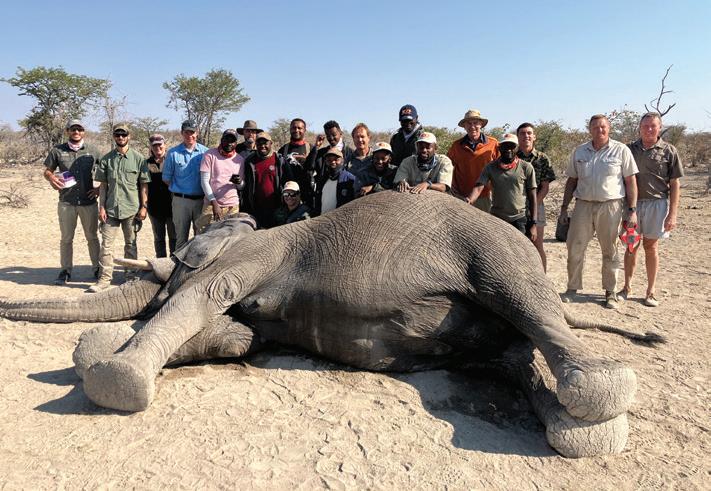
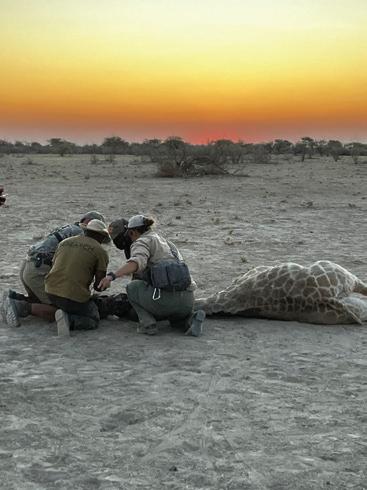


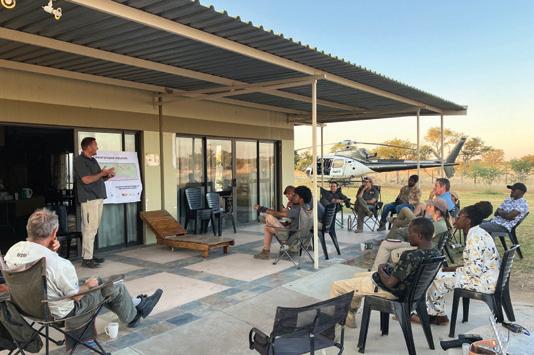
they practised darting from the ground, a vehicle and from a helicopter. They also had lectures on species-specific protocols and human safety protocols. The aim was to provide a unique opportunity for participants to develop wildlife veterinary and leadership skills through inclusive mentoring by experienced wildlife veterinarians, biologists, conservationists and game capture experts.

The course was hosted at the Etosha Heights Private Reserve adjacent to Etosha National Park. All immobilisations for the course were undertaken as part of planned reserve management activities and landscape-level long-term conservation research programmes, spearheaded by the NUST Biodiversity Research Centre and GCF. This allowed for a variety of experiences with multiple species including gemsbok, Hartmann’s mountain zebra, greater kudu, common eland, African savanna elephant, white rhino, African lion and, of course, Angolan giraffe. And most importantly, thanks to the amazing level of skill and expertise on hand, no animals were harmed in the process!
As part of this year’s course, in collaboration with Integrated Rural Development and Nature Conservation (IRDNC) and the Game Capture Unit of the Ministry of Environment, Forestry and Tourism (MEFT), four Angolan giraffe, donated by the Etosha Heights Private Reserve, were moved to the Ogongo and Otjiu-West communal conservancies in northwestern Namibia. On arrival, the local community excitedly welcomed the giraffe and pledged its commitment to their protection.
“This operation was an amazing collaboration of many Namibian and international partners. Partnerships and collaboration are immensely important for successful
conservation actions. A private landowner donated the four giraffe, with the vision of repopulating the vast communal lands of northwestern Namibia. The operation was made possible by international donations and put into action with the help of the MEFT game capture unit. When the four giraffe stepped out of the truck, the joy on the local community members’ faces was incomparable to see”, Stephanie Fennessy, GCF’s Co-founder and Executive Director, recalls.
The overall objective of the course is to empower young African wildlife veterinarians to become innovative leaders in conservation and thus secure a bright future for Africa’s wildlife. Dr Dominique Tshimbalanga, a vet from DRC and 2022 participant, is a prime example and a measure of success for this. “I always wanted to get involved in wildlife veterinary medicine”, he said. However, the closest he was able to get was caring for the canine anti-poaching unit for Garamba National Park, DRC. Everything changed when he had the opportunity to attend the Wildlife Medicine Course in 2022: The training and experience gained earned Dr Tshimbalanga a promotion to Resident Veterinarian of Garamba National Park. “GCF has given me the key – now it is up to me to use it”, he beams.
The course was fully funded by GCF through its donors (including the Firstrand Namibia Foundation Trust). Participation is exclusively by invitation. Both field courses were generously supported by the African Wildlife Conservation Trust, African Wildlife Services, MEFT, UNAM's School of Veterinary Medicine, Wildscapes Veterinary and Wildlife Veterinary Foundation with valuable veterinary technical skills and mentorship. A special thanks goes to Etosha Heights Private Reserve, Natural Selection, NUST and UNAM's School of Veterinary Medicine. TNN
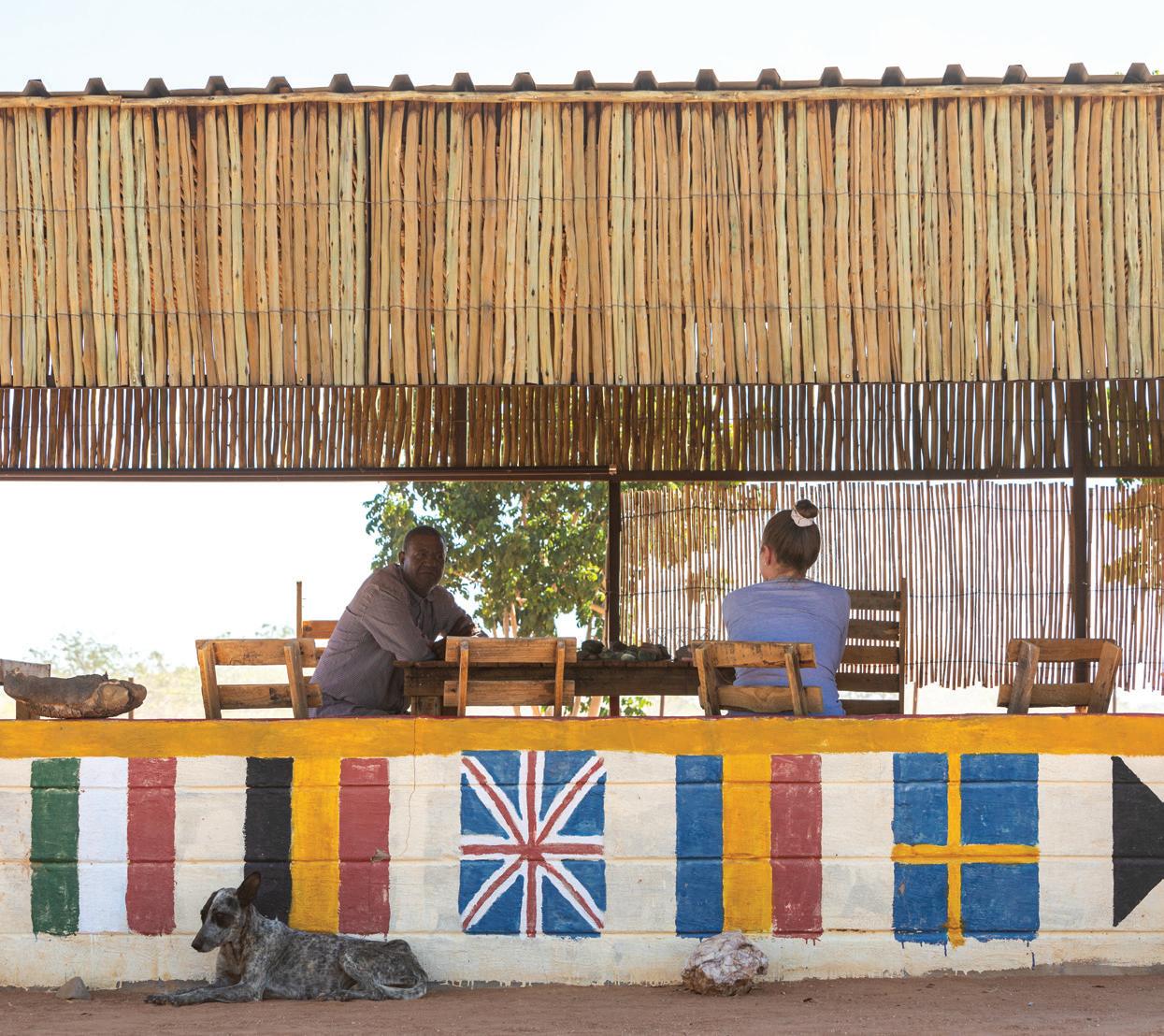
A simple pleasure of driving along one of Namibia’s countless gravel roads is the humble padstal –Afrikaans for a roadside shop. They come in many shapes and sizes, offering anything from biltong (essential padkos or “road food”) to small-batch homemade jams and condiments, or even coffee shops and lunch spots. I am a firm believer that some of the most authentic travel experiences come from taking a moment to spend with locals, especially when it means supporting a small business.
Along the C39 road in Damaraland, en route to Twyfelfontein, Palmwag or the Skeleton Coast National Park, lies one of these special stopovers. Just 22 km west of Khorixas is the Petrified Forest Coffee Shop. Owned and run by local couple Eddy and Letty Tsibeb, they serve coffee, soft drinks and beer. And on special request, a loose cigarette.
One of the perks of driving slowly on our gravel roads (other than the obvious breathtaking scenery) is being able to stop at a moment’s notice to pull off the road for a coffee. This quaint little coffee shop is adjacent to the family’s home on the property, where kids and quintessential Damaraland dogs make for a welcome sight. The colourful cabana-style shop is adorned with hand-painted flags, including the Union Jack and Germany, and is shaded with a roof while allowing a breeze to pass through and offering views of the surrounding area.
A few wood tables and chairs are sheltered by the prep and serving area, which boasts a beautiful bamboo tiki-style bar from the 70s which was gifted to Letty. The couple sells gemstones and fabric dolls, and they have also recently invested in a small swimming pool, which is set to be inaugurated and ready for a dip very soon.
Eddy and Letty have big dreams for their property. “You see that hill?” asks Eddy while pointing in the distance, “One day I will build a lodge up there.” In anticipation of the day they can break ground on a lodge, the couple is hoping to engage investors to assist with building a few campsites. If you like the sound of having a stake in a small-scale camping operation in Damaraland which will uplift the community and realise humble dreams, reach out to Eddy and Letty. They epitomise rural hospitality! TNN
Planned your itinerary to pass by Petrified Forest Coffee Shop? Eddy and Letty serve lunches on pre-order, so give them a call to reserve a meal before you are headed through the area. Individuals or groups who are interested in collaborating are invited to contact them on these numbers, joining Eddy and Letty in their passion and vision for their property. Eddy Tsibeb: +264 81 6923018
Letty Tsibeb: +264 81 4964507
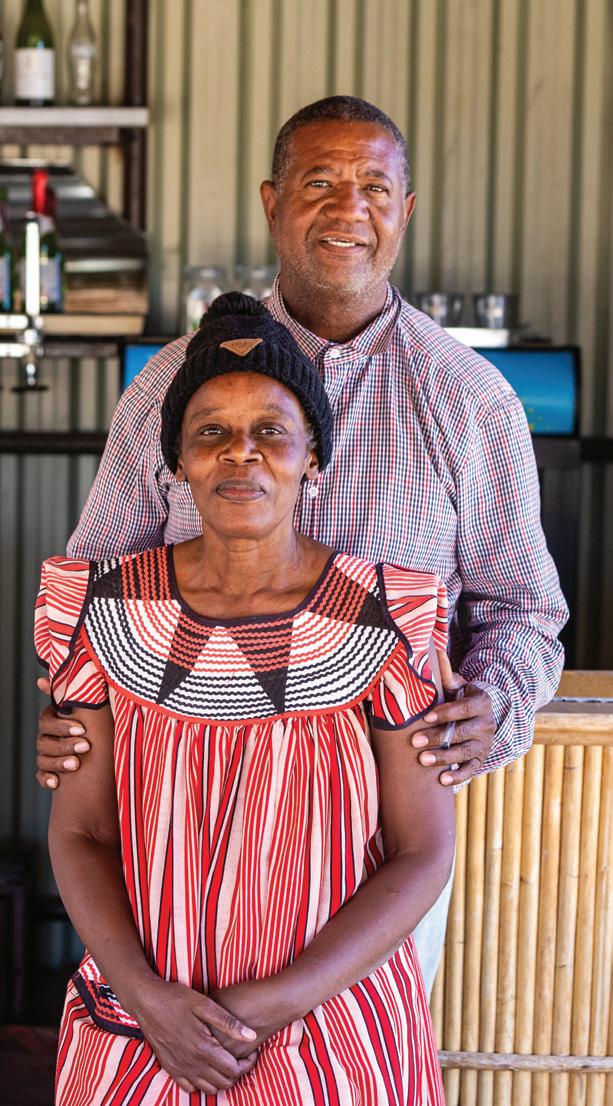
 Text & Photographs Elzanne McCulloch
Text & Photographs Elzanne McCulloch
Travelling experiences are like a rich tapestry of interwoven moments, stitched together like colourful threads to create a beautiful diorama. A story unfolds, the minute details of which combine to imprint itself on our memories. I experienced this sensation again on a recent family retreat to the forlorn and yet vibrant wonders of the south, where key moments stood out against the collective experience and became chapter headings of a wonderful memory.
The drive from Windhoek towards Namibia’s southern gem of Sossusvlei is among my all-time favourite Namibian trips. Heading south from Windhoek, through the “picture bridge” and on towards Rehoboth, the landscape opens up into a vast panorama. The odd outcrop seems to only accentuate the flatness of the surrounding plains. From the main road our journey takes a south-westerly turn and soon we reach the mountainous landscape that precedes the best view in Namibia – Spreetshoogte Pass. The meaning of the word “vast” is powerfully entrenched in our minds as we gaze in wonder over the endless terrain spread out before us. Straight ahead of us lie uninterrupted plains, but shifting our gaze towards two o’clock, we marvel at a swath of navy mountains, layered in depth and different hues of blue. A vision of freedom.
Before we reach the Sossusvlei area, another iconic landmark lies in wait along the dusty roads that criss-cross these southern landscapes. An unassuming but by-nowfamous apple crumble awaits at Moose McGregor’s Desert Bakery at Solitaire. My sister-in-law pops into the bakery to stock up on this must-have as we refuel, while my oneyear-old runs after the Sociable Weavers that hop around
on every available service. Solitaire is an oasis in this dry locale – home to a petrol station, shop, accommodation, restaurant, tyre service centre, restrooms and the iconic bakery. Standing sentinel, a windpomp slowly turns in the slight afternoon breeze.
Not far from Solitaire we find our resting place for the night. Even though we are not too tired after the three-hour drive from the capital, it is nice to stay over somewhere comfortable. Wandering along the way, and all around the lodge, are the denizens of the south (and most other regions of Namibia) – the gemsbok. In the vast amber expanses of Namibia, where dunes rise, valleys fall and the horizons blur into eternity, the gemsbok stands as a regal emblem of the desert’s untamed beauty. This majestic antelope, with its long, slender horns stretching towards the cerulean sky, embodies the spirit of resilience. As the sun casts a golden sheen over the desert sands around us, the gemsbok meander about, their silhouettes shimmering against the backdrop of dunes and mirages. Its very existence is a testament to the miracles of adaptation, thriving where few dare to tread.
That evening at dinner, we met another denizen of the south. No sooner had we sat down at our table when the friendly chef, with laughter lines etched deep into her skin, made her way over to us. With a spread of tantalising dishes adorning the buffet table, she shared stories of how her mother used to cook and how lekker was nog nooit sleg nie (translated: delicious food is never a bad thing). The tradition of making simple dishes well was passed down through generations in her family and one can see by the light shining from her eyes that making people happy through homely meals is her ultimate joy. And that is what our dinner was: pure joy. It was more than food; it was a communion of tales, tastes and traditions. Made all the more special by the presence and prose of the chef and her stories. A few more unique threads woven into our tapestry.
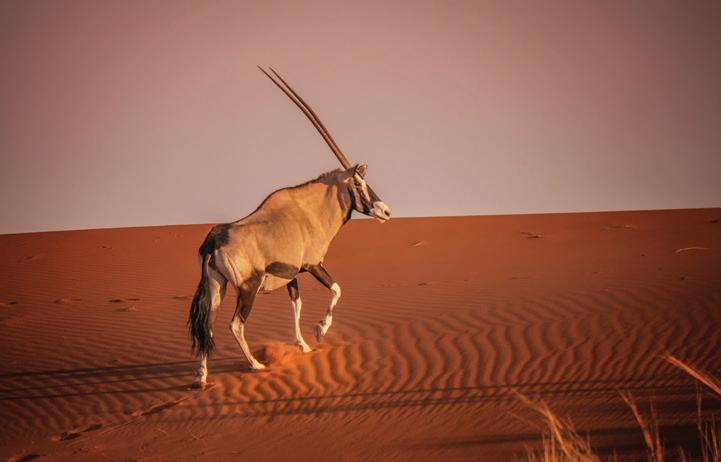
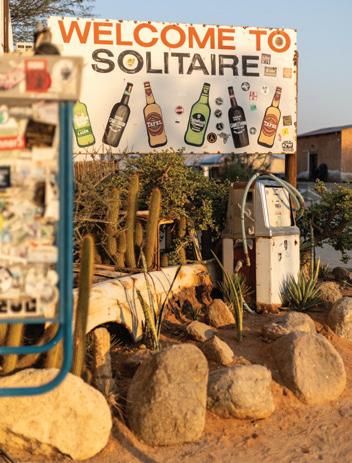
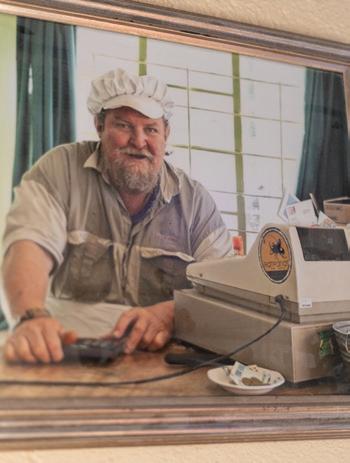

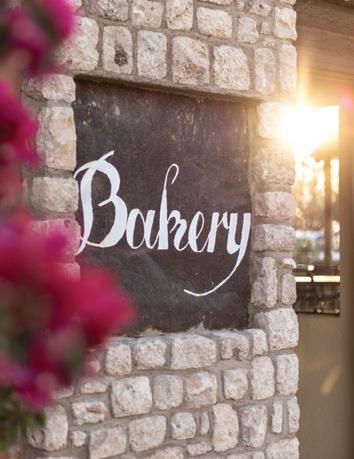
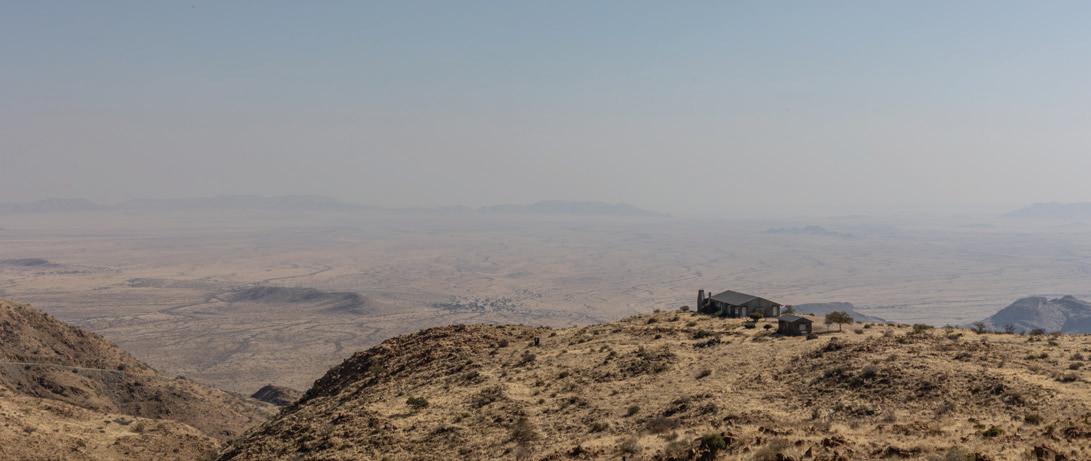 Moose McGregor’s Desert Bakery at Solitaire
Moose McGregor’s Desert Bakery at Solitaire
Rising early the next morning to beat the heat and the rush, we set off to the Namib-Naukluft National Park. The friendliest of gate guards greets our adventure into the spectacular desert belt that funnels the visitor along a 60-km tar road to the spectacular Sossusvlei and adjacent Deadvlei at its culmination. The last five kilometres of the journey is a treacherous off-roading thick sand track that should certainly not be attempted by the inexperienced 4x4 driver, let alone by someone without an actual 4x4! We pass two vehicles, stuck belly-down in the soft sand, as we journey along. A one-kilometre walk from the parking area, over soft sloping red dunelets, leads to the moment in which Deadvlei presents itself to the intrepid adventurer. As you crest the final uphill along the somewhat trodden sandy track, a majestic salt pan appears. The white clay expanse is interrupted intermittently with the black skeletal silhouettes of ancient petrified camelthorn trees and the shapes of other explorers wandering among them and across the swathe of white. Along the higher ridges of the surrounding dunes, we see the tiny outlines of humans who have been energetic and dauntless enough to scale the ochre sands for indescribable views from the top. At the furthest edge of the pan stands Big Daddy. It will take you an hour or two to ascend, but the sights from the top of this mammoth dune are life-changing (I swear I am not one prone to over-exaggeration!).

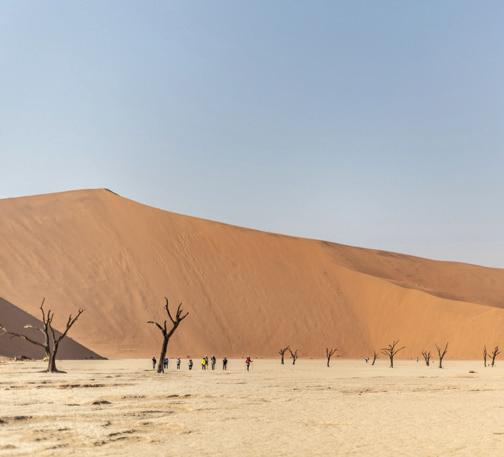
This is probably my fiftieth visit to this Namibian icon, but for my young son, it is a first. He waddles across the white clay surface in his characteristic one-year-old gait, stopping only to inspect cracks and rocks along the way. Finally he stumbles upon a camelthorn in his path. Up, up, up he looks at the giant tree, centuries older than him. It is well-known in the tourism industry that we do not sit or lean against these ancients. Explaining that to a baby is almost easier than trying to convince visiting tourists of the same. After snapping a quintessential photo of Luka and his first experiences of this
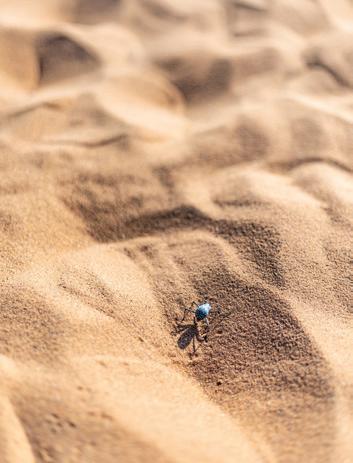
magical place for the memory book, we continue along in awe of the surrounding beauty. Whether it is a first or fiftieth visit, the wonder will always remain.
Back at Sesriem, after a quick visit to the nearby eponymous canyon, we order a cold beverage from the bar. Chilled glasses of draught appear before us as if by some desert voodoo. An ice-cold beer in the Namib is almost as iconic as Sossusvlei itself. A simple pleasure, but one that never tires. We play a guessing game as we listen to the loud group of tourists on the other side of the circular counter. “Is it Italian?” my husband whispers. “Or Russian?” I retort, our ears perking up. The truth lay somewhere in between – an Eastern European dialect that kept us guessing. The lilt and rhythm distinct, evoking the same sense of mystery that the desert had. We are just so happy to once again be surrounded by visitors from far-off lands. They were missed during the dry pandemic years. Their laughter adds to our collection that weaves together a magical memory of a weekend well-spent with family in beautiful places.
On our final morning we prepare for an early farewell, the sun making its majestic ascent over the dunes and mountains. It feels like a silent benediction, a golden seal on the mosaic of moments that had made this trip truly special. The journey back is reflective. Sossusvlei, with its vast landscapes and intimate moments, had offered an experience that was both monumental and deeply personal. From the tales of a chef and her mother’s culinary legacy to the awe-inspiring beauty of Deadvlei. From the simple joy of an ice-cold beer in the desert to the delightful puzzle of deciphering a foreign language, every moment had found its place in the tapestry of memories. As the dunes faded in the distance, I realised that truly special trips are not just about the destinations. They are about the moments, the experiences, and the stories that stay with you long after you have left the place behind. And along our journey south to Sossusvlei, I had found a treasure trove of them. TNN
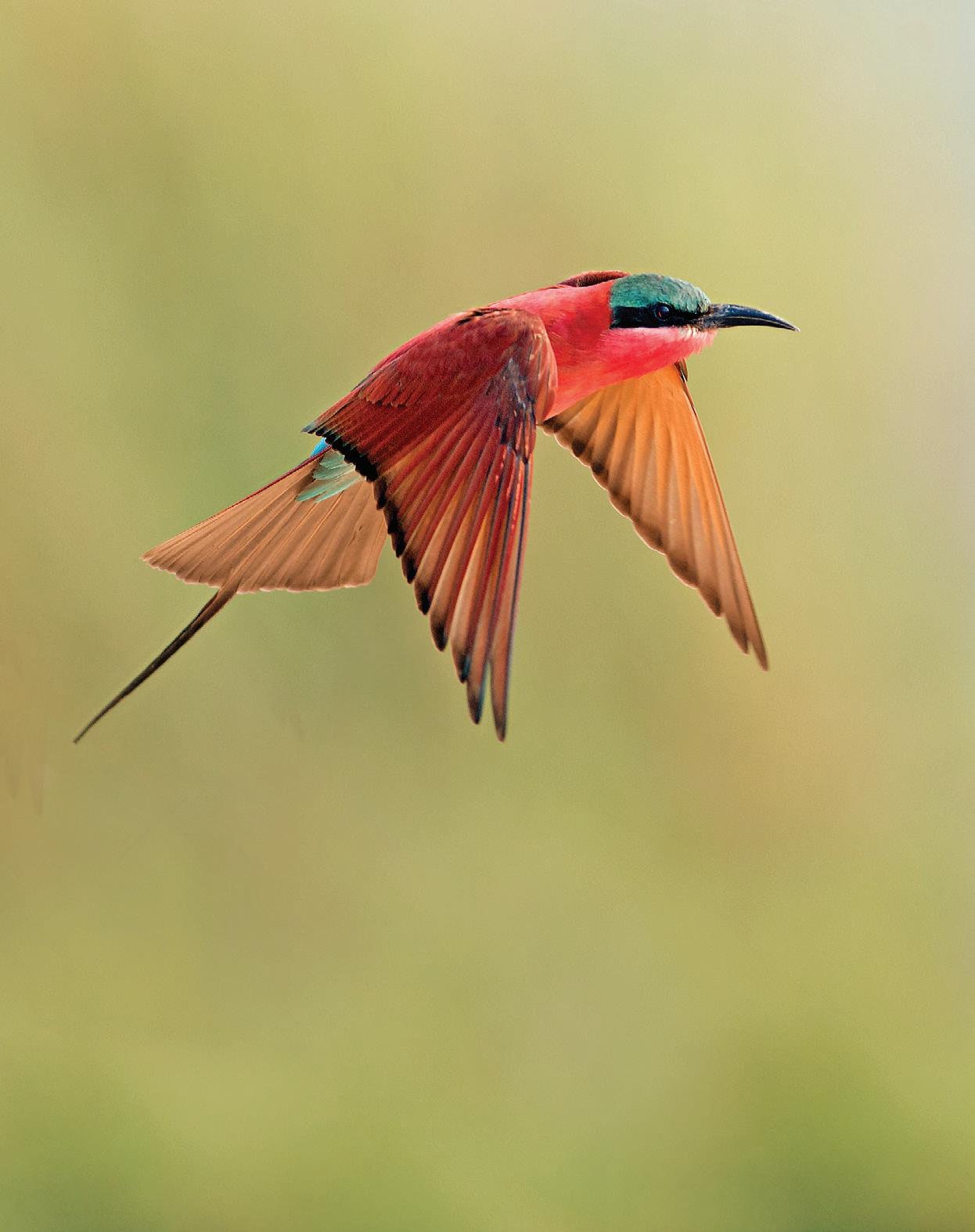


One of the specials in the area, the Western Banded Snake Eagle
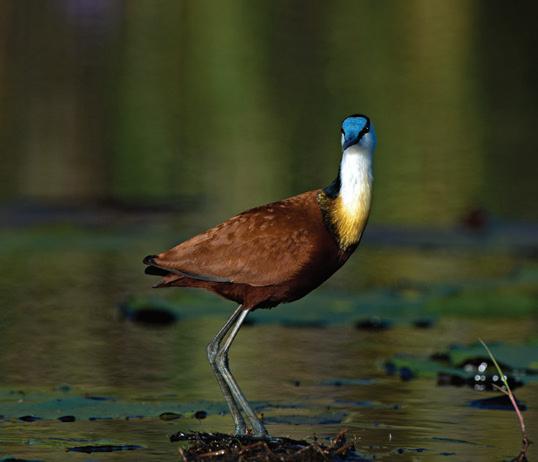
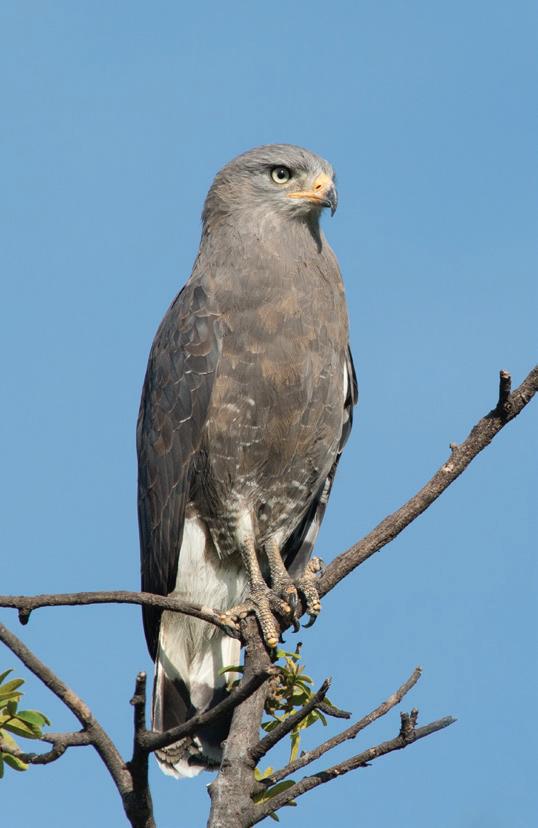
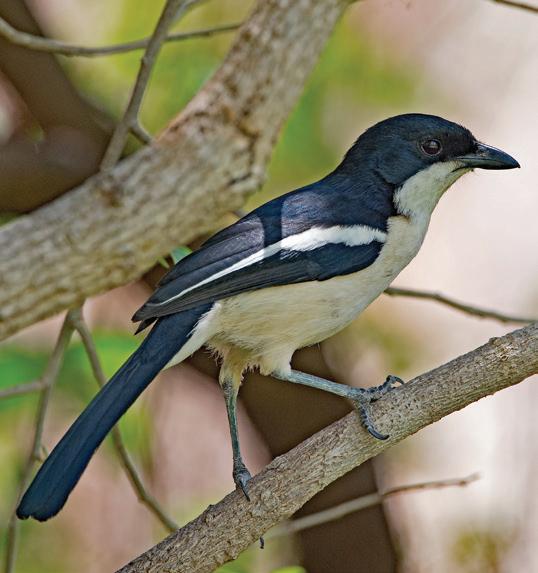


If you stay in bed too late, the Tropical Boubou will call youPurple Heron, a common river bird Pied Kingfisher
The essence of this journey is not about what we sip on or the vehicle we arrive in. It is about the mesmerising experience of birdwatching in the Zambezi Region – an experience second only to ultimate enlightenment. Remarkably, over 80% of Namibia's birds grace this region. So, if you seek authenticity, Kubu beckons. Answer the call and be part of this exhilarating escapade.
Without delving into the wonders of the lodge or the impeccable service, let me get straight to the heart of the matter: birding. Immersed in the beauty that straddles the riverbanks, and endowed with access to a mosaic of bird habitats, it is not far-fetched to say that the Zambezi Region is just a touch away from paradise.
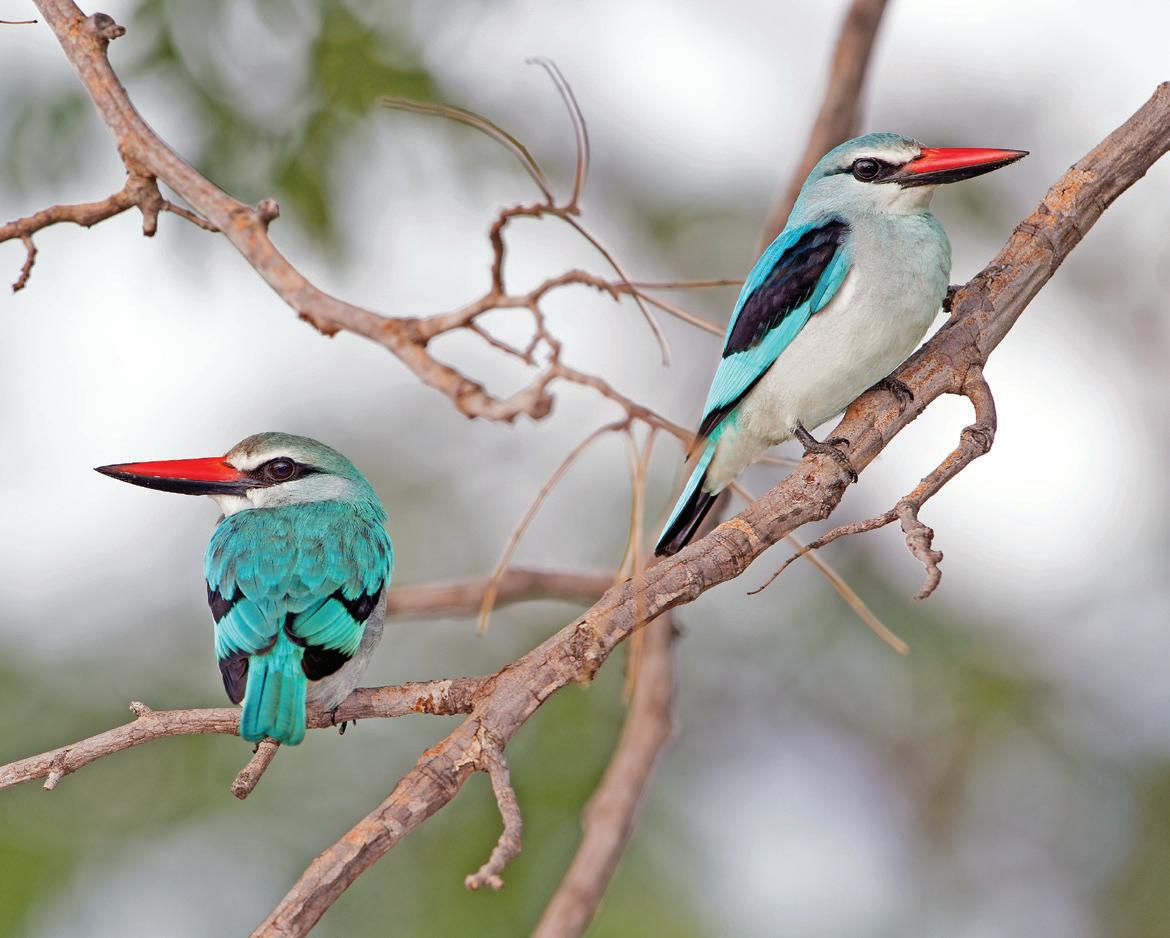
While the mystery remains as to why Johan invited me for a weekend birding gala (with my questionable oratory skills and self-admitted beginner status in bird knowledge), I am thrilled to embark on this journey. Fear not, for Adri Bruwer,
a renowned photographer, will fill in the blanks with her expertise. From talks to personal advice, she's got you covered. And for those keen on sharing their experiences, a discussion stage awaits.
As for me? I am your guide on this captivating journey. Johan envisions a comprehensive exploration of the region: from rivers to floodplains, forests to woodlands. And guess what? The deck of the lodge doubles up as a bird-watching sanctuary – perhaps with a G&T in hand, for the more spirited among us!
But there is more. A tech maestro will guide us through the latest in photography, ensuring you leave with more than just 'on-off' knowledge of your camera. And for the eager beavers, there might be some tempting deals on cutting-edge equipment. Additionally, a local bird expert will introduce us to the region's unique avian wonders, while a passionate environmentalist will capture the essence of the habitat.
 A certainty on a boat trip, the Malachite Kingfisher
A certainty on a boat trip, the Malachite Kingfisher
The birding experience here is transcendental. With diverse habitats, the variety of birds is simply breathtaking.
A camp special with its beautiful call at dusk and dawn, the Whitebrowed Bush Shrike
Just in time for the migrants like this Levaillant's Cuckoo
Now, here's a twist: Elzanne, the editor-in-chief of Travel News Namibia, is also gracing the occasion. Though my last trip with her had its "spirited" challenges, this promises to be different.
The birding experience here is transcendental. With diverse habitats, the variety of birds is simply breathtaking. From the elusive Black Coucal to the radiant Orange-breasted Bush Shrike and the iconic African Fish Eagle, the sights are aplenty. And if we are lucky, the rare African Crake might make an appearance.
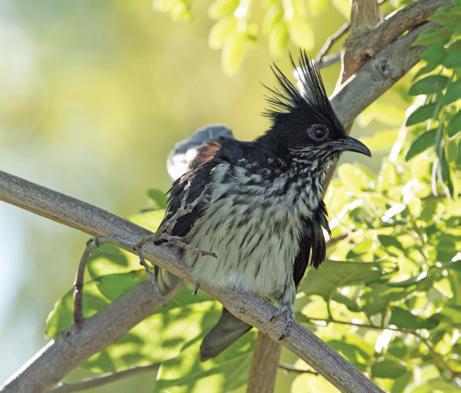

But if you ever feel the need for an adrenaline rush, the Carmine Bee-eater colony and the African Skimmer breeding grounds promise unforgettable experiences. Just a fair warning: the exhilaration might make it hard to return to the serenity of the lodge.
To sum it up: Meet the gracious Helga (the good), the unpredictable Elzanne (the bad), and, ahem, yours truly, your bird photography speaker for the weekend (the so-called ugly). Buckle up: the Zambezi awaits! TNN

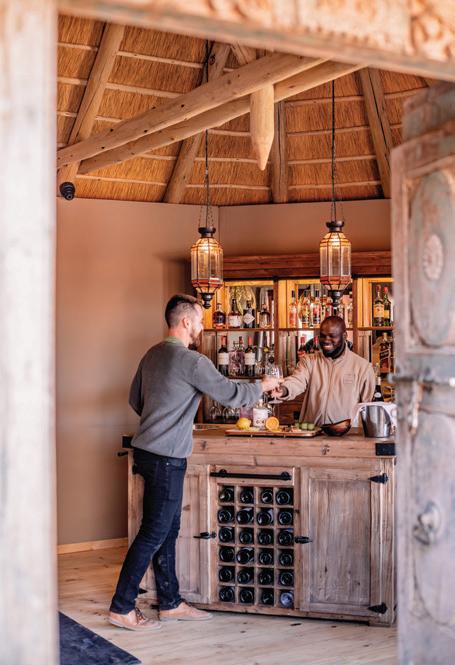


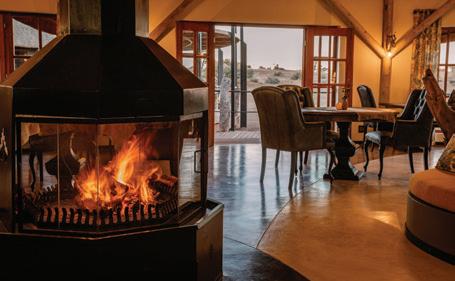



Few of our foreign visitors know that Namibia boasts not one, but two deserts within her borders. The unsung sister of the Namib Desert is the Kalahari, and they could not be more contrasting. Perhaps the only things they have in common are dunes and camelthorn trees, but the Kalahari deserves a rightful place on any traveller’s list for one overarching reason – its soul.
A few kilometres south of the small town of Kalkrand lies Ondili’s Kalahari Red Dunes Lodge. Back in 2008, this property was a productive sheep farm, like so many in its surroundings. While farming in any desert landscape is not for the faint of heart, the Kalahari gets its share of rainfall in the summer seasons, making for fields of golden grass and yellow blossoms dotting the camelthorn treetops. Since acquiring the property, Ondili has redefined the land use, establishing a classic safari lodge in a low-lying depression lined by the red dunes so synonymous with the Kalahari. They have since rewilded the area, reintroducing the plains game that play their part during spectacular nature drives. Yet the soul of a farmyard still hangs in the air, and is punctuated by subtle design elements.
you’re going to get, but you can bet it’ll be lovely. Velvet sofas, botanical paintings, thoughtful light fixtures and luxurious rugs are just a few of the elements guests can expect. Furthermore, the rounded walls, thatched roofs and expansive outdoor lounging areas make for a distinctly homely feeling associated with organic features.
For those feeling lavish, or travelling with company, the family and superior suites feature picturesque teardrop-shaped pools, amongst other luxury amenities. The layout of these suites prioritises lounging, with extensive sofas and daybeds in close proximity to the mini bar and coffee station.
When the sun sets, a golden glow transforms the shrubbery and grass blades into an impressionist painting. Kalahari sunsets stir a kind of magic, as if the red dunes radiate above the horizon and set alight the sky in a spectrum of warm hues. Peering between the classic camelthorn trees, as the sun dips and a springbok grazes, you cannot help but replay in your head the sounds of “Africa” by Toto.
The main area of Kalahari Red Dunes Lodge is where guests dine, relax by the fireside or take a dip in the swimming pool. The expansive thatched area overlooks a nearby waterhole, and just a little further, a classic red Kalahari dune. Central to this cosy space is a 360-degree bar fashioned from corrugated iron, a stone mosaic countertop and a nostalgic sheep enclosure gate. From here a wide selection of Namibian and other spirits can be ordered, the best of which is a Stillhouse Atlantic gin.
A sunken seating area beckons to be savoured with a good book, with a windowsill reading nook and fireplace nearby. Perhaps the magnum opus of the main area is the cigar and whisky lounge, oozing old-school charm with luxurious occasional chairs and a chess table.
Kalahari Red Dunes Lodge features 11 chalets, one family unit and one superior suite. Each of the suites features a completely unique layout and design, so being assigned a room is like a box of chocolates – you never know what
Kalahari Red Dunes Lodge mirrors the soulful landscape of the desert outside, with thoughtful farm-style touches and elevated luxury. Many hiking trails allow visitors to explore the area on foot and after a nature drive, sunset on a red dune with a Namibian gin is enough to restore the soul. TNN

Kalahari sunsets stir a kind of magic, as if the red dunes radiate above the horizon and set alight the sky in a spectrum of warm hues.

Small towns in Namibia have a special allure. They often exist as a result of some or other historical irony, consolidated from one generation to the next. Be it the central melting pot of rural life as in the case of Rundu, fruitful agriculture in its surroundings like Omaruru, or for a productive long-standing harbour like in Lüderitz – each tiny town develops a distinct character.
Because this country is jam-packed with noteworthy tourist destinations, it comes as no surprise that many small towns lie at an intersection. They exist entirely in their own commercial and cultural right, as well as being a stopover for travellers visiting said attractions. These, in my opinion, are the very best of tiny towns. Locals go about their business, and you, the visitor, get to taste a smattering of their existence. Tomorrow your journey continues elsewhere, and the town embarks on its everyday life as always.
Lüderitz is the designated destination for travellers wishing to visit the famed Kolmanskop ghost town. And while the sand-filled historic homes of Namibia’s first diamond tycoons remain an awe-inspiring sight, this small town has a whole lot more up its sleeve.

Turning the hands of time back to 1487, Portuguese explorer Bartolomeu Dias first laid eyes on the area and named it Angra Pequena (small bay), leaving his mark with a stone cross. Over the centuries that followed the region drew adventurers and scientists in search of minerals, but it was only in the early 19th century that Lüderitz truly found its calling as a bustling trading post. Whaling, seal hunting, fishing and guano-harvesting enterprises thrived on this section of the coast.
In 1883, a settlement officially took shape when Heinrich Vogelsang secured the land for Adolf Lüderitz, a German entrepreneur. The area was renamed Lüderitzbucht in his honour after his disappearance during an attempt to sail from the Orange River mouth back to his settlement. With the discovery of diamonds in 1908, Lüderitz experienced a dazzling boom, but fortunes changed as a result of WWI when Germany lost control of its colony in 1915, and South Africa took over. The diamond rush shifted southward, and the former significance of Lüderitz gradually waned. It became a quiet coastal town where echoes of its vibrant past linger to this day.
Lüderitz boasts several accommodation options, the most prominent being the Lüderitz Nest Hotel. Situated on the outskirts of town with great views of the Felsenkirche as well as the ocean, the Nest offers classic, comfortable rooms, a swimming pool and it serves a fantastic breakfast.
Krabbenhöft & Lampe makes for a unique self-catering stay in the centre of town. The building, now a national monument, was one of Lüderitz’s first trading houses. With wooden floors, high ceilings and ample character it is an authentic accommodation facility.


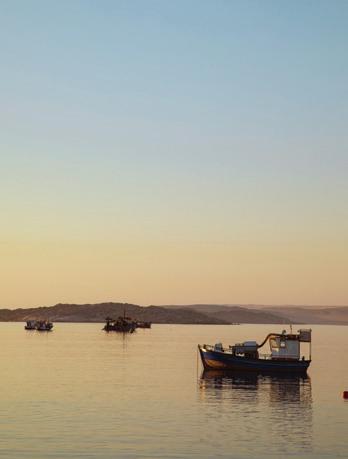


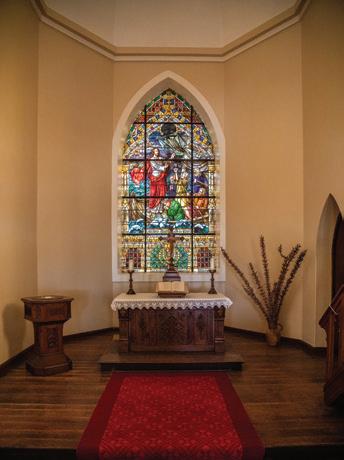
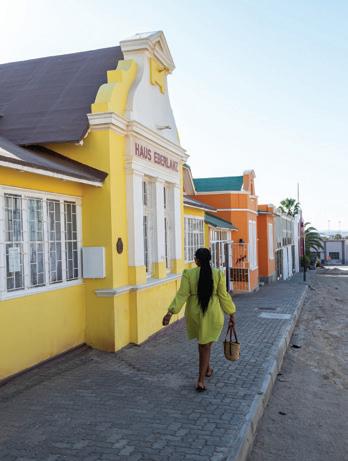

A big, fat perk of walking through Lüderitz is the architecture of bygone years that must be marvelled at from up close.
Kratzplatz, centrally located and also in a historic building, is a bed & breakfast. Quaint and quirky, the accommodation offers everything a guest might need, from WiFi to secure parking, while maintaining a laid-back, no frills kind of vibe.
Essenzeit is located at the Lüderitz waterfront with ample indoor and outdoor seating. Accompanied by a great view of the bay, the menu offers something for everyone, including pizza, burgers and breakfast. Enjoy an ice cold local beer and dive into the sensational seafood platter while admiring the monohulls and catamarans that bob calmly in the bay.
Diaz Coffee Shop is a great lunch spot, which serves wholesome and affordable dishes from toasted sandwiches to loaded fresh fish meals. The restaurant is divided into two sections, one with an old-school coffee shop atmosphere and the other decorated with authentic nautical paraphernalia like buoys, oyster cages and faded green rope. Try fresh oysters with Tabasco and a lemon wedge.
Portuguese Fisherman is a newer eatery, with sheltered outdoor seating and ample more inside perfectly suited to the windy, yet sunny town. The menu is limited, but this is just the place to tuck onto calamari and crayfish, paired with white wine and adorable marine-inspired decor.
Barrels is the local hang-out spot favoured for its nononsense menu of pizza and the chef’s special, which is a three-course dinner and always something different. Buchters, as the locals are fondly called, gather there for after-work drinks at the bar or around tables fashioned from wine barrels. The place is small and dimly lit, but consider this a pro rather than a con – it oozes atmosphere.
Getting the lay of the land is always an essential first step when visiting a new destination. Luckily, Lüderitz is very pedestrian-friendly. Almost everything is at a comfortable walking distance (small towns rock for this reason). After checking into your accommodation, I recommend embarking on a walking tour of the town to familiarise yourself with the shops and restaurants at your disposal. A big, fat perk of
walking through Lüderitz is the architecture of bygone years that must be marvelled at from up close. Most of the historic buildings' facades show the year when they were built. Otherwise, little information about their origins means you can colour in the picture with your imagination.
A short 25-minute drive takes you to the Lüderitz peninsula where a replica of the Diaz Cross stands sentinel over a rocky hill and the rough Atlantic crashing against its base. Climb the concrete steps to the top, take in the view and snap a picture with the cross. Be warned, it gets quite windy there! Once descended from the viewpoint, I recommend having a hot chocolate or tea at the Skip Skop coffee shop that overlooks the quirky campsites on the peninsula. A lighthouse with classic red and white stripes completes the picture.
Local stakeholders in the tourism industry recently erected a brightly coloured LÜDERITZ sign, inviting visitors to grab a few Insta-worthy pictures. Concrete letters in technicolour hues are cast on a low wall, with the perfect backdrop of the calm waters of the bay and harbour. Not only is this a great place to mark your visit to the Bucht, but locals have adopted it as their designated sunset spot. Grab a few refreshing drinks from a shop in town and sign off a day in Lüderitz while gazing across the ocean.

Essential to the Lüderitz skyline and any visitor’s itinerary is the Felsenkirche, completed in 1912. Translated from German the name means rock church. The Felsenkirche’s doors open for visitors at 5pm, just in time for a ray of sunlight to strike the beautiful stained-glass windows and illuminate the church in a mosaic of colour. Old-school wood benches and a classic domed altar complete the experience. Religious or not, it is something truly spectacular.
Last, but certainly not least: Kolmanskop. The appeal of Lüderitz’s rich history is tethered to the rise and fall of this settlement, which sprung up after the first diamond was discovered in the vicinity in 1908 by railway worker Zacharia Lewala. Kolmanskop was created out of the dust. Wealthy residents enjoyed amenities like a ballroom, power station, an ice factory and a hospital which boasted the first X-ray equipment in the southern hemisphere. The now eerily empty and dune-filled buildings can be explored at your leisure, or with a guide. TNN
Scheduled Guided Tours / Fly-in Safaris: A scheduled approach, without compromising on a uniquely personal experience

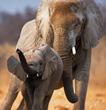

Private Guided Tours: An expertly planned itinerary to explore our country
Special Interest: For travellers looking for a more focused itinerary centered around a unique passion or interest
Mobile Camping: A comfortable tented camp set up with a touch of adventure, where guests spend their evenings around a campfire under the stars
Adventure Travel: A Namibian experience off the beaten track, offering guests insight into little known tour and safari highlights
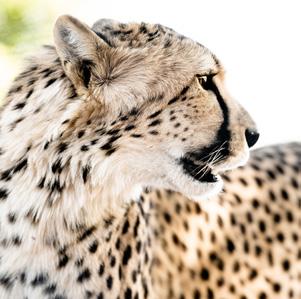
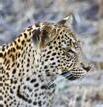

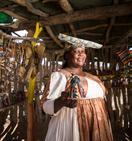


Our Fleet: We own and operate our fleet of vehicles designed and custom-built to suit the Namibian road conditions
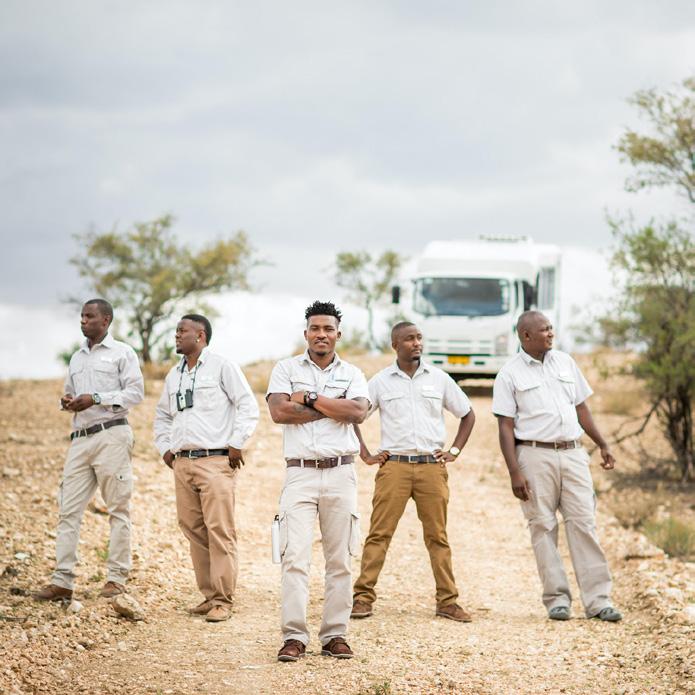
Business-to-Business (B2B) solution: Real-time availability and rates for accommodation and tourism products
Self-Drive Travel: On the road to discovering Namibia’s many secrets. We will accommodate your requirements.
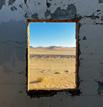

Accommodation & Car Rental: From luxurious, comfortable or budget-conscious, we have what you are looking for
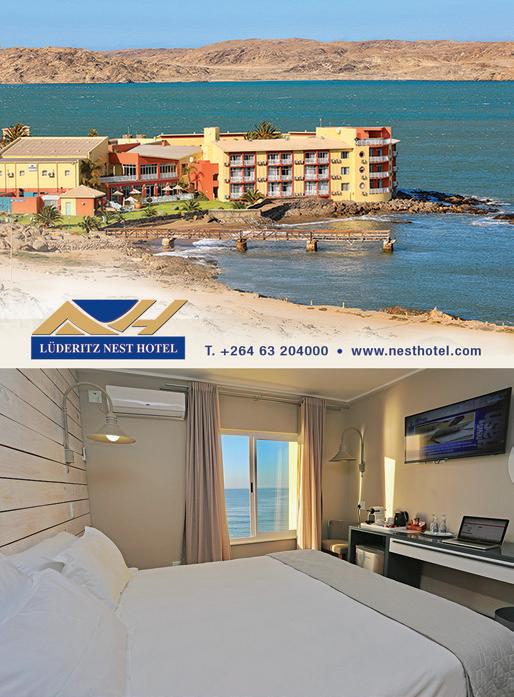
Linger Longer: Stay for 3 nights, pay for 2
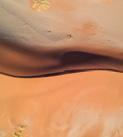


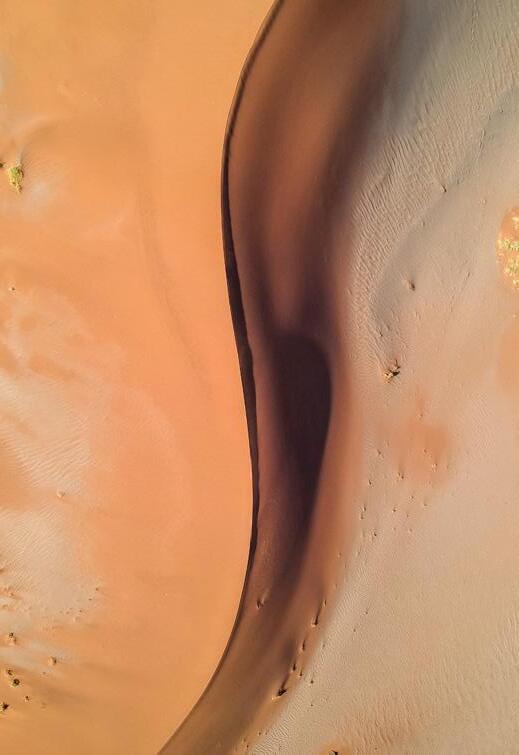
Introducing This is Namibia - Experiences, curating bespoke and captivating tours across the breathtaking landscapes of Namibia. Immerse yourself in our carefully crafted or personalised itineraries that blend adventure, luxury, and exploration. Discover the stories, people and places that promise a truly unique and enriching experience of this mesmerising country.
www.thisisnamibia.com
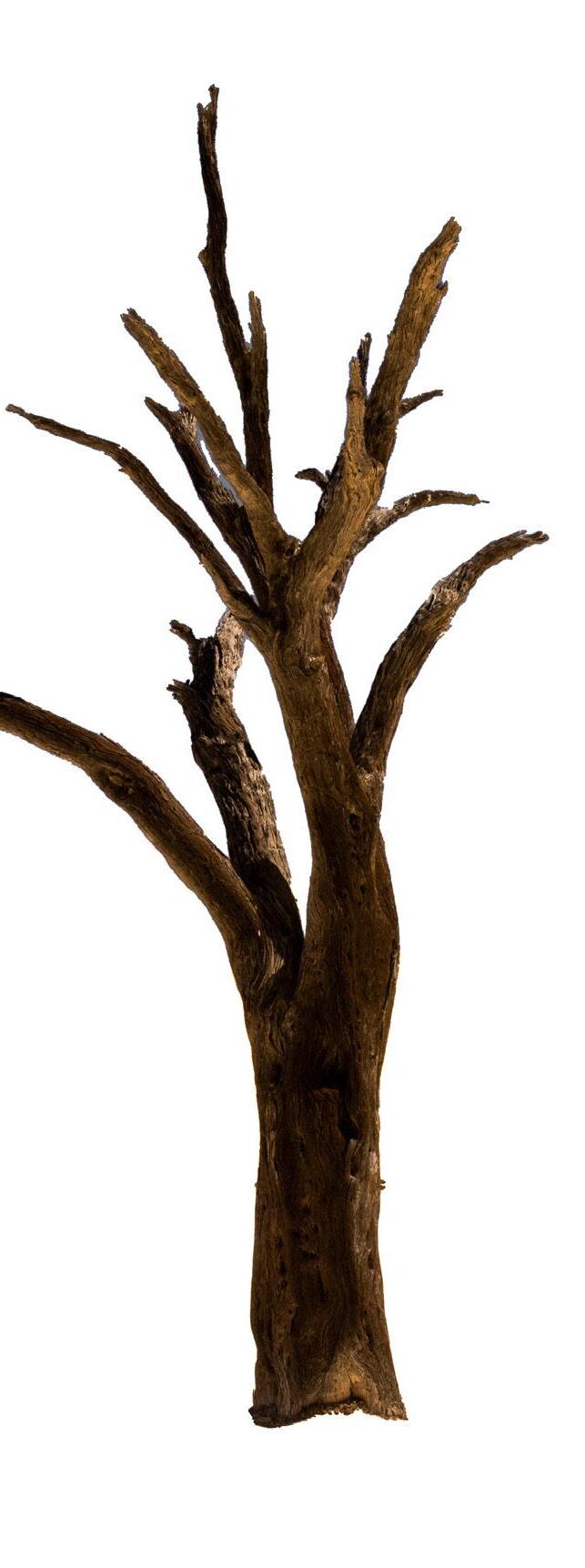
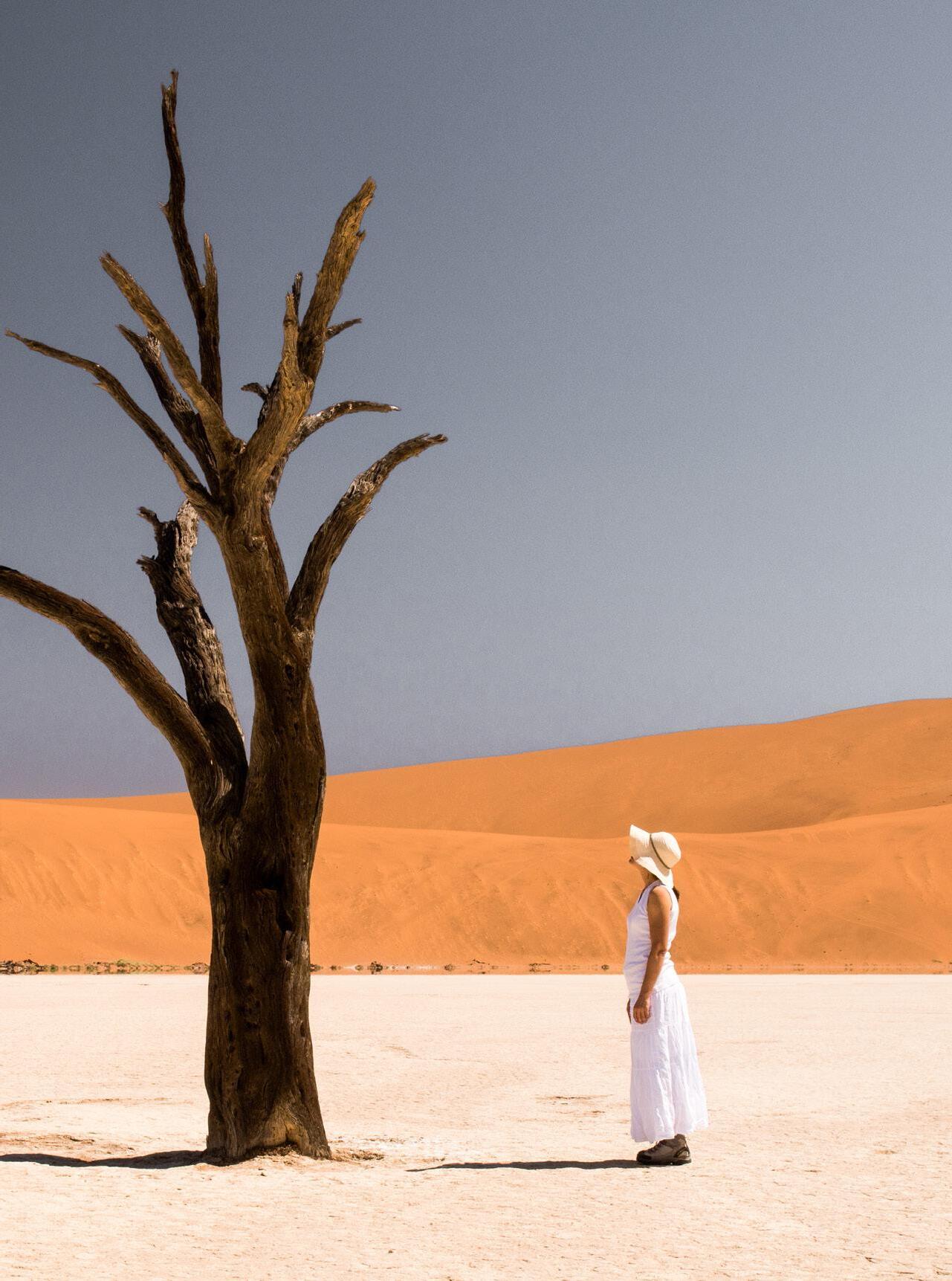

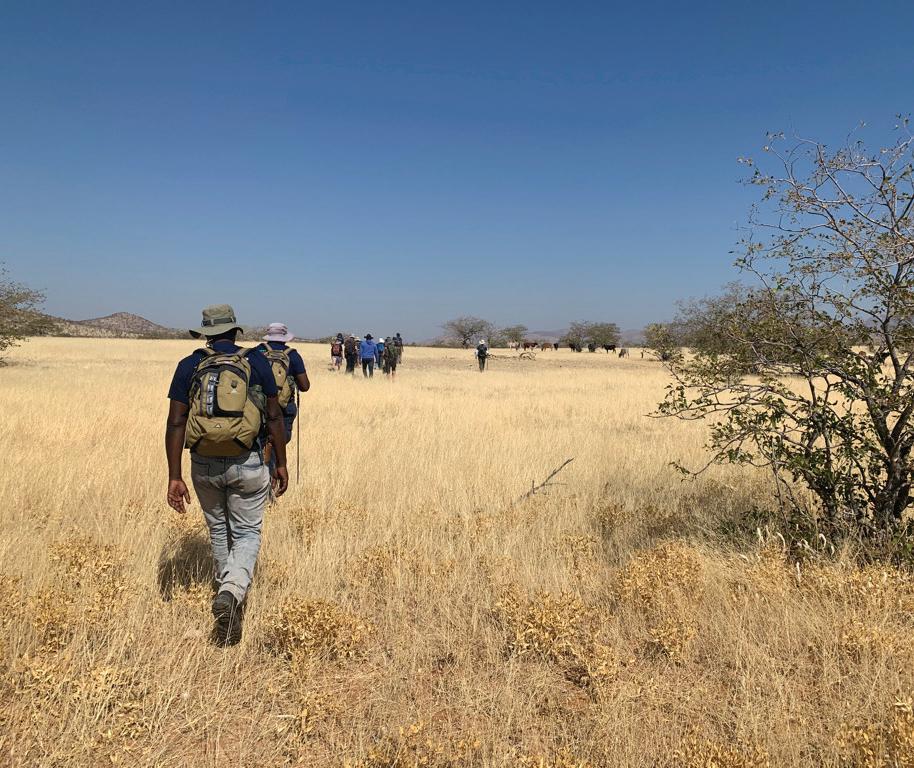
At 3 am on a Friday night I find myself sitting around the fire with a Tanzanian specialforces-trained anti-poaching game ranger, armed with his 375 H&H Magnum. I needed to get warm after a few hours of fitful sleep on the open back of a Land Cruiser. Its hard metal floor was not the most comfortable. Thankfully a Masai ranger had lent me his cloth which I had wrapped around myself to keep warm. We had left our camp at the Randilen Wildlife Management Area after a busy day, at 8 pm. The drive – “only 30 km”, said Kateko, the ranger from the Honeyguide Foundation – took just over three hours. We passed four young Masai men on the track, in the dark, robed in their bright red cloths and armed with their spears. They were off to find some girls, and a beer, evidently. It was a Friday night after all. Living within a wildlife management area with free-roaming elephants, lions and hyenas does not stop a teenager’s needs, it seems.
After many hours of dusty bumpy roads, passing dense bush, open veld, crops and tiny sleepy villages, we finally arrived in a village that was still awake, due to the shebeen in the middle of it. We all decided that a beer had been earned, even though there were only warm ones available. This time the “almost there” and “only 5 km” turned out to be true, and we found our camp in the middle of crop fields. The camp, if one could call it that, was a water point with a properly constructed elephant-proof tank and borehole system, surrounded by thorn tree branches. This is where the community game guards and trained rangers kept a 24-hour watch over the community’s crops. A fire at night kept them warm. A tarpaulin flung over a branch kept them dry if it rained. Tree stumps were sat on. Some raggedy dogs kept a vigil nearby. This was also where members of the community came to fetch water every morning, and so it was in effect the central communication hub of the area. Twitter rural African style. Information was shared that elephants had been chased away the previous night, which usually happens every night, so we started our wait in anticipation.

Earlier that day our group of Namibian community game guards had been briefed by a group of Masai rangers on the strategies that they have devised over the years to hold elephants at bay. My assumption was that their job was to chase these big grey things out of the crops. Wrong. What we learnt was that they were actually training the elephants. A series of intensifying techniques were applied, from lights to sounds and chilli bombs to the biggest Chinese fireworks one can buy. Eventually, like Pavlov’s dog, the elephants knew that if they didn’t listen to the lights, they would get the sounds – a horrible vuvuzela horn type of blasting. If they didn’t listen to that, they would get chilli bombs thrown at them, after which scary fireworks would be launched. Basically, if they didn’t listen, things would escalate to becoming decidedly uncomfortable – the most severe being a shot on the rump. Next time, to avoid this slightly sore shot, placed perfectly by a specially trained anti-poacher so as not to actually harm the elephant in any significant way, the elephant will remember to run at the sight and sound of the lights and horns. Conditional training at its best. This was after all part of the conservation cycle. By mitigating human-elephant conflict, elephants are preserved while at the same time communities are protected. No one wants the elephants hurt, people just don’t want to share their hard-toiled crops with them.
 Text Nina Mensing
Text Nina Mensing





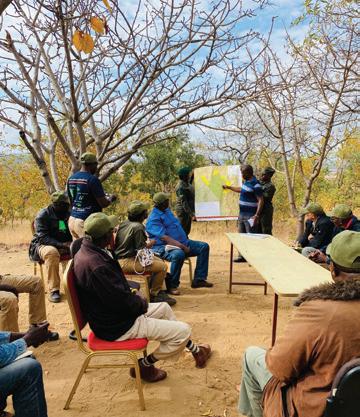


In this fertile area, the elephants weren’t exactly hungry either, crop raiding was just a fun activity for easy pickings. Much like what those young Masai men were hoping for on a Friday night out on the town, or village, more specifically. Various stories of elephants in the area recognising the rangers’ vehicles, even in other areas, highlighted their association of “uh oh, here comes trouble”. Like naughty teenagers, they would run off with a flick of their tails, not wanting to be chilli-bombed again. More often than not just the strobe lights would make them turn away for quieter pastures, in other words, back to the bush. However, consistency is the key, as any break in the link will be sniffed out as a great opportunity for some freshly grown tasty mielies. This meant 24-hour watch stations, a phenomenal interlinked communications system throughout all the communities, and quite often an escalation in techniques if they tested the system. Again, who said elephants were not like the average teenager?
Within 20 minutes a call came through – elephants had made it right onto nearby crops. Possibly because it was a weekend evening, with most people at the shebeen, they had not been spotted in time to be chased away. Like a South African rapid response security team, we all jumped onto the back of two vehicles and raced off. Even the horns were sounding, like a police siren, to alert the elephants that we were on our way. That would hopefully chase them off immediately. But these ones were stubborn and taking chances. Or they were a new herd who didn’t know the drill. Somehow, in the dark, with assistance from the community racing around on their bikes keeping watch, in the middle of a large dusty mielie field, three elephants were found hiding in some bushes. And so the chase began. They needed to learn the lesson that raiding crops was not worth it for them. Strobe lights were shone at them and the horn was blasting. As they ran off we gave chase, bumping over the field as only a Land Cruiser can. The rangers on the back shouting directions to the driver, who could only see dust and dry mielies in front of him. The specially trained ranger lifted his shotgun and placed a perfectly positioned small calibre bullet on the rump of one of the rapidly disappearing elephants. The association of the sting on his rump and the lights and sounds will make him react to just the lights and sounds the next time. Chilli bombs and firecrackers were not used, due to distance, speed, dry crops and the elephants already being right in the middle of the field. The intense few minutes of chasing three large elephants out of these fields left us covered in dust and pumping with adrenaline.
Later that evening, another alert came in. This time the rangers around our fire could hear elephants approaching. To be honest, I could hear nothing except for the crackling of the fire. But sure enough, a small herd of elephants was nearby, approaching the field. This time shining the strobe light in their direction and sounding the horn got them turning tail and heading back into the bush. These ones clearly remembered that if they didn’t leave, more uncomfortable methods would be employed.
Our group of Kunene community game guards, volunteers, NGO leaders, councillors, traditional leaders and chiefs, had
been invited to Tanzania by the Honeyguide Foundation. IRDNC Executive Director John Kasaona had met them at the first Africa Protected Area Congress in Rwanda in July 2022. He had told them about his program, the Kunene Elephant Walk, that he had recently founded. This project was training community game guards in the arid Kunene Region of northwestern Namibia to assist communities with humanelephant conflict. The strategies learnt in Tanzania, adjusted to the context of the arid Kunene region and desert-adapted elephants, will now be piloted in the eleven conservancies that the project covers. The Integrated Rural Development and Nature Conservation (IRDNC) project was founded in the early 1980s by the late Garth Owen-Smith. Under him, communitybased conservation was pioneered. Today Namibia is a world leader in this field. However, due to the success of communitybased conservation the numbers of free roaming key species in this area are rising, and in turn human-wildlife conflict is now on the increase.,. This is a focal point for the Kunene Elephant Walk, IRDNC’s newest project.
John Kasaona started the Kunene Elephant Walk project in 2020. Throughout his years as a conservationist under Garth Owen-Smith and later as the Executive Director of IRDNC, John had seen a need for community game guards in the Kunene Region to mitigate human-elephant conflict. The desert-adapted elephants of this arid region are often in conflict with communities over water resources. Elephant-proof water tanks and dams have been built, where elephants can still access water but not destroy these facilities that supply the communities and their livestock. However, since the recent years of extended drought in the region, communities have attempted to supplement their food resources by growing crops in community gardens. These have often been raided by the elephants, causing conflict. But since these desert elephants are a tourist attraction, they themselves are a valuable resource to the local communities. Elephants are also iconic to the region, and there is a sense of ownership and pride of the free-roaming herds of desert elephants. In order to adhere to the community-based conservation principles, this project is training community game guards, while also bringing adventure tourism into the area. An annual five-day hike of 150 km through five conservancies introduces participants to areas completely off the tourist tracks. This hike also familiarises hikers with the everyday life of a community game guard, walking many kilometres every day through rough, arid, yet beautiful terrain, in order to support the communities in their conservancies. A Mongolian ecology organisation, Rally for Rangers, , recently organised a motorbike rally through the Kunene. After the rally an event was held at Twyfelfontein Country Lodge where the 15 Yamaha AG150 bikes were donated to the community game guards, enabling them to respond to human-elephant conflict more timeously. Environmental education programs and tourism projects are being planned for the near future. The Tanzanian training trip gave the organisation and the community game guards not only the necessary skills, but also the motivation to continue with their often challenging work in the Eden that is the Koakoveld of the Kunene Region. TNN
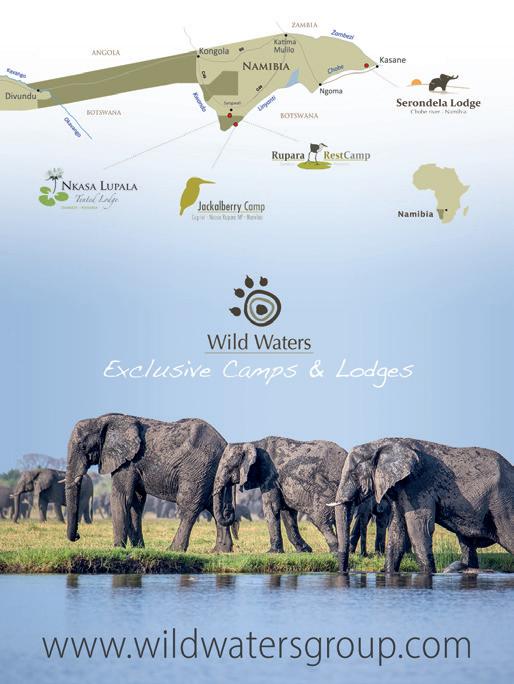
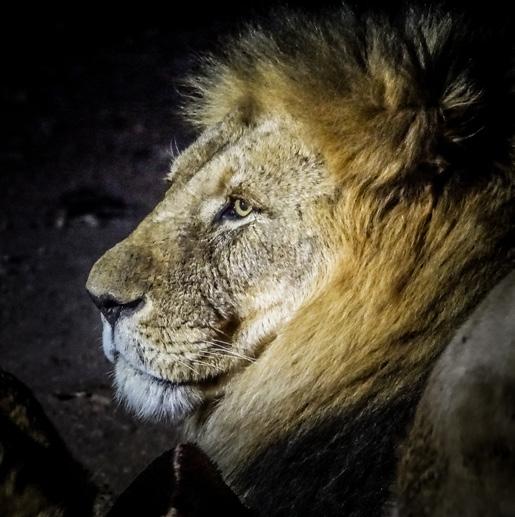



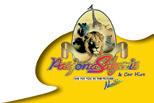
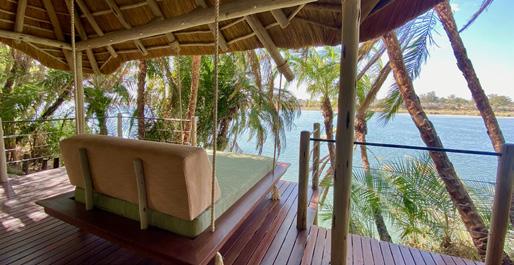


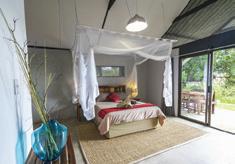
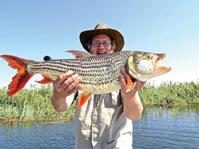
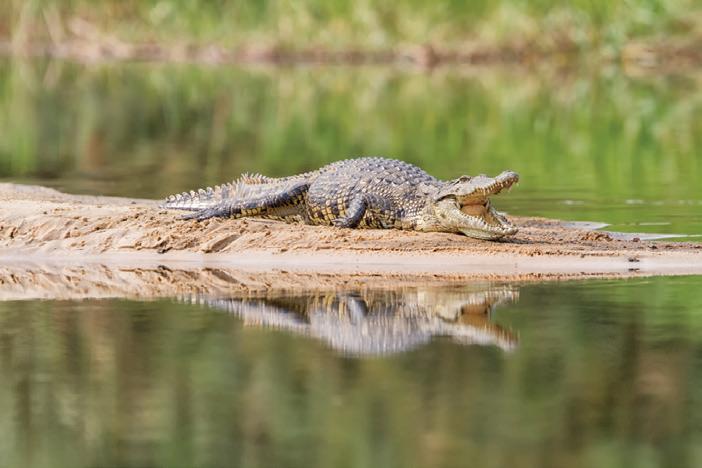

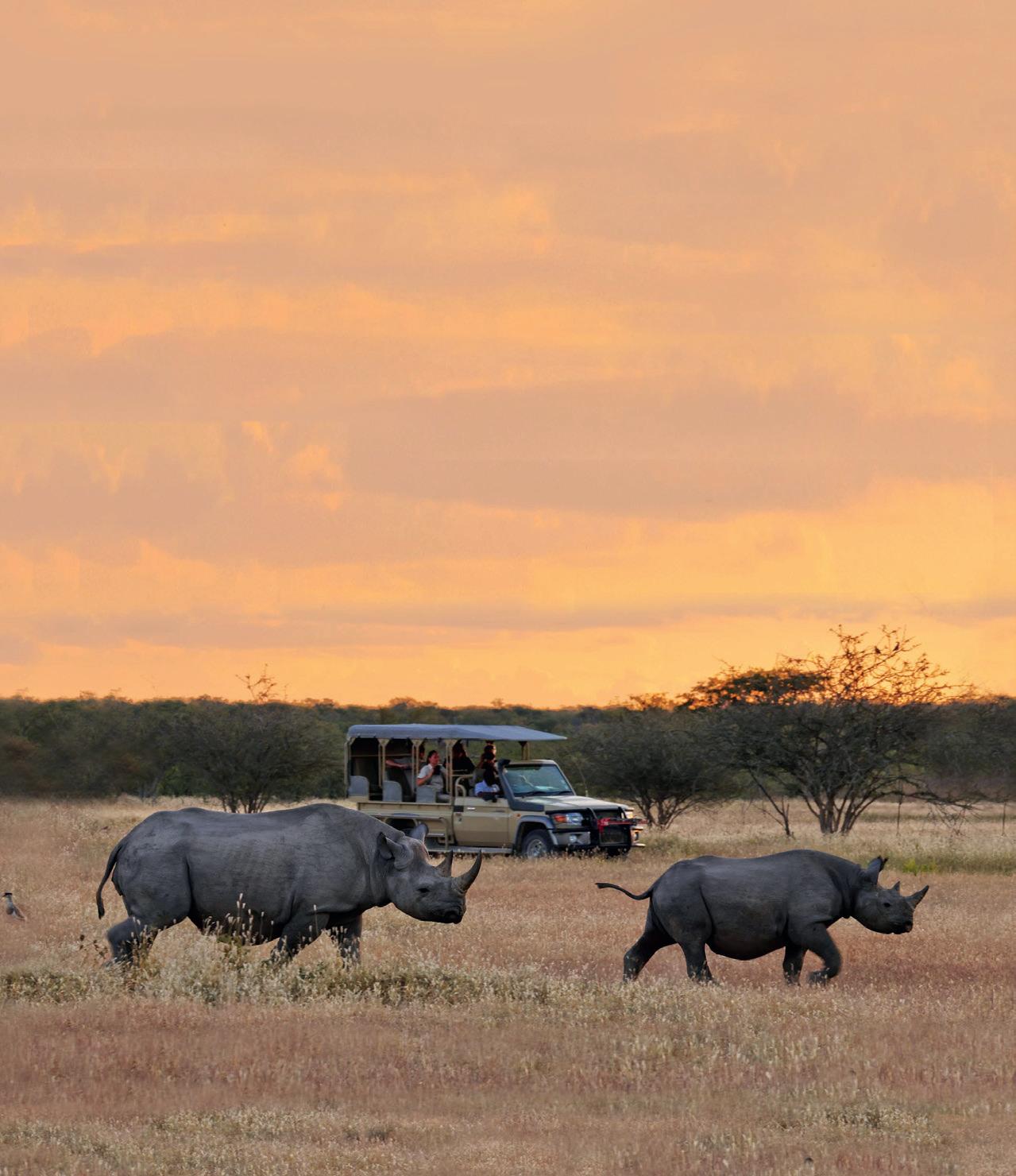

Let FlyNamibia help you discover many different destinations. the wonders of Namibia, connecting you with
